



Face to facebook is the final project in a three part series named “Tha Hacking Monopolism Triology” by the two Italian artists Paolo Cirio and Alessandro Ludovico. It was launched on the 2nd February 2011, with a mixed media installation at the Transmediale festival in Berlin, and a press release announcing a new dating website called lovely-faces.com.
The set-up for the ‘Face to facebook’ project was to steal 1 million facebook profiles and re-contextualize them on a custom made dating website (lovely-faces.com). The data collected from the profiles was only information available publicly on the internet, like the users name and profile picture. No facebook account was needed to access it. The 1 million facebook profile pictures were then checked for images that were usable in a dating webstie context. The remaining 250,000 profile pictures were then fed through various face recognition filters to assign an assumed personality to the subjects and a new profile was created ready for the dating website. Once published on lovely-faces.com, interested pursuers could get in contact with the people behind the original facebook profiles through facebook messages.

On the 10th February, 8 days after its launch, the dating website lovely-faces.com was shut down. This was following a cease and decease letter from Facebook[1]. Back in 1999, the net artist Heath Bunting was also subject to a cease and decease letter, that time from American Express. The letter sent to Paolo Cirio and Alessandro Ludovico in 2011 (as PDF) can be seen here, and the letter sent to Heath Bunting in 1999 is published here.
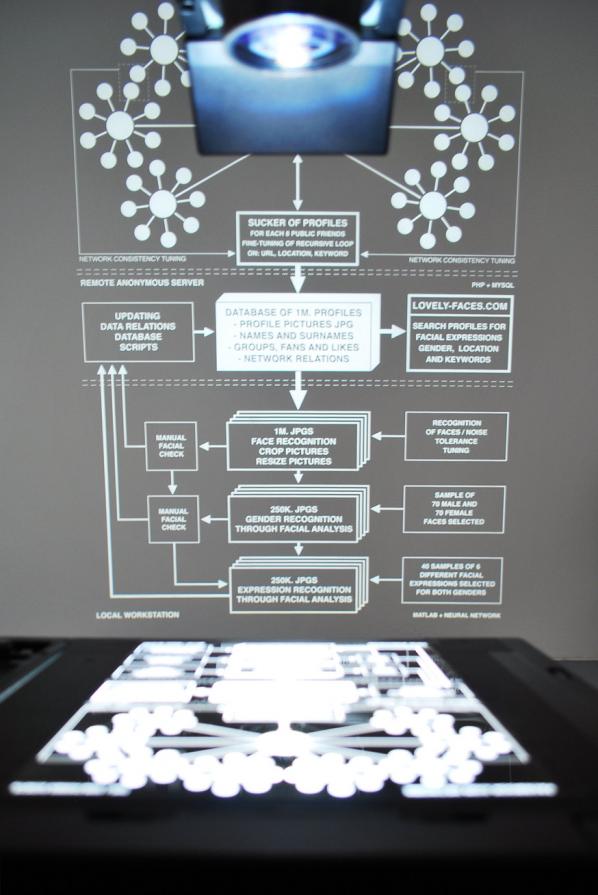
This project, and the ripples it left on the media water, highlights an ambiguous relationship many have with facebook. Many people sign up, upload a smiling profile picture of themselves and declare personal details to the large corporation that is Facebook without concern. Not until these identities and personal images were scavenged and then reused, the ownership and potential audience of this personal data is questioned. As the artists state themselves: “The final step is to be aware that almost everything posted online can have a different life if simply recontextualized. “
“The process is always illustrated in a diagram that shows the main directions and processes under which the software has been developed. We found a significant conceptual hole in all of these corporate systems and we used it to expose the fragility of their omnipotent commercial and marketing strategies. In fact all these corporations established a monopoly in their respective sectors (Google, search engine; Amazon, book selling; Facebook, social media), but despite that their self-protective strategies are not infallible. And we have been successful in demonstrating this.”
Web 2.0 Suicide machine (http://suicidemachine.org/) is another project which deals with your online identity. It allows you to automatically delete all your social network profiles and it simplifies the process – according to their website 8.5h quick then a manual deletion. Incidentially, the facebook is not one of the profiles subject to deletion in the suicide machine anymore, following another cease and decease letter: http://suicidemachine.org/download/Web_2.0_Suicide_Machine.pdf.
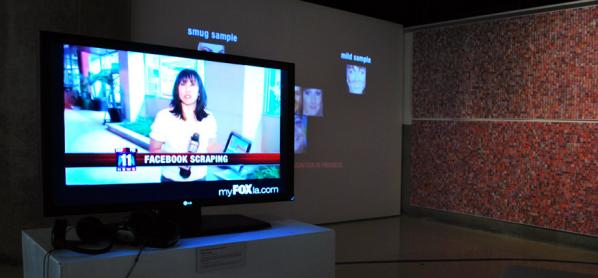
Since the lovely-faces.com dating website is still closed down, the project now (September 2011) consists of: documentation of the process used to acquire the facebook profiles; documentation of the global mass media hack performance, in the form of news broadcasts, magazine articles and blog post referring to the project; legal correspondence between the lawyers of the artists and Facebook; a mixed media installation; a touring lecture given by the authors. The latter two being re-performed and installed in various venues around Europe and beyond. The former are all available on the website face-to-facebook.net
The ever changing nature of this project therefore makes it a great example of a piece of contemporary art of variable nature, one which is in constant flux and is formed by the cultural, networked and physical landscape surrounding it. It does not only challenge the ownership of your online identity, it is also a nuisance for a mainstream contemporary art market based on institutional preservation and commercial commodification. These disruptions may also be linked. On the one hand there is an action to copy a system collecting and commodfying people and then use them as assets in one’s art expression and experience. “In all the three projects, the theft is not used to generate money at all, or for personal economic advantage, but only to twist the stolen data or knowledge against the respective corporations.” And then on the other hand, it is an art project which is not straightforward to see what the remaining artefacts actually are, whilst defying the process of being added to traditional art collections.
Other Info:
The Hacking Monopolism Trilogy. Face to Facebook is the third work in a series that began with Google Will Eat Itself and Amazon Noir. http://www.face-to-facebook.net/hacking-monopolism-trilogy.php
Elin Ahlberg is studying Art and Visual culture at the University of the West of England in Bristol. She has been living in the UK, and Bristol, since her move from Sweden in 2006. As an artist, she works in a variety of mediums and produces work which aims to both amuse and provoke. Her practice and research is informed by quasi-anthropological observations and an interest in technology. “One year ago I gave up Facebook for lent. It was quite an interesting experiment and I realised how integrated my life was with the social networking website as I actually felt that I missed out on things.” Ahlberg’s essay Meanings constructed around Facebook can be found here http://elinahlberg.wordpress.com/2011/07/18/essay-meanings-constructed-around-facebook-2011/
Featured image: Remixthebook Cover
“For us, art is not an end in itself … but it is an
opportunity for the true perception and criticism
of the times we live in.” Hugo Ball.
The challenge in trying to review a book like Mark Amerika’s Remixthebook, is the feeling you can only do justice to the text by doing the same with your review. The apparent simplicity coupled with the multifarious outcomes are intoxicating. You could be mistaken for believing that every possible remix would produce fresh and exciting outcomes. The key of course, is to have good source material in the first place. Also, to have developed a keen eye for what blends and meshes together and what doesn’t. Even the most disparate work requires judgment and prior awareness. Remixthebook asks us to consider the idea of remixology as part of the work of modern artists. The tone and style of the book is a blend of ideas, voices and thoughts with a myriad of concepts, which attempts be the very embodiment of the ideas it espouses.
Amerika explores various precedents for the remixological concept and draws on some known practitioners from the past: amongst them, Allen Ginsberg, William S. Burroughs and Brion Gysin. He explores existing ideas and welds them into his own armoury. Their ideas considered as part of his own creative practice, brought back to the now with new life, in our contemporary networked culture.
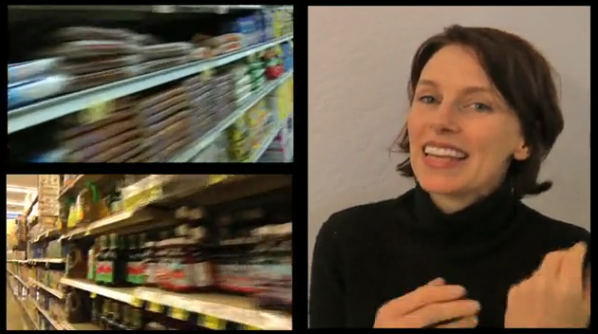
Other than just being a systematic breakdown of the different types of remixing and their potential outputs (or artifacts, as they might be better known in an art critical framework?) Amerika considers the pathways and theoretical underpinnings of remix culture. Having taken this beyond his own practice of the written word and web-based projects, he considers his recent and ongoing VJ work. Blending and collage-making with images during live music performances suggests some of the instinctive, instantaneous ideas that come out of a lifetime’s collecting, collating and absorbing of diverse imagery, words and cultural concepts. It’s within this process that he believes more novel outcomes can arise, against the constant flux of media creation and dissemination. It is the ‘becoming’ of the media artist that is revealed in the live remixing performance.
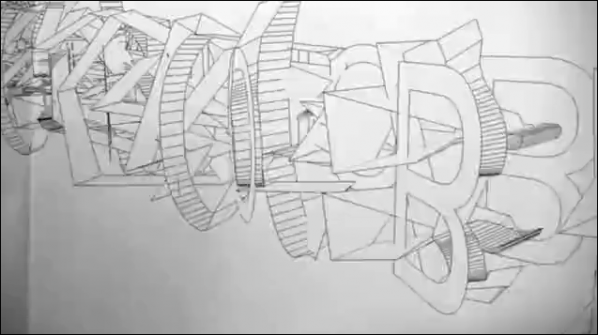
Reflecting on this process of cultural assimilation Mark Amerika, situates remixology within a wider creative output and theoretical framework. This involves a cross hybrid of everyday, mainstream references with high art and ‘high’ theory, all written in his at once complex and convoluted, yet easily read and enjoyable writing style. But like remixology, what looks simple is the result of deep reading and heavy conceptual thinking. This isn’t to say that you won’t have trouble decoding the writing and getting to the heart of his thinking, but it helps if you spend time with the text and allow the rhythms and structures to become second nature to you. Close reading allows the text to fall into place. For example, consider the following extract from the section eros intensification:
Here is where we enter the realm of
what I have been calling intersubjective jamming
which is different than the idea of a Networked Author
or Collaborative Groupthink Mentality that preys
on the lifestyles of the Source Material Rich
and seemingly forever Almost Famous.
It is worth remembering that Mark Amerika is a creative writer first and foremost. He uses theory as a palette from which to draw out ideas and situations for further reflection and to help give some context to the point he is trying to make. The text of remixthebook is an example of his creative practice in action, as much as it is a personal reflection on his attempts to develop a thought process for it. Theory becomes entwined in critical reflection and creative output. You don’t necessarily come to remixthebook for philosophical answers and hard academic points of view, instead you ride the maelstrom of thoughts and conceptualizing to gain a better handle on a way of considering artistic practice.
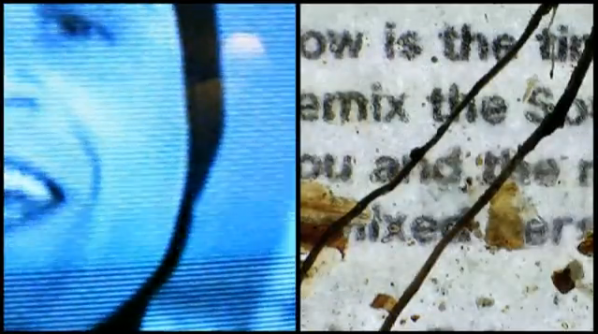
The website of the book (probably a ubiquitous extra for any media art-related publication these days) follows a natural path of inclusion and invites artists to take sections of the book and remix them according to their own aesthetic and remixological preferences. While some of the work brings in extra visuals and places itself in a flowing context of media streams, allowing different work to become part of the project, Rick Silva’s The Isarithm sources Amerika’s Sentences on Remixology 1.0 and explodes them out of the screen and into a layered and playful vortex of shapes and lines.
Will Leurs uses some captured footage taken directly off the tv screen for A Pixel and Glitch Hotel Room and combines it with some source material supplied by Amerika from several ‘lectures’ he has supplied. These lectures appear within several other contributors work as well. The point of some of these remixes and the varied forms they take (the collection includes some purely audio work) is that, as well as being interesting works themselves, they are exemplars and guides to even further potentials of the remixological principle.
Mark Amerika’s Remixthebook at times may leave you looking beyond it to the appendix or for any footnotes that would fill out spaces or help make conceptual leaps for you. That isn’t the point of the book. The idea is to take the book as a starting point and expand on your own creative process. Possibly the best approach is to literally cut-up the book and try some experimentation of your own, Brion Gysin style. Flex the covers back and pull out the pages. Through destruction and reconfiguration, the book might be bent to your will and become something that you can use. Perhaps the sight of a ripped and destroyed book would strike horror into some authors. I can’t help thinking that Mark Amerika would take great joy in the image and say that he’d planned it all along.
The remixthebook.com website
http://www.remixthebook.com
The remixthebook Blog
http://www.remixthebook.com/theblog
Remixology by OpenMedia.ca – a national, non-partisan, non-profit organization working to advance and support an open and innovative communications system in Canada.
http://openmedia.ca/remixology
Society of the Spectale (A Digital Remix)
By Mark Amerika On August 16, 2011.
http://www.remixthebook.com/society-of-the-spectale-a-digital-remix
REMIXTAPE 2.0 //
Remixology is a music blog based in Paris (France) devoted to remixes friendly music.
http://remixology.tumblr.com/
REFF- Remix the world! Reinvent reality! exhibition at Furtherfield Gallery between 25 February and 26 March 2011. http://www.furtherfield.org/exhibitions/reff-remix-world-reinvent-reality
Visitorsstudio – an online place for real-time, multi-user mixing, remixing, collaborative creation, many to many dialogue and networked performance and play.
http://www.visitorsstudio.org/x.html
Brion Gysin. Essays & Stories, Interviews, Excerpts & Publications
http://briongysin.com
“You Are Now the Electronic Man” are the words that appear before even opening the website for The Electronic Man, a project initiated by Salvatore Iaconesi and Oriana Persico of Art is Open Source (AOS) and FakePress. And by becoming part of The Electronic Man, sharing your emotions as they become linked through QR Codes and help to build the frame of The Electronic Man, you are participating in a real time global performance.
This real time global performance relates to conceptual experiments by AOS and FakePress, in remixing reality and creating new sensual experiences with technology. The email interview took place after their recent exhibition at Furtherfield’s gallery in London, called REFF – REMIX THE WORLD! REINVENT REALITY!, which happened during February, March 2011, and during their current project The Electronic Man. We discuss AOS’s ideas and intentions, regarding their activities of performance and use of technology, and their methods of engagement with anthropology and biology.
Renee : The Electronic Man is quite an ambitious project. What inspired you to begin building the Electronic Man?
Salvator and Oriana: The Electronic Man is actually a very simple project (if quite a difficult one in terms of “making it happen”) as it is a direct poetic interpretation of a theory by Marshall McLuhan that goes by the same name. We decided to take the famous statement by Marshall McLuhan quite literally and transform it into something that is really happening in the world: “Electronic man like pre-literate man, ablates or outers the whole man. His information environment is his own central nervous system.”
What we wanted to do was to make our statement for the centennial of McLuhan’s birth, but to avoid the form of the “conference presentation” for it, and to show in a powerful way how the ideas expressed by McLuhan are really taking place in the world which we experience every day. So we decided to produce a performance, a global performance.
With the wonderful support of Derrick de Kerckhove, and of the MediaDuemila magazine (and the Associazione Amici di Media Duemila and the Osservatorio Tuttimedia, and the Department of Communication and Social Research of Rome’s University “La Sapienza”, who were organizing the official event for the centennial in Rome, under the fundamental guidance of Maria Pia Rossignaud) we were able to make it happen and everyone involved was really happy to include this experience in the official celebrations.
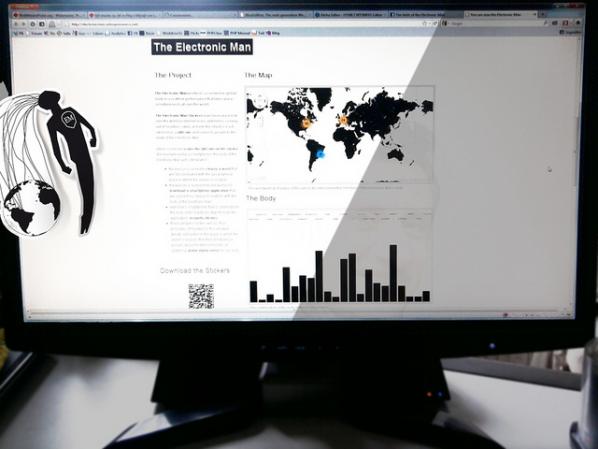
Renee Carmichael: I find the methodology behind this project really interesting. From what I understand it’s about going beyond the analogue vs. digital debate and really going in between and just experiencing and experimenting. Do you think this methodology is important to use in today’s world? How and why might this be so?
Salvatore and Oriana: We are living in a really complex scenario, complex, fast and ever changing. Digital technologies and networks are starting to pervade our analogue reality, transforming it and opening up entirely new possibilities. There are forms of (digital) interaction that are starting to be widely accessible from physical space. These forms of interaction are really peculiar as they allow for a transformation of (physical) reality, making it interactive, reinventing it, remixing it, and adding content to it. The world itself becomes a performance and a very specific form of performance: involving remixes, mashups, recontextualizations and reenactments as its main practices. This has drastic effects, not only as our reality multiplies and reshapes, but also attitudes, perceptions, skills, knowledge and approaches of the people involved change. In this process methodologies, practices and theories remix as well, bringing forth various possible scenarios, in which collaboration practices emerge as the only viable way to perform significant actions.

So, in this scenario, “life, the world and everything” is turning into a multipliable, performative environment in which the only way to, actually, perform in a significant way is to collaborate across cultures, skills, theories and methodologies. This brings forth a change to our sensorial environment, meaning that when ubiquitous technologies are involved, we instantly gain new senses, new sensorialities and sensibilities. Just like with the mobile phone, when it doesn’t catch the network, we move, naturally and without thinking about it, to a place that has better network coverage, in a way that is neurologically similar to the way in which we move our hand away from fire when we feel the heat: it is a real sensibility, an additional sense.
Mixing these two aspects (the forming of a multilayered, collaborative, read-write reality, and the emergence of these new senses), describes a situation that is almost exactly the one presented in the question: experimentation, as in performance and as in science, this new science that traverses disciplines, theories and approaches; and experience, meaning you are actually able to build a new experience of the world that is sensorial and, most important of all, writable.
This is also a good description of the shape that the term “conflict” is assuming: a continuous process of movement and traversal, in which you transform a part of reality (as in augmented reality) adding new meaning and imaginaries to it, in a performative action that unites activism, art, science, design and communication, and that transforms and is transformed really fast, at the pace of the evolution of technologies and networks.
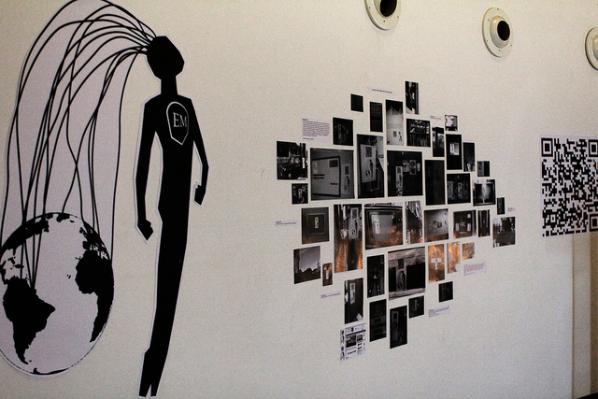
Renee: I read that this project can help us experience and reflect on our place in the world through the external. Do you think the relationship between the individual and the external takes a new shape throughout this project? How might it be understood in the larger ideas and theories of the Electronic Man?
Salvatore and Oriana: The Electronic Man is about the observation and exemplification of something that is already happening in the world. It speaks about interconnection and our renewed perception of space, time, body and relationships. Technologies helped us reshape these concepts completely. We are never in a single place now; we are everywhere, anytime and with lots of people all at the same time, using multiple identities, both voluntarily (mobile phones, ubiquitous networks..) and involuntarily (CCTV, social networks spying on us..). So all these definitions change radically: private and public space, gender, relationship, message, privacy, work and free time. We wanted to make this change explicit. In this change: public and private completely restructure! This is also why we decided to use the “emotional” dimension as a narrative: emotions are thought to be a private, intimate part of our lives, but now they are the object of public observation through what we do in the digital realms, for the new forms of economies that are developing, focusing on attention, reputation, awareness and more.
Renee: Although the Electronic Man allows us to experience sensually, it still creates finite points of data through the connections between a place and an emotion. What do you think is the relationship between the sensual impact of the project and the data it produces? How does the data fit into the idea of creating a new ‘global digital sense of our bodies’?
Salvatore and Oriana: This is a very complicated question! We chose this approach as a starting point. We are using a classification of emotions which is very basic (designed by Plutchik in 1980) it works really well across different languages (we are currently using 29 languages for our performances, to address as much of the world as possible). But this point that is described in the question (freeing the modalities of data, augmenting the degrees of freedom which we can express) is one of the focal points for expansion in the next steps. There are solutions and approaches which we are finding suitable to confront these issues with, and they are all related to adding degrees of freedom in what you “release to the public”: transforming artworks into free frameworks for expression that can be freely used by people. This transformation from artwork to framework is something that is happening all over, and it has to do with P2P culture and free software. This is why we release all the software and hardware (and methodologies) we use in our performances under free licenses: because the next step of each performance is made by the people taking the tools in their own hands and creating their own forms of expression and action, their own additional layers of the world.
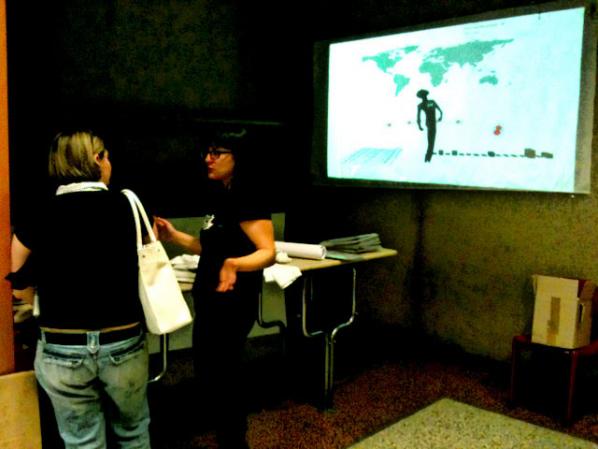
Renee: In a related note, this new form of being that the Electronic Man creates cannot be completely separated from the world and systems it exists in already. It seems that the questions that often arise around this project are in terms of how it can be used within other appropriations. How do you see the future of this project in terms of the various appropriations that it may have and in terms of your own intentions for the project?
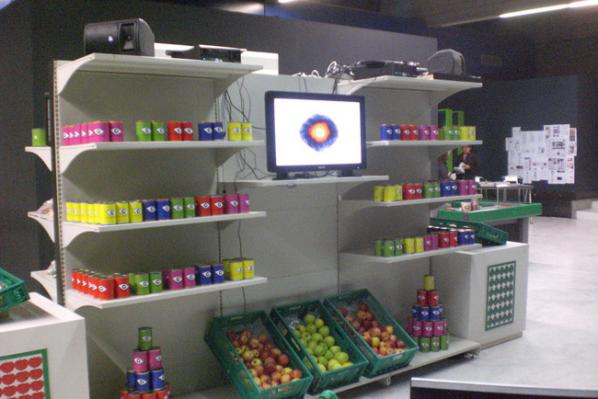
Salvatore and Oriana: As we said: we’re always in beta version. These processes are nomadic, temporary, and unstable. Ideas, software tools, concepts, hardware, practices and approaches are in a continuous state of remix: each time we speak to anyone, or even as we’re writing this, the performance changes and upgrades to the next version. For example we can look at the recent augmented reality interventions that have been taking place all over the world and, just a few days ago at the Venice Biennale: there has been a very fertile discussion building up during the last two years, on the idea that these technologies allow you to “squat” reality, and add new meanings and new degrees of freedom to it. This is why we created a project called Squatting Supermarkets a couple of years ago. This discussion is producing actions: appropriations, performances, re-usage of terms, words, sentences, new forms of activism, and new forms of art. We’re really happy that this is taking place, and we see all this as a wider form of performance in which everyone interested can be involved.
Renee: I can’t help but see a relationship between The Electronic Man and a sort of modern day Frankenstein. Would you like to comment on this relationship?
Salvatore and Oriana: We will answer this question using an answer that our dear friend prof. Massimo Canevacci gave to a question during a TV show in Italy: “This is a wonderful question, and I am deeply convinced that western cultures produced these really heavy mythologies around Frankenstein, the Golem, and arriving to a movie, a very nice one, like Blade Runner, taken from a novel by Philip Dick.
I am certain that this system, this dualism between technology and body, between organic and inorganic, between nature and culture, is finally over, in a liberating way. There are researches in which the concept of cyborg constitutes a perspective that is capable of liberating enormous possibilities. Therefore our bodies become progressively more entangled with technology all over literature, technology, anthropology, and biology.
Thus I sincerely hope that this enormous mythology, this terrifying myth of the Frankenstein, will finally end, once and for all, and will peacefully retire; and that new forms of cyborg will emerge and free themselves, to produce new free forms of expression.
Renee: Finally, any further issues, ideas, thoughts you would like to add?
Salvatore and Oriana: Yes!
The Electronic Man is a global performance! And it becomes useful if lots of people participate (and, by the way, participate by doing even simple things such as attaching some of the Electronic Man stickers around and sending us a picture, and you’ll find yourself and your work advertised whenever we exhibit the work: for example at the MACRO museum in Rome there is a full wall dedicated to the people that are helping us out, including their bios, pictures and links) But, most of all, it becomes useful if lots of people actively grab technologies, methodologies and concepts and actively build their own performative world, possibly sharing the results with everyone else.
So we strongly invite everyone out there to request the software, (it will be published on our sites as soon as we have some time to prepare a proper sharing mechanism, but you all can have it before that by simply asking) and to imagine other disruptive ways of using technologies to create free, accessible, inclusive spaces for communication and expression.
We will support you all in that as much as we can.
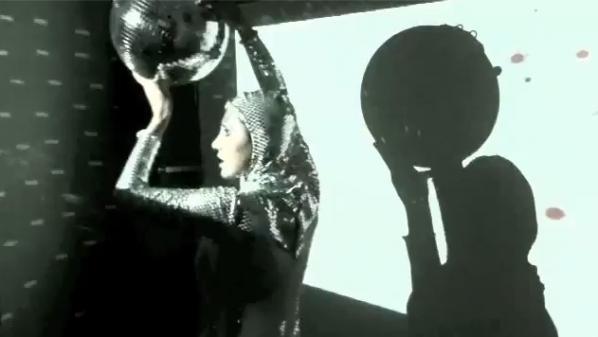
The Electronic Man at ADD Festival, MACRO Testaccio, Rome contemporary art museum, view video on Youtube.
An Interview with Julian Oliver By Taina Bucher.
I met the Berlin-based media artist and programmer Julian Oliver in Toronto as part of the Subtle Technologies festival, where he taught a workshop on the Network as Material. The aim of the workshop reflects Oliver’s artistic and pedagogical philosophy nicely; to not only make people aware of the hidden technical infrastructures of everyday life but to also provide people with tools to interrogate these constructed and governed public spaces.
Julian Oliver, born in New Zealand (anyone who has seen him give a talk will know not to mistake him for an Australian) is not only an extremely well versed programmer but is increasingly as equally knowledgeable with computer hardware. His background is as diverse as the places he has lived and the journeys it has taken him on. Julian started out with architecture but became increasingly interested in electronic art after working as Stelarc’s assistant on ‘Ping Body’, Auckland,1996. He moved on to Melbourne, Australia, and worked as guest researcher at a Virtual Reality center. Later he established the artistic game-development collective Select Parks and in 2003 left for Gotland to work at the Interactive Institute of Sweden’s game lab. He then moved on to Madrid where he had extensive involvement with the Media Lab Prado. Several countries, projects and residencies later, he made Berlin his preferred base, setting up a studio there with colleagues. Julian is also an outspoken advocate of free software and thinks of his artistic practice not so much as art but more in terms of being a ‘critical engineer’, a term that he applies particularly to his collaborations with his studio partner Danja Vasiliev.
Their latest collaboration called Newstweek, was recently announced as winners of the Golden Nica in the Interactive art category of the Prix Ars Electronica 2011. The project leverages on the network as a medium for rigorous, creative investigation, exploring the intersection between the perceived trustworthiness of mass media and the conditions of networked insecurity.
His artistic practice clearly reflects his hacker and gaming background, playing around and messing with routers, capturing data from open wireless networks, visually augmenting commercial billboards in the cityscape, sonifying Facebook chats, visualizing protocols and otherwise manipulating networks for artistic purposes. I sat down with Julian on June 1st to talk about his most recent art projects, his reflections on software and digital media arts more generally. The interview was transcribed from a voice recording in a busy cafe to the best of my ability.
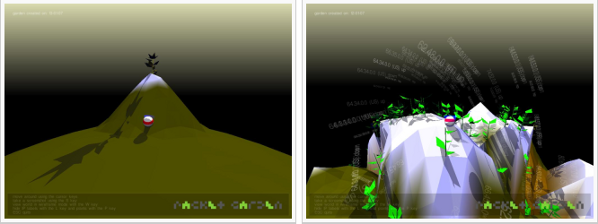
Taina Bucher: You started out with architecture and then moved over to games. How did that transition come about?
Julian Oliver: I realized quite early on that I was less interested in buildings than I was in exploring architecture in the context of the language within which it operates. I was more interested in hypothetical architecture. Like impossible structures such as what Buckminster Fuller proposed, and when I ended up working in a virtual reality centre in Melbourne I found that sitting behind a bunch of SGI machines dedicated to rendering virtual experiences, that I no longer really needed to invest in the idea to build something. I was more interested in something more plastic and mutable. The bridge from there to games came about around 1997-1998. Source code from games started to become available and it became apparent to me that it was possible to modify these games to explore an artistic practice, an architectural and sculptural practice really, using the medium of computer games. There were only 4-5 of us in the world working on this and we quickly made contact with each other. I left the VR centre and started an artistic game based modification lab in Melbourne called Select Parks. For about six years we did a whole bunch of projects based on computer games. We also established an online archive of the ever-increasing experiments and artistic investigations into computer game technology under selectparks.net. The archive is still there now.
TB: Was it the same interest in the mutability of the medium that led you to work with software more generally?
JO: I’ve been programming since I was pretty young and I’ve been around computers since I was a boy and working with them, but it was when I started to increase my freedom of movement with the medium of computer games that I became a programmer. I started to learn C, C++ and scripting languages and I quickly became hooked with the mix between technical challenges and rigorous creative exploration. I think the balance of the two still remains in my work.
TB: In one of your academic papers on games you ask the question of how much of the medium, as a raw field of possibilities, really is available to the artist. Well, let me ask you the same question in relation to software given that software always comes with a certain kind of aesthetic expectation.
JO: Definitely. I think it is a bit of a shame that much of what is called digital art is in fact made by using software suits built by large corporations. Macromedia, now the Adobe suite, is almost an infrastructure of the media arts. Painters of 200 years ago would never have accepted this brand attached to their canvas. They would never have accepted that their tools would be designed with such a generic mass audience in mind. I think that while the digital arts are certainly an exciting field there is an unadmitted dependency on a food chain that comes entirely from a corporation. The contemporary artist would then talk about breaking these tools, or you know, misusing them. But who is really holding the power? I think at a certain point for me, this was the reason why I moved entirely into free software. I really wanted to look at software as a core medium itself and I wanted to get at the guts of it. I wanted to have a rigorous personal relationship with technology so that I could bend it to my needs rather than my needs being bent.
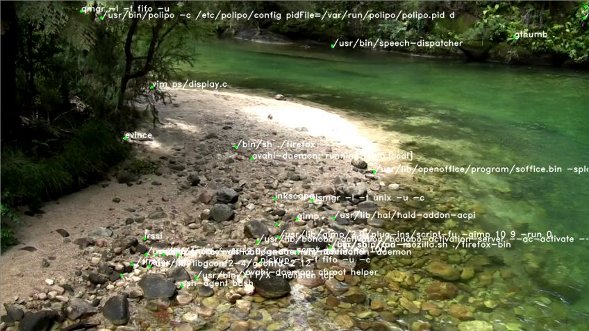
TB: How do you picture a genuinely critical media arts practice then, moving away from the Adobe suites of the world?
JO: No, I think it is fine to use Adobe if it satisfies your expectations. However I think that the expectations themselves are already defined by these external corporate market inputs. I think it is really important for digital artists to understand what digits are. They call themselves software artists but they do not really write software or know what it is. By using it their works become symptomatic of a process that they themselves have not defined.
TB: Does this mean we have to know code in order to be critical of code?
JO: Yes. I think you need to speak the language. It is the same thing with other cultural practices; you need to know the basics of how a violin or a guitar works before you can pass a judgement on the player. There is a parallel history to the new media arts that is not written and that’s all of those technical and cultural contributions that artists and technologists make when they are producing a work of new media. There is certainly a very well written history for the work of art in the galleries but there is nothing of the sorts for the fundaments of the technical achievements. I mean we have that with music for instance, with the evolution of the piano, but there are things happening in the new media arts all the time that no one other than the technologists can really appreciate. These are significant contributions that actually shape the way in which media are used in the future. This is certainly the case with the development of a new programming language that a historian might not necessarily notice. A language like Python or a framework like open frameworks has shifted media arts in such an influential way. Most people only see the end product. Understanding just a little in this regard is enough for enriching the history of the field I think.
TB: One could certainly argue that the ‘democratization of code’ with web 2.0 technologies and open APIs potentially lets anyone produce software art?
JO: Yes certainly. Take Processing for instance, anyone can make a digital square if they want. There is nothing inherently wrong with that. What I am interested in is to make people understand what’s behind it. I think we as artists need to describe what we do and part of this is to publish the source code. For me personally this is an obligation. By publishing the source code I am enriching the scene by allowing other people to have an insight into how it works. Take the project that Danja and I have been doing with Newstweek. If we would hide the way it works it would not enrich anything. We’d only be contributing to our own careers. We therefore publish all our code. You can download it now and already be learning how we did it and so together as a whole we move forward.
TB: Is code ever finished?
JO: That’s a really good question. Probably not. Someone could come along and improve what you think is finished. Every problem can be solved in a multitude of different ways. What constitutes being finished for one program might be elegance of expression. For another one it might be its performance. There are different value systems for programmers. Code in an open context, that is published openly, tends to be living or have the opportunity to live and be contributed to.
TB: You mentioned that most people do not know what software is, would you mind elaborating on that?
JO: Software in its simplest form is a group of instructions that work together somewhat contiguously to process data with an intended outcome. Data itself is everything that is not program code and program code itself is instructions written in a human readable language that are compiled into a form that the computer can understand. Computers have their own language; they are interpreters in a sense. You can really understand software as an automation of multitudinous processes to speed up the production of an intended or desirable outcome. Decision-making can occur, so it is not just a one-dimensional procedure. For the user though, software is generally just a skin of metaphors. If you think about it, clicking a picture becomes an initiation of an event and software is made to allow for the clicking of pictures to allow it to start a program. I mean software is many things at the same time, a field of illusions and metaphors.
TB: To what extent can you be taken by surprise by the software as an artistic medium given that it is your instructions?
JO: Well it depends on the scale of the project. Much of the time the software is a field of limitations. Working with software is about finding ways to make these limitations work and move within them. Unless you (of course) do something in Processing and you just want it to make a square then you just want the program to do exactly this. But for more complex projects I’d describe computer programming as a process of self-humiliation. It is about finding out how poor your initial assumptions about your own abilities are, you feel frustration and you need to fight against your own attention deficit disorder. It is a conversation with yourself, self-development ultimately. Secondly, it is a process of breaking down big problems into smaller ones until so much of the smaller problems are solved that the big one is solved too. But first and foremost I think that software development is self-development.
TB: Speaking of self-development. It is interesting to note that you have in a way returned to architecture, the difference being that you are not sculpting the physical space but the immaterial space. Maybe more so than building things one could say that you deconstruct them, take them apart through intervening and disrupting space.
JO: Yeah. Danja and I work together a lot these days and we refer to ourselves less as artists than as critical engineers. We firmly believe that the most transformative language of our time, one that defines whole economies, I mean how we trade, how and what we eat, how we converse with each other, how we move around the world is engineering. Art itself is increasingly diluted in transformative power, it has become more like entertainment than necessarily anything that is intrinsically rigorous. In the early days of the 1920s and 1930s we had interventionists’ strategies that are now known as art but they didn’t call themselves artists at the time. So as I have been saying to myself quite a lot recently it doesn’t matter if I call what I do art, others will do it for me anyway. So I better describe myself as a critical engineer by taking the language of engineering and lifting it out from a strictly utilitarian space and look at it as a language for rich, critical inquiry and really take on that challenge. It is really about taking the language of engineering and blowing it wide open, taking it away from this kind of black box reality, of big companies making stuff for civilians. This is essentially our relationship to technology. The companies and government make technologies upon which we depend and I think as any technology becomes more ubiquitous like smart phones our ignorance increases. With ubiquity comes ignorance and it seems to be a plottable, predictable curve. The idea of being a critical engineer is to intervene at this point and say “No! Stop!”. We need to reflect on what we are working with and how what we depend upon is shaping us. So learning this hard stuff in order to evade the top down superstructure is necessary.
TB: This might be a good transition to talking about Newstweek, a project that precisely seeks to evade the top down superstructure that you mentioned. How did this project that you’ve collaborated on with Danja Vasiliev come about?
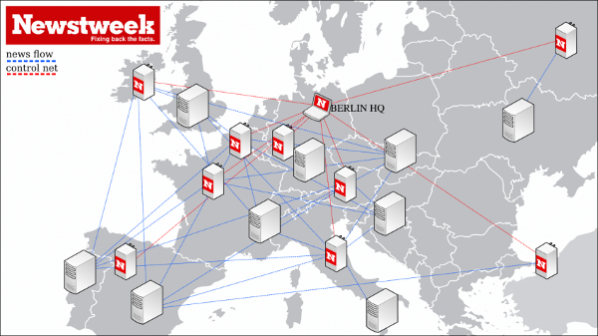
JO: We were at the Chaos Computer Club early this year and we put a little plug into the wall where we put a small router inside. Our goal was really simple, to go into the Berlin congress centre with thousands of hackers and put the thing into the wall and see how long it would last without anybody noticing. We expected it would last a few hours but it was there for the entire conference. One could see it from hundreds of meters away but nobody did something about it, so we realized we were onto something. So we wanted to build a device that looks so much like part of the infrastructure that it would appear harmless.
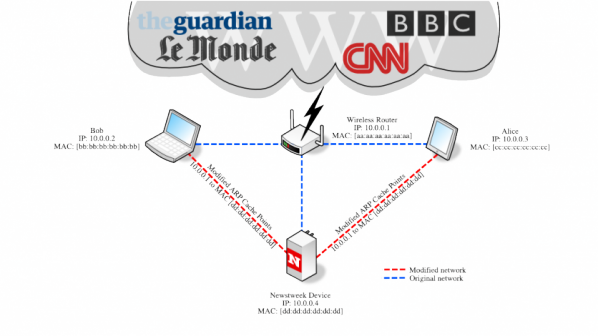
Newstweek: fixing the facts from newstweek on Vimeo.
The second thing was to couple it with a man-in-the-middle attack and to interrogate what we increasingly refer to as a browser-defined reality. Meaning that if it manifests in the browser, it is somehow authentic. It is this idea of going to a major news site, and as long as what one sees comes from this imaginary thing called a server and propagates in your browser, it is somehow trustworthy. We wanted to explore the limits of the impossibility of intervening in an otherwise top-down distribution of news. We wanted to find an on-the-ground way for civilians to intervene with this authority by manipulating the facts. It is really about allowing for a lateral interception of news sources, such as the BBC, the Guardian and CNN.
TB: Did you also record or document people’s reactions to their suddenly altered or tweaked news?
JO: Yeah, we have done this. The thing for us though was merely to provide a platform. People didn’t really believe that Newstweek worked. So we released the how-to saying here is where you buy the hardware, how you open it up, the firmware, the script, and so forth. Only then we had this quiet retrospect where people were going “aha”. What we have changed is their relationship with their environment. It doesn’t matter whether there has been a Newstweek-device in the environment or not. The very fact that they are looking around them and thinking that what is happening in their browser may have been tweaked is the most desirable outcome. This is exactly what happened. Most of the comments are of that nature, saying, “I will never trust the news again”. I mean, even when the attention for the project falls back to the sleepy town of acceptance, I think we can still be very proud of ourselves.
TB: Not just Newstweek, but much of your work is about intervening in public space and exploring the meaning of place. What do these concepts mean to you?
JO: Well I am very interested in the writings of Edward S Casey and the phenomenologist’s Husserl, Mearleau-Ponty and Heidegger of course. One of the great things that has come out of that thought is that Space in itself does not really exist, just as there is no number 2 in the universe. What we have done is to create a concept in order to pre-empt space, to reduce contingency, and in this way so much scientific thought is about reduction of contingency. Space of course is a projection of mathematical constituents to make determinations. Through mathematics and cartography and the like we have seen a growth in trust in the space model rather than the place model. So what I am really interest in, is that rationalization of place has allowed us to live in cities, which have been atomically and economically particularized, privatized. I am interested in how the distinctions between public and private is often extraordinarily blurry. A good example is the fact that a company can pay to put a huge picture outside your apartment during construction for instance yet when it is a millimetre or two away from your wall it no longer belongs to you. Or when you are drilling a hole through your wall in your house at a certain point you are going to hit the neighbours next door. Where does it begin and where does it end? It really shows that territory and place are just constructions. The same goes for wireless technology.
TB: Why is it important to question the ways in which we experience public space?
JO: Well take my work Artvertiser as an example. We have come to accept that our cities are covered in proprietary imagery. So I find it important to question this read-only space much in the line of ad busting and culture jamming. We just did a big streetwise exhibition in Helsinki where artists chose their brands and they made concise commentary simultaneously finding a new way of being in their city.
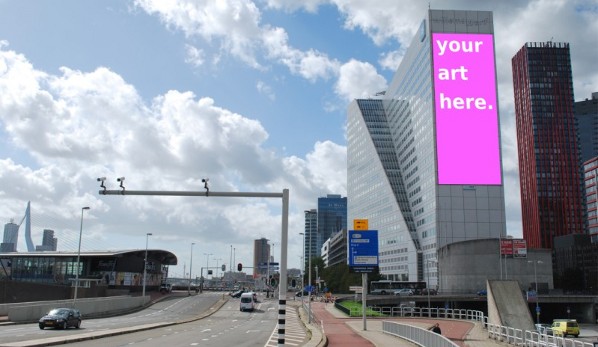
TB: Place often resides in memory and to a certain extent requires permanence. With Artvertiser it is only a temporary intervention. In the end the proprietary imagery stays. What do you hope people take away from an artwork like the Artvertiser?
JO: True. But again, the most productive outcome is conversation. We have the public coming up and looking again and again, through the binoculars at the modified billboards. We even had security guards getting angry. I mean all we are doing is producing a new experience in the visual cortex. Why would a member of the public like the security guard get angry that we are modifying our own experience voluntarily? It is kind of curious.
Featured image: Radion at NetAudio London festival 2011.
NetAudio London Festival, 13th – 15th May 2011.
A three day festival that explores music environments in the digital age of networked technologies. http://www.netaudiolondon.org/
Marc Garrett interviews Andi Studer of NetAudio London, about their latest Festival at the Roundhouse and other venues in London, from Friday 13th – 15th May 2011. Showcasing work of artists who use digital and network technologies to explore new boundaries in music and sonic art, their festivals encourage participation in all forms: interactive sound art installations, conferences, workshops, collaborative online broadcasting and headline shows. This year promises to be a special event, headlined by the legendary Nurse With Wound and many more – read on.
Marc Garrett: This seems like an amazing festival. Not just because it’s context relates to my own background and Furtherfield’s own connected communities and its history in exploring an engagement of contemporary, networked creativity which was once perhaps, considered to be at the edge of art. But now, it does seem as if a new passion is alive and kicking, representing what exists across the genres of art, technology and social change.
The Netaudio London festival began its life in 2006, why did you chose to set up such a dynamic and involving festival, and who are your influences?
Andi Studer: The first Netaudio London grew out of a general passion for electronic music, combined with the recognition of a booming netlabel scene distributing new music with CC licenses for free download. Culturally it spanned the three fields of club culture, avant-garde music and net-politics. During the research phase, we came across of string of European festival projects with the same scope and decided to align with them, so after Netaudio Berne and Cologne, in 2005, London took it’s turn in 2006. Over 3 days we presented more than forty acts in club as well as gig settings; we hosted cultural discussions, organised a knowledge fair around digital music distribution and premiered an the audio installation by Si_COMM, S.E.T.I and N-Spaces… good old days!
MG: What do you feel is important about the Netaudio festival and how does the current one relate to contemporary culture?
AS: Netaudio aims to play an active role in the ongoing process of exploring how technologies, and particularly the Internet, shape our lives. Within this vast field, we focus our work on sonic culture, music and sound art, but reach out to wider aspects such as politics and protest or collaborative creativity.
Whereas in 2005/06 much of the cultural discussion was driven by an incredible optimism about new communication and distribution channels, this year’s festival may pick up on something best described as ‘cyber realism’. The festival, and particularly the conference, building on our 2010 research project, presents a strong case for individuals taking action. And in process of so doing, we are interested to explore what emerging digital tools they use to create new sound art/music, as well as in the social and political endeavours related to their creative work.
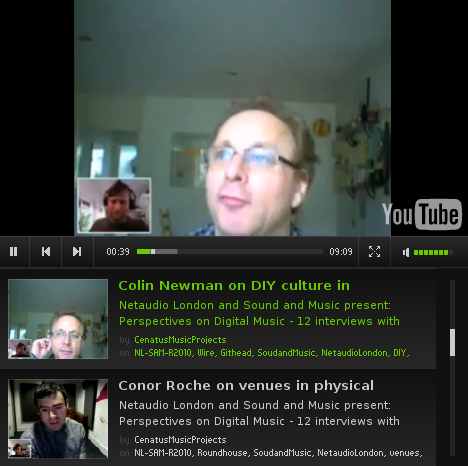
MG: Why chose to include those who have a history in net art, critically engaged thinkers invlolved in networked culture, and many who have been and are part of the (new) media art generation?
AS: We recognise a continuation of creative and socially aware work, enabled by network technologies. Including emerging as well as established projects, some dating from well before the WWW time, allows us to show this continuation and hopefully furthers the wider understanding of these different elements/groups. Whilst there are clear differences between them, there are also many overlaps and we hope that the inclusion of as many as possible in the debate and the wider festival allows for an exploration and greater understanding of these overlaps, and differences.
MG: Your festival includes a visiting member from UK Uncut who will be discussing with others at the Conference and Workshops, regarding the proposed theme of ‘politics and protest; creativity and collaboration; digital futures and analogue survivals.’ They have made headline news regarding their activities challenging the government’s ongoing cuts, and have been actively involved across the country targeting corporate tax dodgers and the banks who caused the financial crisis.
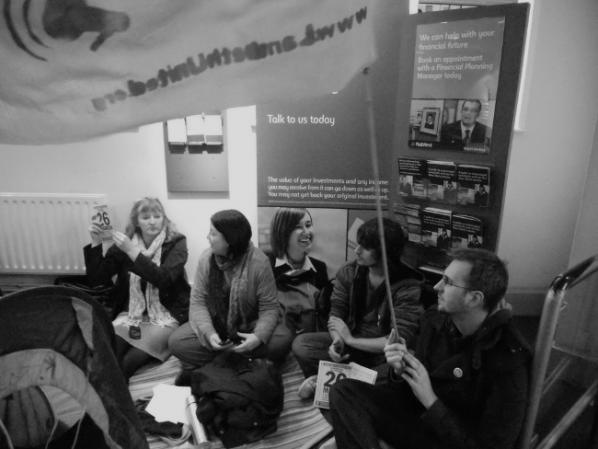
Do you think that UK Uncut’s own perceptions and its activism reflect the festival audience’s general interests and feelings on the matter, across the board?
AS: The participation of UK Uncut is confirmed, but the speaker is to be announced. Whilst some festival audience members may be sympathetic with UK Uncut’s perceptions and activism, others may not. Similarly, whilst members of the festival programming board may have sympathies with UK Uncut’s cause, the festival as such does not necessarily share the same cause with UK Uncut. The reason for inviting UK Uncut was their very successful work as a technology savvy protest movement, as well as their exploration of new forms of protest, particularly sit-ins involving poetry readings and the singing of songs. We are interested to find out more about how they use technology and music/sound in their cause. Presented in a panel with Jeremy Gilbert, Mark Fisher and Anthony Iles, we hope to show how their work sits within the incredible role music had and continues to have in social, political and economic protest.
MG: Nurse With Wound is headlining the festival and they are legendary in the underground music scene. Spanning a career of 30 years plus, under the curatorial guide of Stapleton who has seen NWW collaborate with a highly respected troop of free thinkers including David Tibet (Current 93), William Bennett (Whitehouse) and Andrew McKenzie (Hafler Trio). Many artists who have been working with technology and similar experimental genres, are influenced by those of industrial and avant garde music scene, such as Throbbing Gristle, Cabaret Voltaire, Virgin Prunes, This Heat and NWW, so it seems fitting to have them in the festival, with their peers and of course, an equally interesting selection of younger sound artists and musical explorers.
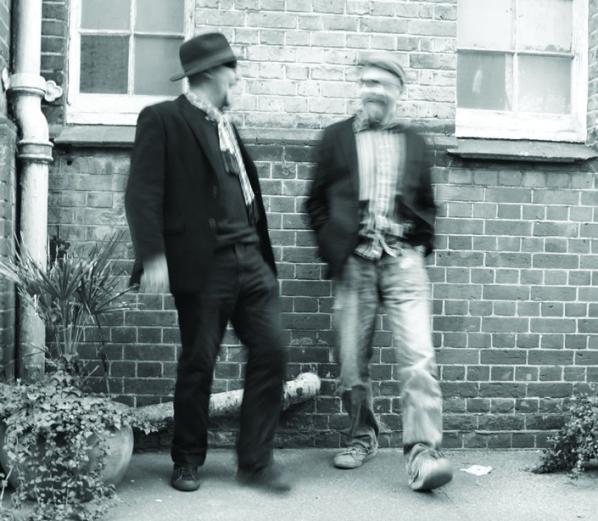
It may say seem like the perfect decision now, but how did you come to the idea of asking Nurse With Wound and what are the links with the other aspects of the festival?
AS: To have Nurse With Wound headlining our festival is a dream come true. Their achievements in anarchic, experimental, DIY, post-industrial music is unparalleled, and it is possible to find many of their approaches in the current new music produced by emerging musicians. This is something we hope to draw on in the rest of the festival.
At KOKO we will also present a newly commissioned live collaboration between Bruce Gilbert (ex-Wire) and Mika Vainio (ex-Pan Sonic). This opportunity to present new work came about though the direct continuation of an ongoing enquiry into collaborative creativity, as featured on one of the three conference panels. This is definitely also a strong theme in the work of Radian, the opening act at KOKO.
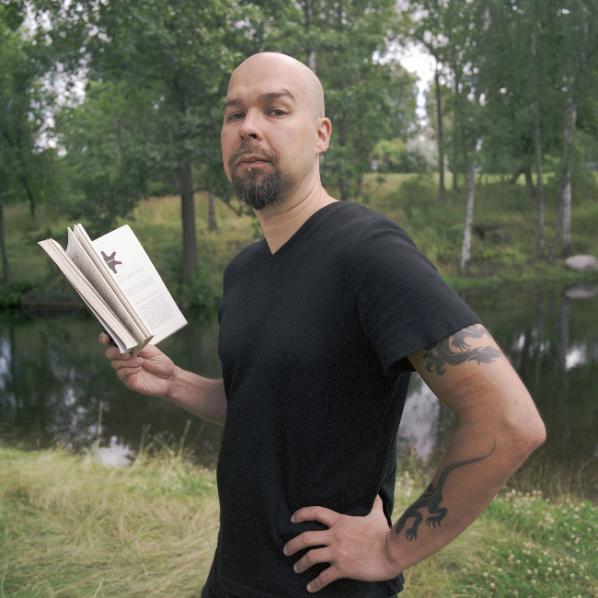
I’d urge anyone who is coming to see NWW at KOKO, to join us at the Roundhouse for the afternoon programme, particularly the conference, but also with the Open Platform stage, we hope to showcase some glimpses of the NWW legacy.
It may be worth mentioning the broadcast strand of the festival here too. Enabled by the Roundhouse Studio facilities and with creative input from Ed Baxter of Resonance104.4fm we are able to feed the festival back to the online domain for the first time. Throughout the afternoon of the 15th May, we will present a live web-zine, thereby leading an enquiry into the future of broadcasting. As part of this we will present three new pieces of work by the commissioned artists: Stefan Blomeier, VHS HEAD, and Liliane Lijn, the latter presenting an online adaptation of her Power Game project.
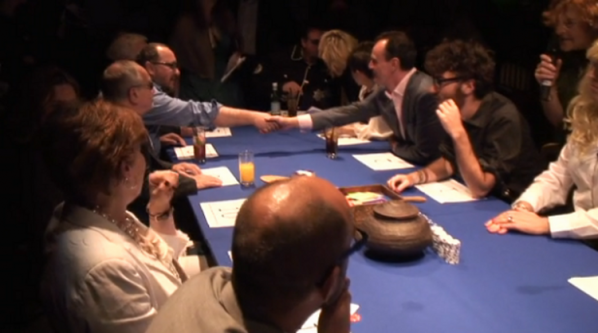
MG: This interesting development warrants investigation, not only because there is an an influx of new interest from a much larger informed and adventurous audience across the board but also because it represents an obvious, cultural dynamic at work. Reflecting a ‘real’ contemporary interest for something different to happen, beyond the remit of normative, art world restraints and its usual, hermetically sealed approaches. We will definitely be there ourselves. To experience what promises to be an engaging and critical conference, but also to explore and enjoy the other varied live events and projects.
The Conference – will bring together theorists, practitioners, activists and academics to address a challenging set of themes in 21st-century culture, featuring speakers including Matthew Herbert and Cecelia Wee: politics and protest; creativity and collaboration; digital futures and analogue survivals.
http://www.netaudiolondon.org/2011/strand/conference
Sound Art – In partnership with Call& Response Netaudio presents an event of 8-channel immersive audio-works. The dynamic and varied explorations of the nine prolific artists brought together by Call& Response highlights the vibrant and diverse field of contemporary sound art. Also there’s the Sonic Maze, an immersive series of sound art installations set in the Roundhouse Studios. http://www.netaudiolondon.org/2011/strand/sound-art
Broadcast – Using the format of a live webzine, Netaudio Broadcast will explore the future of broadcasting with a series of video and radio features. Netaudio Broadcast is co-curated with Ed Baxter of Resonance104.4fm. http://www.netaudiolondon.org/2011/strand/broadcast
Live Music – Starting at cafe OTO on 13th with Robert Piotrowicz (http://www.myspace.com/robertpiotrowicz) and Valerio Tricoli, continuing at Apiary with the runsounds hosted late night event; and the main live show of the festival, a rare live appearance from Steve Stapleton’s Nurse With Wound (http://en.wikipedia.org/wiki/Nurse_with_Wound), a special commission performance by Bruce Gilbert (ex-Wire) and Mika Vainio (ex-Pan Sonic) and Radian.
The 2011 Netaudio London festival supported by the National Lottery through Arts Council England and by the Austrian Cultural Forum London. It is presented in partnership with The Wire, ResonanceFM and Last.fm and supported by the Roundhouse and many more.
TO BOOK YOUR PLACE NOW please email ale[at]furtherfield[dot]org
Over the last decade the awareness of anthropogenic climate change has emerged in parallel with global digital communication networks. In the context of environmental and economic collapse people around the world are seeking alternative visions of prosperity and sustainable ways of living.
While the legacy of the carbon fuelled Industrial Revolution plays itself out, we find ourselves grappling with questions about the future implications of fast-evolving global digital infrastructure. By their very nature the new tools, networks and behaviours of productivity, exchange and cooperation between humans and machines grow and develop at an accelerated rate.
The ideas for this transdisciplinary panel have grown out of Furtherfield’s Media Art Ecologies programme and will explore the impact of digital culture on climate change, developing themes adopted in grass-roots, emerging and established practices in art, design and science. The discussion will inform a second event in September at ISEA 2011 where we will be joined by artists Tom Corby and Helen Varley Jamieson.
Chair: John Hartley
Speakers: –
Michel Bauwens – On how Peer to Peer thought and technology point towards alternative production methods and a sustainable future.
Catherine Bottrill – On working with producers and consumers to consider the environmental long-tail of digital culture.
Ruth Catlow – On ecological approaches to tools, networks and behaviours in a digital art community.
Who this is for: any interested members of the public, cross-disciplinary (science, art, technology) practitioners, academics, students, researchers with an interest in digital culture, technology, sustainability.
Where: CREAM (Centre for Research in Education Art and Media), University of Westminster
Building: 309 Regent Street Campus
Room: RS 152 Cayley Room
Date/ Time: Friday May 13, 2011 from 6:00pm to 8:00pm
Maximum Seats: 60
Catherine Bottrill – Associate Director, Research Julie’s Bicycle
Catherine’s PhD research at the University of Surrey is studying the response of the UK Music Industry to climate change. The research is examining the efforts of the industry to organise itself to collectively take action to reduce greenhouse gas emissions. The study is exploring the possible opportunities, limitations and contradictions for the industry to support a cultural shift towards sustainable energy lifestyles. The research investigates the perspectives of music businesses, artists and audience.
Michel Bauwens – Founder of The Foundation for Peer 2 Peer Alternatives
Michel works in collaboration with a global group of researchers in the exploration of peer production, governance, and property. He has been an analyst for the United States Information Agency, knowledge manager for British Petroleum (where he created one of the first virtual information centers), eBusiness Strategy Manager for Belgacom, as well as an internet entrepreneur in his home country of Belgium.
Ruth Catlow – Co-founder and Co-director of Furtherfield
Ruth is an artist, curator and educator. As co-founder and co-director of Furtherfield.org a grass roots media arts organisation and its gallery (formerly HTTP) in North London, she works at the intersection of art, technology and social change with artists, curators, musicians, programmers, writers, activists and thinkers from around the world. She is currently developing the artistic programme and organisational infrastructure with a focus on Media Art Ecologies, aspiring to engender shared visions and infrastructures for other possible worlds. Ruth is Course manager for digital art and design degrees at Writtle School of Design, where she is currently developing a new BA and MA in Fine Art and Environment.
John Hartley – Art and Ecology Strategist
In his recent role as Arts Council England’s Arts and Ecology Strategy Officer, John supported the development of practice and infrastructure in the face of changing contexts. Also on the Arts Council’s Arts and Ecology partnership with RSA, on the GLA steering group for Greening London’s Theatres and the DCMS Climate Change Project. John led on developing ACE’s self-assessment toolkit to help arts organizations implement effective energy management programs. Implementation of the program can reduce energy usage and carbon emissions, potentially reducing energy costs by up to 20%. He is now a free-lance consultant, also a practicing artist, directs a collaborative experimental music group and has co-written a book published by Transworld.
Re-rooting digital culture is part of Furtherfield’s Media Art Ecologies Programme. This unconference event is partnered by CREAM (Centre for Research in Education Art and Media)
Liz Filardi is a New York City-based performance artist who often works in public space. She was recently awarded a Turbulence Commission for a networked performance piece called I’m Not Stalking You; I’m Socializing, exploring the anxieties of social networking in three modules. “Status Grabber,” the first module, is a satirical online service that extends the status update phenomenon to participation over the telephone. “Black & White,” the second module, is a Facebook-like website, consisting of two interlinked profiles, that tells the story behind one of the original cases of criminal stalking in America. “Facetbook,” the final module, is a performance piece in which the artist compiles a series of archives of her live Facebook profile to illustrate the tension of online identity– between the façade of a profile and the more telling story of how the profile changes over time. The interview was conducted by Taina Bucher, PhD fellow in the Department of Media and Communication at the University of Oslo, Norway. Bucher and Filardi met in Greenwich Village, New York City in May, 2010.
Taina Bucher: How prominently do your friends feature in your work?
Liz Filardi: Well, my only “in” to a social network like Facebook is my own profile, my own network. I think I have about 900 friends. I could start over with a new profile, but I would still only be able to access people that I know or know of. So the people who participate in works based in existing networks, like “Facetbook,” are my friends, and in this context, that includes any Facebook “friend” who feels comfortable commenting or interacting with me. I suppose there is also a subset of “friends” who are made aware of my activity without necessarily caring or wanting to interact with me. In that respect, networked performance on Facebook is very much like performing in public space—I get ignored a lot.
But I would love to find a way to reach a completely different audience on a social network, ideally a subset of users who have stumbled upon my profile without really knowing me or maybe only knowing me from the context of the network because I’m a “friend” of someone who they have “friended.” I have been thinking about starting over on a network like Facebook with this goal in mind, just to see what is possible. It would also be fun to create a new profile controlled by a collective of artists who want to play and experiment.
Why not just make a group on Facebook?
Groups have limitations. Individuals have the most access and mobility on Facebook, because it is designed with the individual’s activity in mind. Groups are like, “I’m here, come over here,” while individuals can say, “I like this, I am doing this, you and I are friends,” which is obviously what drives the site. I am also more compelled by putting a face on a group and speaking from the first person, mixing individual voices and sensibilities and presenting that as one person. It feels a little more subversive. I am interested in playing with the expectations of “friends” on Facebook. For some reason, there is a lot of trust that everyone, that is every non-celebrity, is exactly who they say they are.
Can you tell us a little about your project “Status Grabber?”
“Status Grabber” was created as a satire on the obsession with status updates. I wanted to know how people would react to a telephone-based service that essentially mimicked the way people use Twitter. So I called people and told them that someone they knew had anonymously requested a status update, and that they should provide me with a brief statement that I could post to the internet. I set up a website where people could actually make those requests and hear the responses. But I also made cold calls to random people listed in the telephone book.

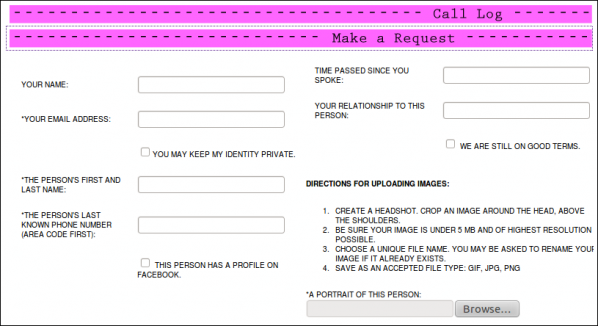
My interest in status updates lies in the disconnect between the author’s intention and the follower’s intention as they engaged in a fairly consistent relationship mediated by a service like Twitter. On Twitter, you can post one message immediately visible to your followers, and those people can discover something about you and experience the feeling of a connection without ever having to say a word or reciprocate. In fact, as you post your update, you often do so with a vague idea of audience, not necessarily of personal connection. So the relationship between a Twitter author and follower can feel smug, but it is artificial—it is a designed experience. Apparently, if popular social tools fill a vacuum of desire, as we often believe, people actually prefer this designed experience on some level. We tend to prioritize the feeling of a connection over the actual value of the connection. In making the calls for “Status Grabber,” I’m basically confronting people with this cultural value.
I visited the site and listened to the call records you posted. It seems that people don’t have a clue about the notion of status updates.
Yeah, the concept of a status update obviously doesn’t translate to the telephone. On the phone, there is much more opportunity to communicate beyond the 140 characters allowed in a Twitter status update, so that became a humorous limitation to the updates that people were encouraged to provide. As a totally believable service, Status Grabber suggests that people actually do not want to have a full conversation or hear a complete update on your status, but instead prefer the abridged version so they can get on with their lives. Of course, most of the call recipients seemed slightly disappointed or appalled for that reason, and in that way, it felt like a good prank phone call.
Call recipients that were willing to participate seemed to feel anxious about the pressure of submitting a status update verbally. They were on the spot to say something substantial or witty as if posting to their Twitter or Facebook account. Most of the updates reflect more spontaneity, less density than can be read in Twitter feeds. I often felt that I was invading their privacy to demand a status update by telephone.
Let us jump to your third module “Facetbook.” How did you come up with the idea?
My day job is in design and I work with the content management system and blog software WordPress. When you edit a blog entry, a new entry is simply added to the database like an appendix to the original entry, so that you’re never editing the existing content of the database but merely adding to it. There is an archive of all your revisions. I started to imagine Facebook having a similar structure. It is possible that we are creating an archive of our life just by being active users, and yet, we have no ownership or access to it. Meanwhile, we present a singular identity within the construct of the profile. We update our profiles to project an idealized representation of ourselves. But if anyone could see the archive of these profiles and be privy to how they have evolved over the years, they would get a much more accurate sense of who we are, and maybe they would be able to see that truth far more clearly than we ourselves can see it.
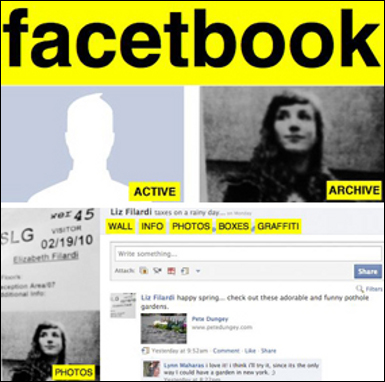
With that in mind, I started to imagine that Facebook actually provides a literal construct of identity. Is this why it’s so addictive and popular? It’s not as if we can go back in time in real life and see written archives of every conversation we have had with friends, and every song we quoted in high school, and every trend we followed. We understand our own identities based on our memories and the occasional ephemera- diaries, photographs, videos, concert tickets, old clothes. In some senses, we don’t own our past, but only the precious ephemera. And in the space between the ephemera and reality, we get to imagine our own story. On Facebook, we can flip back through our activity and photos, and we construct our profiles based on how we see ourselves and who we would like to be. But we can never see old profiles, ones that we’ve since replaced, or content that we’ve removed. We get to curate our identity, manage the expectations of “friends” and find privacy by hiding behind the content we chose to share. That feels real.
And yet, there is something distinctly unreal about Facebook, which is that it is essentially a document, a record in and of itself. Facebook users live on a document. What if everything ever deleted, in fact, lived on? That makes me anxious. So I started looking for software that would allow me to archive my Facebook profile, and I found an experimental Firefox plugin developed by a group of computer scientists at Old Dominion and Harding University. Using their plugin, I started to archive my profile every time I wanted to change it. I wanted to see what it would be like to own an archive—to at least know what it would contain, even if I couldn’t control what Facebook did with my content.
The truth was that I was far more invested in my image and my Facebook life when I was in college than I am today. Maybe it would have been more insightful to capture that early period. But ultimately, the “Facetbook” performance became about investing in Facebook again and thinking about the stakes of participation. Knowing that I would be creating this archive and could delete my profile at any time, I tried to confront the extent of how people actually use Facebook. I wrote things like, “For brief periods of time, I have favorite profiles that I like to check,” and “even if you never change your profile, I will look at the same three pictures more than once. It gives my mind something to work with.” It feels strange to perform on a site where only a very acute mix of authenticity and performance is acceptable as a voice—you know, in posting status updates that display some charming aspect of yourself without exposing that you’ve given any thought to it. With “Facetbook,” I’m trying to expose Facebook as a site that serves a more libidinal function for people.
How do you see performance art changing in an environment where performance has, to some degree, become commonplace?
That’s a bold statement—one could argue that public life has always been about performance and that performance is no more commonplace today than in the past—but maybe it is more commonplace. The prominence of the social web—especially for younger generations who have restricted access in the real world—pushes public life online and into the realm of performance. People who are growing up with social networks are justifiably feeling like the center of the world with daily evidence to that effect. The lives of prominent, young YouTube vloggers are filled with connections to near strangers who make up coveted audiences across geographic boundaries. Any time someone has an audience, they become a performer. I think of Natalie Bookchin’s Testament, which is a multi-channel video essay that appropriates YouTube vlogs to speak to themes like work, economy, and war. The video diaries that are used in her piece exemplify a personal, confessional approach as seen in television shows like The Real World, and yet they are beyond television—these people are acutely aware that they are sharing their daily life not necessarily with friends but with an audience. The vloggers use common buzzwords and phrases that Bookchin pulls out to create the sensation that they are speaking in unison, just as news anchors and talk show hosts speak in an established language and tone. And that has become a normative way to socialize.
But performance art is entirely different from the spirit of performance on the social web. For one thing, the moment you disseminate over the internet or design your work for an internet based reception, you are creating media art, or networked performance, as Turbulence has preferred to call it. As far as my own experience with performance art, every time I perform something in public, I imagine being interpreted in two camps: an amateur throwback to the founding artists like Abramovic and Ono and Shneemann (young performance artists always seem so nostalgic for the power of the body and the live act, but it’s rare to pull off something powerful and new) and/or an urban prankster looking for attention in the local paper or city blog (a la the clever performance troupes like Improv Everywhere who disrupt city life with the exciting treat of surrealism). So I think the challenge for contemporary performance art is to find a place that is at once culturally relevant and striking, and to champion public space in a compelling way. It’s too easy to just take your actions to the streets of New York like plop art. People are already used to that. Lately I’ve been trying to create works that don’t come across as one-liners, but instead inspire the viewer to question what is going on, or to hold on to one particularly poignant affect or visual. The last thing I want to say—it gets problematic when one begins to qualify performance art as something that happens in galleries and museums because it was meant to defy the commodification of art, but I do want to say that I see it forging ahead in small galleries like Recess in SoHo.
Can you speak a little about your second module, “Black & White?” How did that come about?
That project started with research into the history of criminal stalking, as it relates to the popular contemporary idea of “Facebook stalking.” I wanted to explore the relationship between the tongue and cheek use of the word stalking to describe fairly typical activity on social networks and historical accounts of serious stalking in a time less saturated by social web technologies. I was fascinated by a famous case from 1988 between two co-workers at a Silicon Valley software engineering company. A young woman, a 22 or 23 years old Laura Black, started working at the company as one of the few female engineers. She sparked the unhealthy interest of a male engineer, Richard Farley, who became suddenly deeply obsessed with her. He stalked her for years, and while she sought help at her company when she feared for her life, she had trouble getting any real protection. She changed addresses and phone numbers, which only provided temporary relief, and got a temporary, ineffective restraining order. He would send letters, arrive at her house unannounced, and once joined her gym. In her anger and fear, it seems that she also wanted to show him that he couldn’t control her and that she was still going to enjoy her life and stay in the area. So there really wasn’t a collective intelligence about the threat of stalking at the time. Farley eventually arrived at the office with an arsenal of weapons and attacked the entire company. Black was shot in the shoulder and survived. Farley was arrested. Shortly after, the first anti-stalking law passed in California in 1989 and the story, along with a couple of other violent stalking cases, made national news.
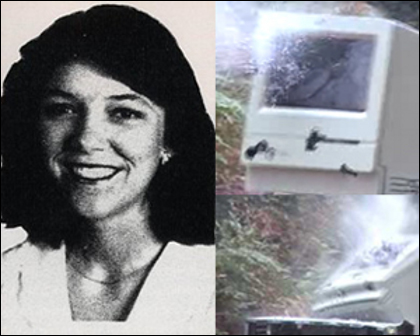
Today, we don’t hear about cases like that because we have a lot more information and legislation to prevent that kind of thing. I can only assume that potential incidents are resolved before escalating to that level. We live in a different climate, where we share a lot more information about ourselves on the social web, and “stalking” is a hyperbolic term that describes the ultimately harmless activity of focusing on the available information of a single person without their knowledge or consent. The use of negative hyperbolic terms like “stalking” indicates a safer cultural climate, but also a latent guilt that may be rooted in cases such as the one illustrated in “Black & White.”
This makes me think of Twitter and the term “followers.”
Yes, it’s similar. Perhaps there’s a greater cultural need to be leader, with a collection of commoditized “followers” in tow. On the social web, we are less often ordinary humans and more often celebrities or actors splintered by various interests and audiences.
In “Black & White,” why do you transpose the stalking case into the paradigm of a social network?
Black&White is the name of a fictional network that looks much like Facebook, but it only contains two members: Laura Black and Richard Farley. Creating this site was a way to call attention to collective intelligence, to speak the language that we (on Facebook) have all learned so well. I knew that most people would intuitively be able to navigate the format and learn the story between the two people involved. In the context of the vast network of Facebook, it is striking that there are only two people in this network. Their content is linked through their job and location, despite their apparent lack of friendship. Underneath the relatively unassuming public profiles is a horrifying, one-sided correspondence in their message in- and outboxes. I wanted to dramatize their loneliness and emphasize the lack of will in their connection, which is how they will be remembered in the American collective consciousness. Hopefully this leads viewers to consider how and why the term “stalking” or the act of “stalking” has changed since the 1980s.
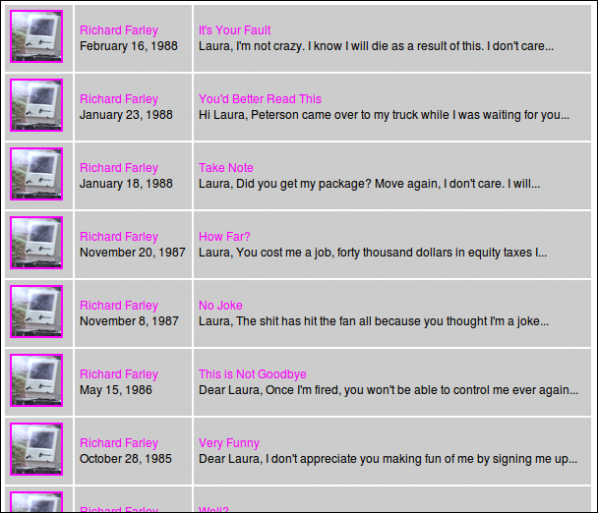
In terms of creativity on social networks, I think a lot of us are just filling in forms. The template of the social network is limiting. Will this have any affect on the direction of your work?
That’s a good question. I have felt confined by the structure of social networks, and even with the content of art that speaks directly to social networks. With I’m Not Stalking You; I’m Socializing, I started with the easiest form of art made to respond to social networks: a satire perpetrated through mimicry in other medias or dimensions, as seen in “Status Grabber.” This has been done in other works, as well. I guess I needed to make that piece so that I could see what was beyond it, and I believe I went a little further and yielded more insight in the other two modules. But now I’m starting to see how the social web simply permeates our consciousness and I believe I may find more insight if I take a step back from art on social networks altogether. As someone who has grown up on social networks, I’m interested to see how the themes that I’ve honed in my work with social networks will surface and return in works and areas of practice that move in a new direction.
Featured image: Games/03 Paul Sermon, Peace Games, © der Künstler 2008.
Das Spiel und Seine Grenzen: Passagen des Spiels II ed. Mathias Fuchs and Ernst Strouhal, (Springer Verlag, 2010), German language only.
Fuchs, Mathias; Strouhal, Ernst (Hrsg.)
1st Edition., 2010, 272 S. 16 Abb., Softcover
ISBN: 978-3-7091-0084-4
Versandfertig innerhalb von 3 Tagen
Mathias Fuchs is considered to be one of the first artists to explore the combination of videogames and art. Today he is a senior lecture at Salford University in England and a leading researcher on Game Art and ludic interfaces. Social and political context in videogames and how they affect our society has been a major topic in Fuch’s research. Last year he published, together with Ernst Strouhal, an anthology of videogames and its borders and how this genre is changing and influencing society. The background to the anthology was an exhibition held at Kunsthalle Wien in 2008 about art and politics in videogames.
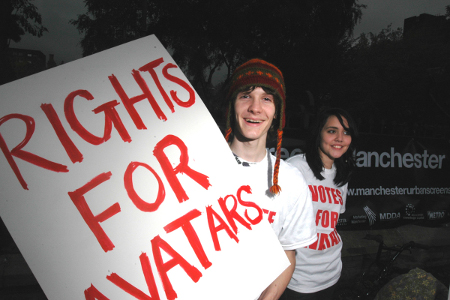
It has been 60 years since Johan Huizinga’s now classic book Homo Ludens, the playing human, was published. Games are no longer just entertainment; it’s a major industry that is affecting our society in every aspect. In the foreword Fuchs states that the main issue for the 15 essays in the anthology is how games have changed and affected our society both politically and socially since they crossed over from the realms of entertainment into everyday experience.
Today we can find many different genres in videogames, such as serious games and persuasive games, that discuss current issues, news and social problems, artistic games which address existential and aesthetic aspects, and so on. The gaming community has grown enormously and created on-line worlds with strong virtual economics, attached real world economics. In her essay Daphne Dragona says “The virtual environments of our times therefore can be seen as social institutions with social, political and economic values resembling those of real life.”
In a similar way Tapio Mäkelä’s essay about locative games describes how the gamescene has entered the real world in the form of cos-players and social gameplays where videogames as Pacman are performed in the city streets or games as “/Noderunner/, where participants run to find open WiFi Networks, take a photo of themselves at the location and send the info via e-mail to the project’s website.” This begins to close the gap between networks and everyday experience through the practice of social gaming. The game as object is less of an obvious conclusion now that technology enables us to explore ourselves within networked, gaming contexts and mobile technologies.
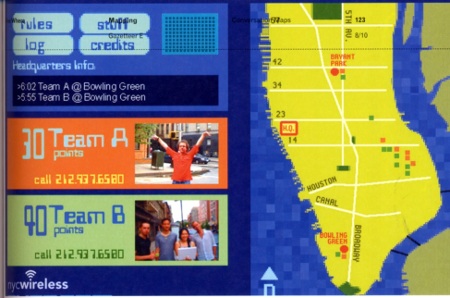
The borders between game and reality have now become even more blurred and integrated, especially if we consider how technology itself also crosses over into administrational activites which have already been traditional elements of controlling, processing parts of our lives. One example is how authorities around the world are supervising these new socio-economics, such as collecting taxes from virtual incomes by using similar tools and networks. There are many questions about how games will continue to affect and change our society in the future and the anthology takes an interesting and comprehensive look into what games have to offer and what could be potential threats to our future societies.
Today games are serious business. It is not impossible that in the future a bankruptcy of an on-line gameworld could shake the real world and create an economic depression. On the other hand, could on-line game economies bring prosperity and create new jobs, an economic boom in ways we have not witnessed before? If games move into a new period of changing social experience in even more connected ways than before, then we need to understand what the consequences of these are and how to navigate through this shifting terrain. One thing is for sure, it was a long time ago that games were just entertainment.
http://www.springer.com/new+%26+forthcoming+titles+%28default%29/book/978-3-7091-0084-4
Michel Bauwens is one of the foremost thinkers on the peer-to-peer phenomenon. Belgian-born and currently resident in Chiang-Mai, Thailand, he is founder of the Foundation for P2P Alternatives.
It’s a commonplace now that the peer-to-peer movement opens up new ways of creating relating to others. But you’ve explored the implications of P2P in depth, in particular its social and political dimensions. If I understand right, for you the phenomenon represents a new condition of capitalism, and I’m interested in how that new condition impacts on the development of culture – in art and also architecture and urban form.
As a bit of a background, I’d like to look at what you’ve identified as the simultaneous “immanence” and “transcendence” of P2P: it’s interdependent with capital, but also opposed to it through the basic notion of the Commons. Could you elaborate on this?
With immanence, I mean that peer production is currently co-existing within capitalism and is used and beneficial to capital. Contemporary capitalism could not exist without the input of free social cooperation, and creates a surplus of value that capital can monetize and use in its accumulation processes. This is very similar to coloni, early serfdom, being used by the slave-based Roman Empire and elite, and capitalism used by feudal forces to strengthen their own system.
BUT, equally important is that peer production also has within itself elements that are anti-, non- and post-capitalist. Peer production is based on the abundance logic of digital reproduction, and what is abundant lies outside the market mechanism. It is based on free contributions that lie outside of the labour-capital relationship. It creates a commons that is outside commodification and is based on sharing practices that contradict the neoliberal and neoclassical view of human anthropology. Peer production creates use value directly, which can only be partially monetized in its periphery, contradicting the basic mechanism of capitalism, which is production for exchange value.
So, just as serfdom and capitalism before it, it is a new hyperproductive modality of value creation that has the potential of breaking through the limits of capitalism, and can be the seed form of a new civilisational order.
In fact, it is my thesis that it is precisely because it is necessary for the survival of capitalism, that this new modality will be strengthened, giving it the opportunity to move from emergence to parity level, and eventually lead to a phase transition. So, the Commons can be part of a capitalist world order, but it can also be the core of a new political economy, to which market processes are subsumed.
And how do you see this condition – the relationship to capital – coming to a head?
I have a certain idea about the timing of the potential transition. Today, we are clearly at the point of emergence, but also coinciding with a systemic crisis of capitalism and the end of a Kondratieff wave.
There are two possible scenarios in my mind. The first is that capital successfully integrates the main innovations of peer production on its own terms, and makes it the basis of a new wave of growth, say of a green capitalist wave. This would require a successful transition away from neoliberalism, the existence of a strong social movement which can push a new social contract, and an enlightened leadership which can reconfigure capitalism on this new basis. This is what I call the high road. However, given the serious ecological and resource crises, this can at the most last 2-3 decades. At this stage, we will have both a new crisis of capitalism, but also a much stronger social structure oriented around peer production, which will have reached what I call parity level, and can hence be the basis of a potential phase transition.
The other scenario is that the systemic crisis points such as peak oil, resource depletion and climate change are simply too overwhelming, and we get stagnation and regression of the global system. In this scenario, peer-to-peer becomes the method of choice of sustainable local communities and regions, and we have a very long period of transition, akin to the transition at the end of the Roman Empire until the consolidation of feudalism during the first European revolution of 975. This is what I call the low road to peer to peer, because it is much more painful and combines both progress towards p2p modalities but also an accelerating collapse of existing social logics.
That’s a less optimistic scenario… what form of conflict would this involve?
The leading conflict is no longer just between capital and labour over the social surplus, but also between the relatively autonomous peer producing communities and the capital-driven entrepreneurial coalitions that monetize the commons. This has a micro-dimension, but also a macro-dimension in the political struggles between the state, the private sector and civil society.
I see different steps of political maturation of this new sphere of peer power. First, attempts to create networks of sympathetic politicians and policy-makers; then, new types of social and political movements that take up the Commons as their central political issue, and aim for reforms that favour the autonomy of civil society; finally, a transformation of the state towards what I call a Partner State which coincides with a fundamental re-orientation of the political economy and civilization. You will notice that this pretty much coincides with the presumed phases of emergence, parity and phase transition.
Most likely, acute conflict may arise around resource depletion and the protection of these resources through commons-related mechanisms. Survival issues will dictate the fight for the protection of existing commons and the creation of new ones.
You often cite Marx, who of course also wrote at a time of conflict and social change provoked by technological and economic development. Does this tension you’re describing fit in his notion of contradictory forces conflicting – thesis, antithesis, synthesis – in other words, is this a historical materialist process?
I don’t quite use the same language, because I use Marx along with many other sources. I never use Marx exclusively or ideologically, but as part of a panoply of thinkers that can enlighten our understanding. My method is not dialectical but integrative, i.e. I strive to integrate both individual-collective aspects and objective-subjective aspects, and to avoid any reductionist and deterministic interpretations. Though I grant much importance to technological affordances, I do not adhere to technological determinism, and I don’t find that I pay much attention to historical materialism, since I see a feedback loop between culture, human intentionality, and the material basis. Technology has to be imagined before it can be invented.
My optimism is grounded in the hyperproductivity of the new modes of value creation, and on the hope that social movements will emerge to defend and expand them. If that fails to happen, then the current unsustainable infinite growth system will wreak great havoc on the biosphere and humanity.
As you say classical or Marxist economics don’t really suffice to describe the current situation. Is one aspect of this problem that the classical distinction between use and exchange doesn’t fit with a situation in which many of the “uses” are ludic, and have an exchange system built into them? I’m thinking of on-line gaming specifically. But it has always been difficult to place art in this simple use/exchange polarity. Do you see any revisions to that polarity today?
I’m not sure the ludic aspect is crucial, as use value is agnostic to the specific kind of use, just as peer production is agnostic as to the motivation of the contributors. However, our exponential ability to create use value without intervention of the commodity form, with only a linear expansion of the monetization of peer platforms, does create a double crisis of value. On the one hand, capital is valuing the surplus of social value through financial mechanisms, and is not restituting that value to labour, just as proprietary platforms do not pay their value producers; on the other hand, peer producers are producing more and more that can’t be monetized. So we have financial crisis on the one hand, a crisis of accumulation and a crisis of precarity on the other side. This means that the current form of financial capitalism, because of the broken feedback loop between value creation and realization, is no longer an appropriate format.
Regarding your ‘integrative method’, this is a much more sophisticated take on economics that places it in relationship to other, cultural, dimensions of human life. And the imagination is central to it. Given that, do you see any special role for art in this transition?
Art is a precursor of the new form of capitalism, which you could say is based on the generalization of the ‘art form of production’. Artists have always been precarious, and have largely fallen outside of commodification, relying on other forms of funding, but peer production is a very similar form of creation that is now escaping art and becoming the general modality of value creation.
My take is that commodified art has become too narcissistic and self-referential and divorced from social life. I see a new form of participatory art emerging, in which artists engage with communities and their concerns, and explore issues with their added aesthetic concerns. Artists are ideal trans-disciplinary practitioners, who are, just as peer producers, largely concerned with their ‘object’, rather than predisposed to disciplinary limits. As more and more of us have to become ‘generally creative’, artists also have a crucial role as possible mentors in this process. I was recently invited to attend the Article Biennale in Stavanger, Norway, as well as the artist-led herbologies-foraging network in Finland and the Baltics, and this participatory emergence was very much in evidence, it was heartening to see.
We might see as opposed to that sort of grassroots participatory engagement, the entities you refer to as the “netarchies.” Their power lies in the ownership of the platform they exploit for harvesting user-originating information and activities. How hegemonic is this ownership? At what point does it become impossible to create a “counter-Google”?
The hegemony is relative, and is stronger in the sharing economy, where individuals do not connect through collectives and have weak links to each other. The hegemony is much weaker in the true commons-oriented modalities of production, where communities have access to their own collaborative platforms and for-benefit associations maintaining them.
The key terrain of conflict is around the relative autonomy of the community and commons vis a vis for-profit companies. I am in favour of a preferential choice towards entrepreneurial formats which integrate the value system of the commons, rather than profit-maximisation. I’m very inspired by what David de Ugarte calls phyles, i.e. the creation of businesses by the community, in order to make the commons and their attachment to it viable and sustainable over the long run. So, I hope to see a move from the current flock of community-oriented businesses, towards business-enhanced communities. We need corporate entities that are sustainable from the inside out, not just by external regulation from the state, but from their own internal statutes and linkages to commons-oriented value systems.
Counter-googles are always possible, as platforms are always co-dependent on the user communities. If they violate the social contract in a too extreme way, users can either choose different platforms, or find a commons-oriented group that develops an independent alternative, which in turn maintains the pressure on the corporate platforms. I expect Google to be smart enough to avoid this scenario though.
As you’ve said elsewhere, many of these issues are about a new form of governance. Do you see any of this as particularly urban in character — I mean, about organization at the smaller scale, regionally focused, as opposed to at the level of the nation state. Does propinquity matter at all to this — the importance of living together? This seems to relate to a — not a contradiction or tension exactly, but a complication of the P2P notion — that relationships are dispersed, yet a number of the parallels you draw with historical models (for example the Commons) connect with social situations in which people lived very close together. A fairly strong notion in urbanistic thinking is that propinquity is a good thing. In the past that was part of many artistic relationships also: cities as milieux of artistic production/creativity, artists’ colonies; working cheek by jowl with other creative people and breathing the same air. Is this notion in any sense undermined by dispersed networks?
I think we are seeing the endgame of neoliberal material globalization based on cheap energy, and hence a necessary relocalization of production, but at the same time, we have new possibilities for online affinity-based socialization which is coupled with resulting physical interactions and community building. We have a number of trends which weaken the older forms of socialization. The imagined community of the nation-state is weakening both because of the globalized market; the new possibilities for relocalization that the internet offers, which includes a new lease of life to mostly reactionary and more primary ethnic, regional and religious identities; but also because of this important third factor, i.e. socialization through transnational affinity based networks.
What I see are more local value-creation communities, but who are globally linked. And out of that, may come new forms of business organization, which are substantially more community-oriented. I see no contradiction between global open design collaboration, and local production, both will occur simultaneously, so the relocalized reterritorialisation will be accompanied by global tribes organized in ‘phyles.’ I think the various commons based on shared knowledge, code and design, will be part of these new global knowledge networks, but closely linked to relocalized implementations.
One interesting question is what forms of urbanism come out of p2p thinking. The movement is in the process of thinking this through, in fact a definition of p2p urbanism was just published by the “Peer-to-peer Urbanism Task Force” (http://p2pfoundation.net/Peer-to-Peer_Urbanism).
This promotes, in general terms, bottom-up rather than centrally planned cities; small-scale development that involves local inhabitants and crafts; and a merging of technology with practical experience. All resonant in various ways with p2p approaches. But this statement also provokes a few questions: It calls for an urbanism based on science and function; in fact it explicitly promotes a biological paradigm for design. At the risk of over-categorizing, isn’t this a modernist understanding of design — or if not, how is it different? This document also refers to specific schools of urban design: Christopher Alexander, and also New Urbanism. On the side of socio-economics though, New Urbanism has been criticized (for example in David Harvey’s Spaces of Hope); some see it as nostalgic and in the end directed at a narrow segment of the population. Christopher Alexander’s work on urban form has also been criticized as, being based on consensus, restrictive in its own ways. In fact, might not p2p principals call for creation of spaces that allow dissent and even shearing-off from the mainstream? Might there be a contradiction built into trying to accommodate the desires for consensus and for freedom? Contradiction can be a source of vitality, certainly in art; but it can raise some tensions when you get to built form and a shared public realm.
I cannot speak for the bio- or p2p urbanism movement, which is itself a pluralistic movement, but here’s what I know about this ‘friendly’ movement. I would call p2p urbanism not a modernist but a transmodernist movement. It is a critique of both modernist and postmodern approaches in architecture and urbanism; takes critical stock of the relative successes and failings of the New Urbanist school; and then takes a trans-historical approach, i.e. it critically re-integrates the premodern, which it no longer blankly rejects as modernists would do. I don’t think that makes it a nostalgic movement, but rather it simply recognizes that thousands of years of human culture do have something to teach us, and that even as we ‘progressed’, we also lost valuable knowledge. Finally, I think there is a natural affinity between the prematerial and post-material forms of civilization. The accusation of elitism is I think also unwarranted, given what I know of the work of bio-urbanists amongst slumdwelling communities. However, I take your critique of consensus very seriously, without knowing how they answer that. You are right, that is a big danger to guard for, and one needs to strive for a correct balance between agreed-upon frameworks, that are community and consensus-driven, and the need for individual creativity and dissent. Nevertheless, compared to the modernist prescriptions of functional urbanism, I don’t think that danger should be exaggerated.
Following on this track, I’d like to pose another question that relates to living together. The P2P concept depends on the difficulty of controlling the activity of peers on a network: i.e. it’s impossible to lock down the internet. Doesn’t this degree of freedom also eliminate those social controls that might be considered “healthy” – for example, controls over criminal activity. David Harvey (to bring him in again), in his paper “Social Justice, Postmodernism and the City”, lists social controls among several elements of postmodern social justice. When the grand narratives have been replaced by small narratives, there remains a need to limit some freedoms. How does p2p thinking deal with this?
I think we can summarize the evolution of social control in three great historical movements. In premodern times, people lived mostly in holistic local communities, where everyone could see one another, and social control was very strong. At the same time, vis a vis more far-away institutions, such as for example the monarchy, or the feudal lord, or say in more impersonal communities such as large cities, compliance was often a function of fear of punishment. With modernity, we have a loss of the social control through the local community, but a heightened sense of self through guilt, combined with the fine-grained social control obtained through mass institutions, described for example by Michel Foucault. The civility obtained through the socialization of the imagined community that was the nation state, and the educational and media at its disposal, also contributed to social control and training for civil behaviour.
My feeling about peer-to-peer networks is that they bring a new form of very real socialization through value affinity, and hence, a new form of denser social control in those specific online communities which also usually have face-to-face socialities associated with them. But this depends on whether the community has a real value affinity and a common project, in which case I think social control is ‘high’, because of the contributory meritocracy that determines social standing. On the contrary, in the looser form of sharing communities, say YouTube comments for example, we get the type of social behaviour that comes from anonymity and not really being seen.
So the key challenge is to create real communities and real socialization. Peer to peer infrastructures are often holoptical, i.e. there is a rather complete record of behaviour and contributions over time, and hence, a record of one’s personality and behaviour. This gives a bonus to ‘good ethical behaviour’ and attaches a higher price to ‘evil’. On the other hand, in the looser communities, subject to more indiscriminate swarming dynamics, negative social behaviour is more likely to occur.
A key difference between contemporary commons and those of the past is that the new ones are immaterial and global. The model for P2P exchange seems to be of autonomous agents relating and forming new communities not based on membership in an originary cultural group. Given a global distribution, how do local, cultural factors play into the model of globalized distributed networks? How does P2P accommodate cultural specificity, especially specificity with deep historical roots; and how does that accommodate the development of new culture, art?
In my view, the digital commons reconfigure both the local and the global. I think we can see at least three levels, i.e. a local level, where local commons are created to sustain local communities, see for example the flowering of neighbourhood sharing systems; then there are global discourse communities, but they are constrained by language; so rather than national divisions, which still exist but erode somewhat as a limitation for discourse exchange, there is a new para-global level around shared language. At each level though, cultural difference has to be negotiated and taking into account. If there is no specific effort at diversity and inclusion, then affinity-based communities reproduce existing hierarchies. For example, the free software world is still dominated by white males. Without specific efforts to make a dominant culture, which has exclusionary effects, adaptive to inclusion, deeper participation is effectively discouraged. Of course, as the dominant culture may not be sufficiently sensitive, it is still incumbent on minoritarian cultures to make their voice and annoyances heard. Obviously, each culture will have to go through an effort to make their culture ‘available’ through the networks, but I think the specific role of artists, now operating more collectively and collaboratively than before, is to experiment with new aesthetic languages, so that non-conceptual truths can be communicated.
The innovation I see as most important though is in terms of the globa-local, i.e. a relocalization of production, but within the context of global open design and knowledge communities, probably based on language. I also see a distinct possibility for a new form of global organization, i.e. the phyle I mentioned earlier, as fictionalized in Neal Stephenson’s The Diamond Age and operationalized by lasindias.net. These are transnational value communities that created enterprises to sustain their livelihoods.
I see the key challenge, not just to develop ‘relationality’ between individuals, as social networks are doing very well, but to develop new types of community, such as the phyle, which are not just loose networks, but answer the key question of sustainability and solidarity.
In terms of culture, what I see developing is a new transnational culture, based on value and discourse communities, based on language, that are neither local, nor national, nor fully cosmopolitan, but ‘trans-national’.
And the creative relationships between artists can in some sense be a model for this?
Artists have been precarious in almost all periods of history, and their social condition reflects what is now very common for ‘free culture’ producers today, so studying sustainability and livelihood practices of artist communities seems to me to be a very interesting lead in terms of linking with previous historical experience. I understand that artists now have increasingly collaborative practices and forms of awareness. Unfortunately, my own knowledge of this is quite limited so this is really also an open appeal for qualified researchers to link art historical forms of livelihood, with current peer production. In some ways, we are all now becoming precarious artists under neoliberal cognitive capitalism!
Co-published by Furtherfield and The Hyperliterature Exchange.
Last October I received an e-mail headed “Introducing Vook”:
The Vook Team is pleased to announce the launch of our first vooks, all published in partnership with Atria, an imprint of Simon & Schuster, Inc. These four titles… elegantly realize Vook’s mission: to blend a book with videos into one complete, instructive and entertaining story.
The e-mail also included a link to an article about Vooks in the New York Times:
Some publishers say this kind of multimedia hybrid is necessary to lure modern readers who crave something different. But reading experts question whether fiddling with the parameters of books ultimately degrades the act of reading…
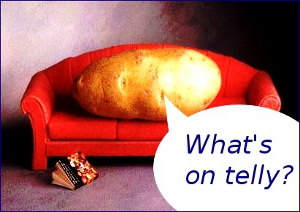
Note the rather loaded use of the words “lure”, “crave”, “fiddling” and “degrades”. The phraseology seems to suggest that modern readers are decadent and listless thrill-seekers who can scarcely summon the energy to glance at a line of text, let alone plough their way through an entire book. If an artistic medium doesn’t offer them some form of instant gratification – glamour, violence, excitement, pounding beats, lurid colours, instant melodrama – then it simply won’t get their attention. But publishers have a moral duty not to pander to their readers’ base appetites: the New York Times article ends by quoting a sceptical “traditional” author called Walter Mosley –
“Reading is one of the few experiences we have outside of relationships in which our cognitive abilities grow,” Mr. Mosley said. “And our cognitive abilities actually go backwards when we’re watching television or doing stuff on computers.”
In other words, reading from the printed page is better for your mental health than watching moving pictures on a screen: an argument which has been resurfacing in one form or another at least since television-watching started to dominate everyday life in the USA and Europe back in the 1950s. To some extent this is the self-defence of a book-loving and academically-inclined intelligensia against the indifference or hostility of popular culture – but in the context of a discussion of Vooks, it can also be interpreted as a cry of irritation from a publishing industry which is increasingly finding the ground being scooped from under its feet by younger, sexier, more attention-grabbing forms of entertainment.
The fact that the Vook publicity-email links to an article which is generally rather sniffy and unfavourable about the idea of combining video with print no doubt reflects a belief that all publicity is good publicity – but it is also indicative of the publishing industry’s mixed attitudes towards the digital revolution. On the whole, up until recently, they have tended to simply wish it would just go away; but they have also wished, sporadically, that they could grab themselves a piece of the action. But those publishers who have attempted to ride the digital surf rather than defy the tide have generally put their efforts and resources into re-packaging literature instead of re-thinking it: and the evidence of this is that the recent history of the publishing industry is littered with ebooks and e-readers, whereas attempts to exploit the digital environment by combining text with other media in new ways have generally been ignored by the publishing mainstream, and have therefore remained confined to the academic and experimental fringes.
The publishing industry’s determination to make the digital revolution go away by ignoring it has been even more evident in the UK than in the US. The 1997 edition of The Writers’ and Artists’ Yearbook, for example, contains no references to ebooks or digital publishing whatsoever, although it does contain items about word-processing and dot-matrix printers. On the other hand, Wired magazine was already publishing an in-depth article about ebooks in 1998 (“Ex Libris” by Steve Silberman, http://www.wired.com/wired/archive/6.07/es_ebooks.html) which describes the genesis of the SoftBook, the RocketBook and the EveryBook, as well as alluding to their predecessor, the Sony BookMan (launched in 1991). Even in the USA, however, enthusiasm for ebooks took a tremendous knock from the dot-com crash of 2000. Stephen Cole, writing about ebooks in the 2010 edition of The Writers’ and Artists’ Yearbook, summarises their history as follows:
Ebook devices first appeared as reading gadgets in science fiction novels and television series… But it was not until the late 1990s that dedicated ebook devices were marketed commercially in the USA… A stock market correction in 2000, combined with the generally poor adoption of downloadable books, sapped all available investment capital away from internet technology companies, leaving a wasteland of broken dreams in its wake. Over the next two years, over a billion dollars was written off the value of ebook companies, large and small.
After 2000, there was a widely-held view (which I shared) that the ebook experiment had been tried and failed: paper books were a superb piece of technology, and perhaps a digital replacement for them was simply never going to happen. There were numerous problems with ebooks: too many different and incompatible formats, too difficult to bookmark, screens hard to read in direct sunlight, couldn’t be taken into the bath, etc. But ebooks have always had a couple of big points in their favour – you can store hundreds on a computer, whereas the same books in paper form demand both physical space and shelving, you can find them quickly once you’ve got them, and they’re cheap to produce and deliver. Despite the dot-com crash and general indifference of the reading public, publishers continued to bring out electronic editions of books, and a small but growing number of people continued to download them.
Things really started to change with the launch of Amazon’s Kindle First Generation in 2007. It sold out in five and a half hours. With the Kindle, the e-reader went wireless. Instead of having to buy books on CDs or cartridges and slot them into hand-helds, or download them onto computers and then transfer them, readers using the Kindle could go right online using a dedicated network called the Whispernet, and get themselves content from the Kindle store.
Despite this big step forward, the Kindle was still an old-school e-reader in some respects: it had a black and white display, and very limited multimedia capabilities. The Apple iPad changed the rules again when it was launched in April 2010. The iPad isn’t just an e-reader – it’s “a tablet computer… particularly marketed for consumption of media such as books and periodicals, movies, music, and games, and for general web and e-mail access” (Wikipedia, http://en.wikipedia.org/wiki/I-pad). Its display screen is in colour, and it can play MP3s and videos or browse the Web as well as displaying text. For another thing, it goes a long way towards scrapping the rule that each e-reader can only display books in its own proprietary format. The iPad has its own bookstore – iBooks – but it also runs a Kindle app, meaning that iPad owners can buy and display Kindle content if they wish.
It seems we may finally be reaching the point where ebooks are going to pose a genuine challenge to print-and-paper. Amazon have just announced that Stieg Larsson’s The Girl with the Dragon Tattoo has become the first ebook to sell more than a million copies; and also that they are now selling more copies of ebooks than books in hardcover.
It is certainly also significant that the past couple of years have seen a sudden upsurge of interest in the question of who owns the rights over digitised book content, and whether ordinary copyright laws apply to online text – a debate which has been brought to the boil by a court case brought against Google in 2005 by the Authors Guild of America.
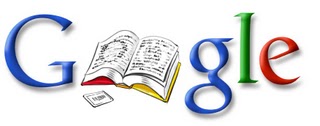
In 2002, under the title of “The Google Books Library Project”, Google began to digitise the collections of a number of university libraries in the USA (with the libraries’ agreement). Google describes this project as being “like a card catalogue” – in other words, primarily displaying bibliographic information about books rather than their actual contents. “The Library Project’s aim is simple”, says Google: “make it easier for people to find relevant books – specifically, books they wouldn’t find any other way such as those that are out of print – while carefully respecting authors’ and publishers’ copyrights.” They do concede, however, that the project includes more than bibliographic information in some instances: “If the book is out of copyright, you’ll be able to view and download the entire book.” (http://books.google.com/googlebooks/library.html)
In 2004 Google launched Book Search, which is described as “a book marketing program”, but structured in a very similar way to the Library Project: displaying “basic bibliographic information about the book plus a few snippets”; or a “limited preview” if the copyright holder has given permission, or full texts for books which are out of copyright – in all cases with links to places online where the books can be bought. Interestingly, my own book Outcasts from Eden is viewable online in its entirety, although it is neither out of copyright nor out of print, which casts a certain amount of doubt on Google’s claim to be “carefully respecting authors’ and publishers’ copyrights”.
In 2005 the Authors Guild of America, closely followed by the Association of American Publishers, took Google to court on the basis that books in copyright were being digitised – and short extracts shown – without the agreement of the rightsholders. Google suspended its digitisation programme but responded that displaying “snippets” of copyright text was “fair use” under American copyright law. In October 2008 Google agreed to pay $125 million to settle the lawsuit – $45.5 million in legal fees, $45 million to “rightsholders” whose rights had already been infringed, and “$34.5 million to create a Book Rights Registry, a form of copyright collective to collect revenues from Google and dispense them to the rightsholders. In exchange, the agreement released Google and its library partners from liability for its book digitization.” (http://en.wikipedia.org/wiki/Google_Book_Search_Settlement_Agreement). The settlement was queried by the Department of Justice, and a revised version was published in November 2009, which is still awaiting approval at the time of writing.
The settlement is a complex one, but its most important provision as regards the future of publishing seems to be that “Google is authorised to sell online access to books (but only to users in the USA). For example, it can sell subscriptions to its database of digitised books to institutions and can sell online access to individual books.” 63% of the revenue thus generated must be passed on to “rightsholders” via the new Registry. “The settlement does not allow Google or its licensees to print copies of books in copyright.” (“The Google Settlement” by Mark Le Fanu, The Writers’ and Artists’ Yearbook 2010, pp. 631-635).
Google, it will be noted, are now legally within their rights to continue their digitisation programme. This means they don’t have to ask anyone’s permission before they digitise work. If authors or publishers would prefer not to be listed by Google it is up to them to lodge an objection online. Google would argue that in launching their Library Project and Books Search they have merely been seeking to make their search facilities more complete, and thus to “make it easier for people to find relevant books” – but whether or not they have been deliberately plotting their course with wider strategic issues in mind, the end result has been to make them the biggest single player – almost the monopoly-holder – where digital book rights are concerned. As a reflection of this, an organisation called the Open Book Alliance has been set up to oppose the settlement, supported by the likes of Amazon and Yahoo: “In short,” their website claims, “Google’s book digitization strategy in the U.S. has focused on creating an impenetrable content monopoly that violates copyright laws and builds an unfair and legally insurmountable lead over competitors.” (http://www.openbookalliance.org/)
Whatever the pros and cons of the Google Settlement, it has undoubtedly helped to focus the minds of writers and publishers alike on the question of digital rights. Copyright laws and publishers’ contracts were designed to deal with print and paper, and until very recently there has been almost no reference at all to electronic publication. Writers who have agreed terms with a publisher for reproduction of their work in print have theoretically been at liberty to re-publish the same work on their own websites, or perhaps even to collect another fee for it from a digital publisher; and conversely, publishers who have signed a contract to bring out an author’s work in print have sometimes felt free to reproduce it electronically as well, without asking the writer’s permission or paying any extra money.
But things are beginning to change. A June 2010 article in The Bookseller notes that Andrew Wylie, one of the most prestigious of UK literary agents, “is threatening to bypass publishers and license his authors’ ebook rights directly to Google, Amazon or Apple because he is unhappy with publishers’ terms.” This is partly because he believes electronic rights are being sold too cheaply to the likes of Apple: “The music industry did itself in by taking its profitability and allocating it to device holders… Why should someone who makes a machine – the iPod, which is the contemporary equivalent of a jukebox – take all the profit?” Clearly, electronic rights are going to be taken much more seriously from now on.
Further indications that authors, publishers and agents are beginning to wake up and smell the digital coffee can be found in the latest editions of The Writers’ and Artists’ Yearbook and The Writers’ Handbook. For those who are unfamiliar with them, these annual publications are the UK’s two main guides to the writing industry. The 2010 edition of The Writer’s Handbook opens with a keynote article from the editor, Barry Turner, entitled “And Then There was Google”. As the title indicates, its main subject is the Google settlement and its implications – but its broader theme is that the book trade has been ignoring the digital revolution for too long, and can afford to do so no longer:
In the States… sales of e-books are increasing by 50 per cent per year while conventional book sales are static. An indication of what is in store was provided at last year’s Frankfurt Book Fair where a survey of book-buying professionals found that 40 per cent believe that digital sales, regardless of format, will surpass ink on paper within a decade.
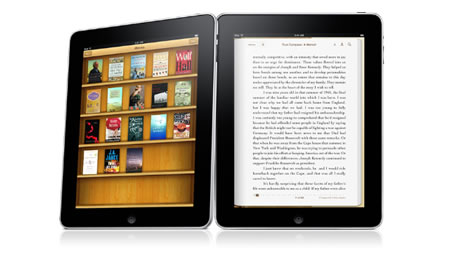
The Writers’ and Artists’ Yearbook is more conservative in tone, but if anything its coverage is more in-depth. It has an entire section titled “Writers and Artists Online”, which leads with an article about the Google settlement. In addition there are articles on “Marketing Yourself Online”, “E-publishing” and “Ebooks”. Even in the more general sections of the Yearbook there is a widespread awareness of how digital developments are affecting the book trade. For example, there is a review (by Tom Tivnan) of the previous twelve months in the publishing industry, which acknowledges the importance not just of ebooks but print-on-demand:
Amazon’s increasing power underscores how crucial the digital arena is for publishing… Ebooks remain a miniscule part of the market,… yet publishers and booksellers say they are pleasantly surprised at the amount of sales… And it is not all ebooks. The rise of print-on-demand (POD) technology (basically keeping digital files of books to be printed only when a customer orders it) means that the so-called “long tail” has lengthened, with books rarely going out of print… POD may soon be coming to your local bookshop. In April 2009, academic chain Blackwell had the UK launch of the snazzy in-store Espresso POD machine, which can print a book in about four minutes…
There is also an article about “Books Published from Blogs” (by Scott Pack):
Agents are proving quite proactive when it comes to bloggers. Some of the more savvy ones are identifying blogs with a buzz behind them and approaching the authors with the lure of a possible book deal… Many bestsellers in the years to come will have started out online.
Most of the emphasis in these articles falls on the impact which digital developments are having on the marketing of books rather than the practice of writing itself. But now and again there are signs of a creeping awareness that digitisation may actually change the ways in which our literature is created and consumed. In The Writer’s Handbook, Barry Turner attempts to predict how the digital environment may affect the practice of writing in the coming years:
Those of us who make any sort of livng from writing will have to get used to a whole new way of reaching out to readers. Start with the novel. Most fiction comes in king-sized packages… Publishers demand a product that looks value for money… But all will be different when we get into e-books. There will be no obvious advantage in stretching out a novel because size will not be immediately apparent… Expect the short story to make a comeback… The two categories of books in the forefront of change are reference and travel. Their survival… is tied to a combination of online and print. Any reference or travel book without a website is in trouble, maybe not now, but soon.
Scott Pack’s article on “Books Published from Blogs” tends to focus on those aspects of a blog which may need remoulding to suit publication in book form; but an article by Isabella Pereira entitled “Writing a blog” is more enthusiastic about the blog as a form in its own right:
The glory of blogging lies not just in its immediacy but in its lack of rules… The best bloggers can open a window into private worlds and passions, or provide a blast of fresh air in an era when corporate giants control most of our media… Use lots of links – links uniquely enrich writing for the web and readers expect them… What about pictures? You can get away without them but it would be a shame not to use photos to make the most of the web’s all-singing, all-dancing capacities.
Even here, however, the advice stops short of videos, sound-effects or animations. Another article in The Writers’ and Artists’ Handbook (“Setting up a Website”, by Jane Dorner) specifically forbids the use of animations:
Bullet points or graphic elements help pick out key words but animations should be avoided. Studies show that the message is lost when television images fail to reinforce spoken words. The same is true of the web.
It’s a little difficult to fathom exactly what point Dorner is trying to make here, but it seems to be something along the lines that using more than one medium may have a distracting rather than enhancing effect. If the spoken words on your television are telling you one thing, but the pictures are telling you another, then “the message is lost”. Perhaps a more interesting point, however, is where Dorner draws her dividing-line between acceptable and unacceptable practice. “Bullet points or graphic elements” are all right, because they “help pick out key words”, but “animations should be avoided”. In other words visual aids are all very well as long as they remain to subservient to text. They minute they threaten to replace it as the focus of attention, they become undesireable.
Clearly this point of view continues to enjoy a lot of support, particularly from traditionalists in the writing and publishing industries. All the same, combinations of text with other media may be about to enjoy some kind of vogue; and the development of the Vook brand since its launch last October is an instructive case-history in this regard.
When Vooks were first launched it seems fair to say that they were broadly greeted with a mixture of indifference and scorn. Reviews which appeared in the first couple of months after the launch were usually either lukewarm of downright unfavourable. Here, for example, is one from Janet Cloninger, writing in The Gadgeteer, November 2009:
So how were the video clips? Have you ever seen any of those old 60s TV shows where they were trying to show a bad acid trip? You know the crazy camera work, the weird color changes, the really bad acting?… I don’t think they added anything to the story at all… I found they were very distracting while trying to read.
Here is another from the Institute for the Future of the Book:
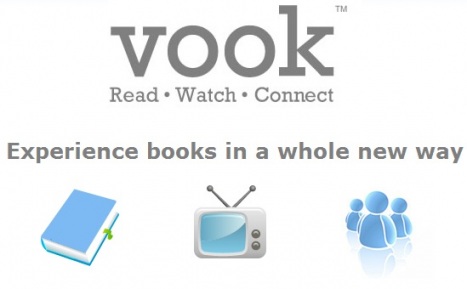
In terms of form the result is ho-hum in the extreme, particularly as there doesn’t seem to be much attempt to integrate the text and the banal video, which seems to exist simply to pretty-up the pages.
Following on from this generally unenthusiastic reception for the first Vooks, news about the brand over the next few months seemed to suggest that it was struggling to establish itself. In January 2010 Vook announced that they were publishing a range of “classic” titles, mostly for children – since “classic” normally means “out of copyright”, this seemed to imply that they were trying to boost their titles-list on the cheap. In February there was an announcement that Vook had raised an extra $2.5 million in “seed-financing” from a number of Silicon Valley and New York investors, suggesting that perhaps initial sales had been disappointing, Simon & Schuster had been reluctant to put up more money, and new sources of finance had therefore been sought.
With the launch of the iPad, however, it became obvious that Vook was making another throw of the dice. In April they launched 19 titles specially adapted for the iPad: In a statement, Bradley Inman, Vook CEO and founder said, “We will remember the iPad launch as the day that the publishing industry officially made the leap to mixed-media digital formats and never looked back…” The Vook blog makes this pinning-of-hopes on the iPad even more apparent:
The release of the iPad this Saturday was not just a red letter moment for Silicon Valley, it marked a turning point for the publishing and film industries, and a great opportunity for those invested in the future of media. The team at Vook has been working hard for months to prepare apps for submission to Apple… In many ways, it seems like the iPad was literally made for us…
And it seems their hopes may not have been misplaced. In May they launched a title about Guns’n’Roses (Reckless Road, documenting the creation of the Appetite for Destruction album), and lo and behold it was favourably greeted:
…unprecedented photos and memorabilia from the early years of one of the great rock bands from the 1980s and 1990s… If you are a true hard rock fan, and Guns ‘N’ Roses was one of your favorite bands, this app is worth the try. (PadGadget)
Now that I’ve had some time to read through Reckless Road and watch many of the videos included in it I can see the value of the Vook approach. It lends itself well to a product like this… This is an app any Guns N’ Roses fan would greatly appreciate. (Joe Wickert)
In June, the Vook version of Brad Meltzer’s bestseller Heroes for my Son was also favourably received:
It is easy to see the tremendous possibilities in the Vook format, especially when tied to a tablet device like the iPad. I very much enjoyed my first experience with a Vook mainly because I rapidly dropped my attempt to think of it as a Book with video plug ins. A Vook is really a multimedia platform that centers around text, rather than a traditional book. (MobilitySite)
Both these books are non-fiction – a genre in which the relationship between video footage and text seems far less problematic. It is interesting to note, however, that in both cases the non-linear structure of the Vook is singled out as a positive feature, compared to the sequential organisation of a traditional book:
It is charmingly non-linear and can be approached from many different angles. More a chocolate box than a book, especially if you are like me and enjoy really digging down into a subject while reading. (MobilitySite)
Remember that old VH1 series, Behind the Music? Canter’s Vook app feels like a modern version of that approach, with the added benefit that you can hop around the story to your heart’s content… (Joe Wickert)
There are hints here of a realisation that digital media can sometimes offer kinds of reading which are unavailable to, or hampered by, traditional print-and-paper.
Further recognition that ebooks with multimedia in them might actually have market appeal came at the end of June from none other than Amazon, who announced that they were adding audio and video to the Kindle iPhone/iPad app. The irony of this move is, of course, that Kindle ebooks are now multimedia-capable on the iPhone and iPad but not on the Kindle itself – an irony which can hardly be allowed to continue, and which therefore doubtless presages the launch of a multimedia Kindle some time in the near future.
Of course, the story of multimedia innovation in literature goes back much further than Vooks and the iPad. The British writer Andy Campbell, for example, has been publishing his own new media fiction online for years – most recently on the Dreaming Methods website. Most of his work has been designed in Flash, which the iPad unfortunately does not support. He therefore finds himself in the one-step-forward-and-two-steps-back position where new media literature is finally starting to make some headway in the marketplace, but thanks to a whim of the Apple corporation his own work in the field, developed over more than a decade, been landed with a big disadvantage. Understandably, his feelings are mixed:
It does indeed seem like there is a shift going on with digital fiction, although there are still a large number of stumbling blocks from a development point of view… Whilst the potential of the iPhone and iPad is undoubtedly exciting, a lot of authors – including myself – do not work with Macs or have the programming experience required to produce Apple-happy content…. However that’s from the point of view of Apple dominating the market and forcing everyone to use their SDK, whilst in actual fact Android holds considerable promise… I wouldn’t say digital fiction is breaking through into the mainstream – although perhaps it depends what you mean by digital fiction… Whether anything has been produced that really takes reading as an experience to a new level, I’m not sure.
Since Flash has hitherto been one of the main tools used by new media writers and artists, many of them will now find themselves in the same predicament as Campbell – and many of them will doubtless be hoping, like him, that alternative platforms such as Android are going to make some headway in the coming months. But leaving the question of platforms on one side, another difficulty for existing new media writers seems to be that although publishers are suddenly discovering a new enthusiasm for the form, they have very little knowledge or understanding of the work which has already been done, and very few links with those who have been doing it. Nor is this entirely the publishers’ fault, because there seems to be a genuine cultural divide between those who work in the publishing industry and those who take an interest in new media literature. Emily Williams of Digital Book World alludes to this divide in her article about this year’s London Book Fair (“Old London vs. New Media”, April 2010):
In most [publishing] houses, the digital innovators are still operating on a parallel plane, touching on but not fully integrated into the publishers’ core business centers. This segregation is so complete that much of the digital crowd is liable to skip the traditional fairs altogether, gravitating instead to their own tech confabs (which are in turn often boycotted by, or unknown to, the bookish folk).
Michael Bhaskar, a publisher and one of the judges of the Poole Literary Festival’s New Media Writing Prize, makes a similar point in his blog:
There has been no real conversation between the two [publishers and new media writers]. Why? It seems like we should have hit the meeting point where there could and should be a productive alliance, when in fact the gulf seems as wide as ever… Publishers have to sell books – or something – to keep going… [whereas] much new media writing is not designed to be commercial, being associated with a more recondite and experimental mindset.
In other words, publishers and new media writers have failed to come together, not simply because publishers have been hoping for the digital revolution to go away, nor because new media writers have been go-it-alone experimentalists, but because culturally they have belonged to different worlds, moved in different circles and spoken different languages.
Even assuming that these difficulties can be overcome, it is open to doubt whether new media writers will necessarily want to throw themselves headlong into the commercial mainstream. Many of them, like Andy Campbell, have been going it alone for so long that the habit of independence may be difficult to shake. Undoubtedly a bit of money would be very welcome, but advice from marketing men about how to make their work more commercial might be less well-received. On the publishing side of the equasion, however, there are definite signs that things are starting to change. Experimentation was the buzzword of the 2010 London Book Fair:
The publishing industry must move at speed to adopt new business models and new ways of working if it is to seize the opportunities of the digital revolution, delegates were told at London Book Fair… Industry figures focused on the need to experiment and to get a real understanding of what consumers want from the new technologies in a fast-changing environment. (The Bookseller)

There are also signs that the influence of digital technology on writing now extends beyond the software-savvy fringe, and is starting to affect the ways in which less specialised writers create their work. One of the surprize best-sellers of last year was a book called Important Artifacts and Personal Property from the Collection of Lenore Doolan and Harold Morris, Including Books, Street Fashion and Jewellery, by Leanne Shapton, which (as the title suggests) takes the form of an auction catalogue, selling off the belongings of a fictional couple. As befits an auction catalogue, the book consists of photographs of the articles for sale, accompanied by snippets of text –
Lot 1231: Two pairs of white shoes. Two pairs of white bucks. The label inside the men’s pair reads “Prada”, the women’s reads “Toast”. Sizes men’s 11, women’s 9. Well worn. $40-60.
The artefacts in the catalogue are arranged in chronological order, which makes it easier for them to tell the story of the couple’s love-affair; but despite this concession to linearity what is striking about the novel, to anyone who has had very much to do with new media literature, is how like a piece of new media literature it is. Experimental it may be as a novel in print, but as a piece of digital writing it would be fairly conventional, albeit unusually well-put-together. It was obviously composed as collection of objects and pictures as much as a a piece of written text; there is no conventional dialogue or storytelling; despite its chronological sequence there is a strong non-linear element to the book, a feeling that it is as much designed to be dipped and skimmed as to be read from one end to the other; it makes a knowing reference to Raymond Queneau, the Oulipo writer; and in many ways it would be more at home on the Web, where the pictures could be in full colour and zoomable at no extra expense.
Another example of the influence of digital technology on “ordinary” literature comes from the small-scale end of the publishing industry – Martha Deed’s poetry chapbook The Lost Shoe, which was published earlier this year by Dan Waber at Naissance Chapbooks (about whom, more in a moment). The first point to note about this collection is that in order to publicise it Martha made a video, also called “The Lost Shoe” (http://www.sporkworld.org/Deed/lostshoe.mov), which deserves to be thought of as a companion-piece rather than a “trailer”. The poems in the collection are based on Martha’s experiences as a psychologist specialising in family law – more specifically, they deal with cases in which family members have done violence to each other, and some of them are harrowingly raw:
Upstairs, he tried twice to change his clothes
his fingers slippery with your blood…
You were looking at him
the last person you saw before your death
It bothered him, that lifeless stare,
so he stepped over your mother
your dying baby sister
and tried to close your eyes…
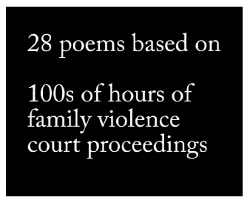
The video has the same combination of near-documentary authenticity and artistic control. It starts with a 911 telephone call from a man who has harmed his own children. There is a terrible moment when he is asked what has happened and he breaks into hysterical tears and says “They got stabbed”, as if somebody else might have done it. It ends with Martha reading aloud from one of her own poems, “Practice Tips”, which is based on the Center for Criminal Justice Advocacy‘s “Criminal Pre-Trial and Trial Practice”:
Play the tape 10 times at trial.
The jury will become accustomed to the carnage…
Obfuscate. Whine. Grandstand.
Fumble with your papers.
The fact that Martha feels equally at home working with both the written word and the camera, and therefore feels able to shoot her own video as a means of publicising her collection of poems, is an indication of the way in which digital technology is beginning to influence literary practice at grass-roots level. But the influence goes further. As well as conventional verse, her collection contains a number of visual poems – you could almost call them diagram poems – combining text with graphic design. “Jury Pool”, for example, shows a number of black stick-figures in and around the jury pool, labelled with reasons why they have been disqualified from the jury, or factors which will influence their outlook on the case: “Have to go back to school”, “Ate lunch with defendant’s mother”, “Crime victim”, “Don’t understand English”, and so forth. Including a diagram-poem such as this in a collection of poetry would not have been impossible before digital technology came along, but the fact that software packages such as Microsoft Word and Open Office Writer can handle images as easily as text, and make it simple to customise page-design without incurring any extra cost, means that poets now have an enormous range of experimental possibilities constantly at their fingertips.
Furthermore a lot of writers haven’t just moved beyond the pen or the portable typewriter to computers and word processing software; they have moved on to such things as blogs and web-pages, which have built-in multimedia capabilities. Sound-files and videos are rapidly becoming a normal part of the amateur writer’s working environment, and as a result the combination of text with other media is becoming a grassroots staple rather than a specialists-only field.
The Lost Shoeis published by Naissance Chapbooks, run by Dan Waber. A glance through Waber’s catalogue is enough to confirm the effect which digital technology is starting to have on poetic style. Amongst more formally conventional poetry he publishes, for example, Psychosis by Steve Giasson, which is based on comments collected by a YouTube posting of the shower scene from Psycho:
kthevsd Lame movies ? Kid I like all movies, old films, new films, etc. How is this classic lame ? Have you even ever watched it ? What would some 16 year old teenybopper know about cinema ? You probably have never even heard of Kurosawa and I bet you have never even seen a Daniel Day Lewis or Meryl Streep movie in your life. No wonder everyone laughs at your generations taste…
Or there is a collection by Jenny Hill called Regular Expressions: the Facebook status update poems –
Ron: I delivered a fucking BABY tonight! Yep, a fucking BABY!!!!!!!!! what did
u do today? Nursing school is AWESOME!!!!!!!
Someone asks if it was slimy, another wants
the placenta, most are stumped
at how to comment
on all your exclamation marks.
Then there is Watching the Windows Sleep by Tantra Bensko, which combines “fiction, poetry, and photographs”; or Open your I by endwar, which is “at times concrete, at times typoem, at times visual poem, at times conceptual poem, at times typewriter poem”. It is clear that the digital revolution has affected all of these collections in one way or another – either by making a wider range of experimental options available, or by providing them with their inspiration and subject-matter.
Of course, these are atypical exhibits, because Dan Waber, the publisher, is clearly interested in adventurous and experimental kinds of poetry. He also publishes a series called “This is Visual Poetry“, which now runs to about fifty full-colour booklets of visual poems, “answering the question [What is visual poetry?] one full-color chapbook at a time”, and answering it extremely variously. All the same, even allowing for Waber’s adventurous tastes, the fact that within a couple of years he has managed to put together fifty chapbooks of visual poetry, plus nineteen “conventional” poetry collections which often show clear signs of technological influence, is strongly suggestive of the directon in which things are moving.
Just as noteworthy is the business-model behind Waber’s publishing ventures. Basically, his operation relies on three key elements. The first is print-on-demand technology, which has almost completely done away with the printing expertise on which book production used to rely. These days, as long as writers can produce a competently-laid-out electronic original it can be turned into a book at the touch of a button. Colour reproduction is slightly more expensive than black-and-white, but not prohibitively so. Standards of reproduction are undoubtedly lower than they would be in the hands of a specialist printer, but most people never notice the difference. Self-publishing ventures such as Lulu (www.lulu.com) rely on this kind of print-on-demand process, and although Waber sends his electronic originals to the local print shop rather than using a completely automated online process, the technology is the same.
However, whereas the Lulu publishing process involves quite a bit of donkeywork (and usually a crash course in book-design and pagination) on the part of the author, the second key element of Waber’s publishing model is a drastically simplified and stringent set of layout criteria. Submissions to the visual poetry series must be “17 color images of visual poems of yours that are 600 pixels wide by 800 pixels tall”; and submissions to the Naissance chapbook series must be a maximum of 48 pages, in A4 portrait layout, with specified page-margins. Waber has designed a macro which takes Word files laid out according to these specifications and converts them instantaneously into print-ready book originals. This means that responsibility for the page layout is left squarely with the author – as Waber’s guidelines say, “all you need to do is make each page look how you want it to look… and we’ll convert it” – with the added effect that as long as authors stay within the guidelines, they are free to experiment as much as they like.
This combination of strict limitations and artistic freedom has undoubtedly helped to foster some of the adventurous design his chapbook series displays. At the same time, however, Waber has eliminated so much complexity from the publishing process that the third key element of the business model looks after itself: his costs (including time-costs) have come right down, to the point where he can show a modest profit on print-runs as low as ten units. All he has to do is decide whether he wants to publish something: if he does, he runs his macro, sends his print-ready file to the printer, and has ten copies of the chapbook in his hands within 24 hours. As he writes with understandable pride:
The beauty in all of this is no cash outlay. No huge print runs. No wondering if there’s grant money to support it, no worrying if it’ll actually sell enough to cover costs. It’s all profit after one copy sells… I am in a situation where because I make money off of every book I publish, all I need to do is find more books to publish. Because I de-complexified the process so completely.
Waber believes that his kind of venture represents the way forward for literary publishing in the era of digital technology, and he also believes that it is the kind of solution which can probably only come from outside the existing print industry, not from inside, because, as he puts it, “Big Publishing has a model that is blockbuster-based”. To explain this more fully, he cites an article by Clay Shirkey called “The Collapse of Complex Business Models“, which argues that big and complex businesses become unable to adapt to new circumstances, because their ideas about how they should operate become culturally embedded. If the new circumstances are sufficiently challenging then the only way forward will be for big organisations to collapse, and for new small ones, without the same culturally embedded assumptions, to take their place.
When ecosystems change and inflexible institutions collapse, their members disperse, abandoning old beliefs, trying new things, making their living in different ways than they used to… when the ecosystem stops rewarding complexity, it is the people who figure out how to work simply in the present, rather than the people who mastered the complexities of the past, who get to say what happens in the future.
This, argues Waber, is likely to be the ultimate effect of the digital revolution on the publishing industry; not simply dramatic changes in publishing formats and marketing methods, but a complete collapse of “Big Publishing”, and a multitude of small-scale, dynamic new ventures like his own, growing up out of the wreckage.
Clearly this is something that publishers themselves are worried about. As Michael Bhaskar writes in his blog for The Poole Literary Festival’s New Media Writing Prize,
On the writing side I often hear that people feel ignored by publishers.Essentially the world of commercial publishing is a closed shop unwilling to listen to the maverick, the outsider and the original, and will ultimately pay for this as audiences gravitate to newer and amorphous forms… This might be an argument for by-passing publishers or intermediaries altogether… [but] what I would like is mediation.
Clay Shirkey quotes the example of the “Charley bit my finger” video on YouTube to illustrate how production values have changed:
The most watched minute of video made in the last five years shows baby Charlie biting his brother’s finger… made by amateurs, in one take, with a lousy camera… Not one dime changed hands anywhere between creator, host, and viewers. A world where that is the kind of thing that just happens from time to time is a world where complexity is neither an absolute requirement nor an automatic advantage.

The “not one dime changed hands anywhere” line is perhaps a bit of an oversimplification. Wikipedia notes that “According to The Times, web experts believe the Davies-Carr family could earn £100,000 from ‘Charlie Bit My Finger’, mostly from advertisements shown during the video.” (http://en.wikipedia.org/wiki/Charlie_Bit_My_Finger) But the Davies-Carrs didn’t make or post the video with the intention of becoming celebrities or making money. They posted it so that it could be viewed by the boys’ godfather. The success of the video, in other words, owes nothing to its production values or to any marketing strategy, and everything to the environment created by YouTube and its viewers.
An alternative to the Big Publishing model is already with us, and despite odd viral phenomena like “Charlie Bit My Finger”, it consists in the main of very large numbers of small-scale products reaching small audiences, rather than small numbers of very high-profile products reaching huge audiences. This alternative model is enabled by digital technology, and it replaces high production values and market-minded editorial controls with the principle that people’s desire to publish themselves and to look at each other’s efforts is itself a profit motor. No single book published by Lulu, for example, has to sell a lot of copies for Lulu itself to make a profit – it’s the volume which counts. The same is true of YouTube, and it’s also true, on a much smaller scale, of Dan Waber’s enterprise.
YouTube is now crawling with people hoping to become the next viral phenomenon – and there are also a number of talented individuals who have built up sizeable audiences on YouTube and who are making decent amounts of money out of those audiences – but the really big money is being made not by the people who contribute material, but by YouTube itself. The same is true of print-and-paper publishing via Lulu. The removal of editorial constraint has greatly freed up and democratised the creative side of the publishing process, but on the other hand, a system where most writers made relatively small amounts of money compared to publishers and agents is being increasingly shoved aside by a new system where most creators make no money at all, while the publishers do very nicely.
Add to this the fact that YouTube is now in the hands of Google – the same Google which has been “creating an impenetrable content monopoly” over digitised books through the Google Books programme – and the future of publishing starts to look less like an open field for small enterprises, created by the collapse of big corporations, and more like a battleground where a few monster Web 2 corporations – Amazon/Kindle, YouTube/Google and Apple – are carving up the territory as fast as they can, much as the major European countries carved up Africa during the nineteenth century.
What the future really holds for the publishing industry is probably a mixture of these two scenarios. It’s unlikely that conventional publishing is going to disappear any time soon, but in a shrinking market publishers are going to be more and more reluctant to publish untried material, more and more inclined to go with material which seems to tap into an already-established audience. The celebrity biography or autobiography; the book of the comedy series; the first novel by a TV personality; these are already familiar. The book version of a popular blog and the “global distribution” edition of something which has already sold very well via the Web are going to become increasingly familiar in the near future. Add to this books with associated websites, increasing emphasis on ebooks, and a cautious trial of ebooks with interactive elements, and you have a pretty good picture of how the conventional publishing industry is shaping up to deal with the digital revolution.
In the meantime, entrepreneurs like Dan Waber are taking fuller advantage of the new possiblities offered by digital technology, and perhaps planting the seeds for a whole new generation of publishing houses; while writers like Martha Deed and Leanne Shapton, under the influence of the digital revolution, are redefining literary genres.
But one consideration which should not be overlooked in all this is the importance of open standards. The digital revolution itself is predicated not only on technical advances – such as broadband, print-on-demand, digital video and multimedia handheld devices – but on the Web itself, and in particular on the fact that the Web is non-commercial and belongs to all its users. Material which appears on the Web doesn’t have to comply with a proprietary format laid down by any one corporation: it has to comply with standards laid down by the World Wide Web Consortium. It is this open structure which has enabled the Web to develop so rapidly and to serve as a framework within which so many enterprises have been able to flourish. For the field of publishing to flourish in the same way, open standards need to prevail here as well – open standards for ebooks, for example, so that standards-complaint work will be viewable on a whole range of different devices. Only under those circumstances can small enterprises and individual artists stand some kind of chance against the big corporations.
http://www.hyperex.co.uk/reviewdigitalpublishing.php
© Edward Picot, August 2010
© The Hyperliterature Exchange
An Interview with Heath Bunting – Part 1
I first met Heath when I moved to Bristol (UK) in 1988. It felt important, even profound. Not in a ‘jump in a bed’ kind of way. Yet our meeting did seem life changing somehow, to the both us. We hit it off and we collided – as equals – our collisions resonated, it shook our imaginations. From then on our paths, our lives connected and clashed regardless. We regularly challenged each other through constant, critical duels of dialogue; about activism, art, technology and ideas surrounding different life approaches and philosophies. From 1988 – 1994 (just before the Internet had properly arrived), in Bristol and London we collaborated on various projects such as pirate radio, street art and the cybercafe BBS – Bulletin Board System. We then went our separate ways exploring our own concerns more deeply, but continued to meet every now and then. Us both meeting in Bristol changed both of our worlds, it built the grounding of where we are now.
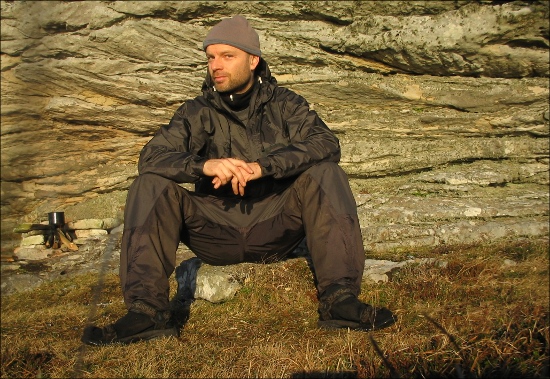
Heath founded the Irational.org collective in 1995, a loose grouping of six international net and media artists who came together around the server irational.org. The collective included Daniel Garcia Andujar / Technologies to the People (E), Rachel Baker (GB), Kayle Brandon (GB), Heath Bunting (GB), Minerva Cuevas / Mejor Vida Corporation (MEX) and Marcus Valentine (GB).
Heath Bunting’s work manifests a dry sense of humour, a minimal-raw aesthetic and a hyper-awareness of his own artistic persona and agency whilst engaging with complex political systems, institutions and contexts. Crediting himself as co-founder of both net.art and sport-art movements, he is banned for life from entering the USA for his anti GM work, such as the SuperWeed Kit 1.0 – “a lowtech DIY kit capable of producing a genetically mutant superweed, designed to attack corporate monoculture”. Bunting’s work regularly highlights issues around infringements on privacy or restriction of individual freedom, as well as issues around the mutation of identity; our values and corporate ownership of our cultural/national ‘ID’s’, our DNA and Bio-technologies “He blurs the boundaries between art, everyday life, with an approach that is reminiscent of Allan Kaprow but privileging an activist agenda.”[1]
In this two part interview we will discuss his current work within two distinctive areas of digital culture and sport-art starting with The Status Project, which studies the construction of our ‘official identities’ and creates what Bunting describes as “…an expert system for identity mutation”. His research explores how information supplied by the public in their interaction with organisations and institutions is logged. The project draws on his direct encounters with specific database collection processes and the information he was obliged to supply in his life as a public citizen, in order to access specific services; also on data collected from the Internet and from information found on governmental databases. This data is then used to map and illustrate how we behave, relate, choose things, travel and move around in social spaces. The project surveys individuals on a local, national and international level producing maps of influence and personal portraits for both comprehension and social mobility.
Marc Garrett: For many years now, your work has explored the concept of identity, investigating the various issues challenging us in a networked age. The combination of your hacktivist, artistic approach and conceptual processes have brought about a project which I consider is one of the most comprehensive, contemporary art projects of our age. The Status Project, deals with issues around personal identity head-on.
Why did you decide to embark on such a complex project?
Heath Bunting:
Three reasons
1. the network hacker
the network hacker fantasises about unlimited access to all systems made available through possession of treasure maps, keys and navigation skills
2. the Buddhist
the Buddhist intends to destroy the self and become only the summation of environmental factors plus find enlightenment in even the most banal bureaucracy
3. the computer scientist
the computer scientist aims to find comfort and hidden meaning in complex data
I am all three and am attempting to combine the obsessions of each into one project.
So far I have
Created a sketch database of the UK system with over 8000 entries
Created over 50 maps of sub-sections of the system to aid sense of place and potential for social mobility
Created system portraits of existing persons
Created software to generate new identities lawfully (off the shelf persons) and sold these identities
I am currently adding more data to the database. Which is split between the human being (flesh), the natural person (strawman) and the artificial person (corporation). Remaking maps using upgraded spider software, researching how to convert my identity generating software into a bot recognised under UK law as a person; and hence covered by the human rights act i.e. right to life and liberty; freedom of expression; peaceful enjoyment of property. I am very close to achieving this.
Did you know that 75% of the human rights act applies to corporations as well as individuals? If you were afraid of corporations in the 90’s and noughties then be very afraid of the automated voices that speak to you on stations or programs that transact currency exchanges, as they will soon be your legal equals as with all Hollywood propaganda, the reverse is true. The human beings will be the clumsy, half wit robot like creatures serving the new immortal ethereal citizens. If you think I am mad or joking, check back in 10 years time.
MG: Way back in 1995, there were already various groups and individuals (including yourself) who were critiquing human relationships whilst exploiting networked technology. Creative people who were not only hacking technology but also hacking into and around everyday life, expanding their skills by changing the materiality, the physical and immaterial through their practice. It was Critical Art Ensemble (CAE) who in 1995 said “Each one of us has files that rest at the state’s fingertips. Education files, medical files, employment files, financial files, communication files, travel files, and for some, criminal files. Each strand in the trajectory of each person’s life is recorded and maintained. The total collection of records on an individual is his or her data body – a state-and-corporate-controlled doppelganger. What is most unfortunate about this development is that the data body not only claims to have ontological privilege, but actually has it. What your data body says about you is more real than what you say about yourself. The data body is the body by which you are judged in society, and the body which dictates your status in the world. What we are witnessing at this point in time is the triumph of representation over being. The electronic file has conquered self-aware consciousness.”[2]
15 years later, we are dealing with an unstoppable flow of meta-networks, creeping into every area of our livng environments. We have mutated, become part of the larger data-sphere, it’s all around us. As you describe, it seems that we are mutating into fleshy ingredients, nourishing a technologically determined world.
HB: Data body is quite a good way to think about it. I consider each human being to possess one or more natural person(s) and each natural person to control or possess none, one or more artificial person(s) (i.e. corporation). The combined total of natural and artificial persons possessed or controlled by a human being can be thought of as their databody. As human beings, we have quite a lot of control over our persons (natural and artificial). The problem is that we either don’t realise this or it takes the time to manage them. It’s possible to obtain a corporation for less than the price of a train ticket between Bristol and London. Why do so many people live without one? Could anti corporate propaganda have something to do with this ?
“What is most unfortunate about this development is that the data body not only claims to have ontological privilege, but actually has it. What your data body says about you is more real than what you say about yourself.”(CAE).[2]
Only if you remain a passive user of it. The natural person is only linked to the human being through such fine devices as a signature, which we decide to give or withhold, most human being’s natural person is actually owned by the government and borrowed back by the human being. This does not have to be the case as we can create and use our own persons.
“The data body is the body by which you are judged in society, and the body which dictates your status in the world. What we are witnessing at this point in time is the triumph of representation over being. The electronic file has conquered self-aware consciousness.”(CAE).[2]
I would say laziness has triumphed over mindfulness. All information about the functioning of natural persons is easily available, all persons have the same rights unless they choose not to claim them. Instead, people choose to get lost in their own selves and dreams, indulged by those that seek to profit from their labour.
Technology is becoming more advanced and the administration of this technology is becoming more sophisticated and soon, every car in the street will be considered and treated as persons, with human rights. This is not a conspiracy to enslave human beings, it is a result of having to develop usable administration systems for complex relationships. Slaves were not liberated because their owners felt sorry for them, slaves were given more rights as a way to manage them more productively in a more technologically advanced society.
MG: Getting back to the part of your project which incorporates a complex process of compiling and creating ‘off the shelf persons’, as you put it. Are you using some of the collected data as a resource to form these new identities, or is it a set of ‘hybrid’ identities?
HB: Please expand this question further…
MG: Near the beginning of the interview, you mention that you “Created software to generate new identities lawfully (off the shelf persons) and sold these identities.” I am asking whether most of these ‘new identities’ that you have formed and sold are, a mixture of different bits of information. Like data-versions of body parts from a machine or vehicle, reused, recycled to recreate, make new hybrid identities?
HB: The identities I can create are all new and legal, they are a portfolio of new unique legal relationships created with existing artificial persons. For example, registering with Tesco Clubcard either creates or consolidates the new natural person http://status.irational.org/identity_for_sale – for a new natural person to be credible, it must be coherent and rational. This is achieved simply by following the rules of the system, the more interrelating links with other persons, the more real the new person becomes.
Off the shelf natural person.
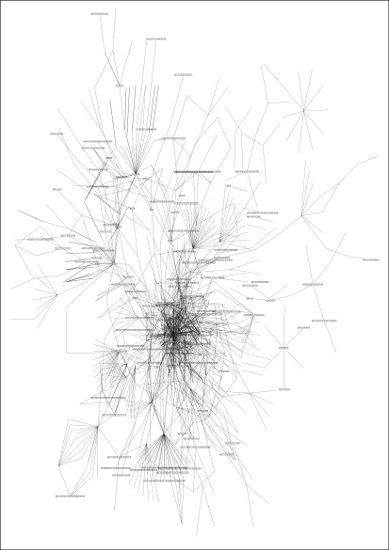
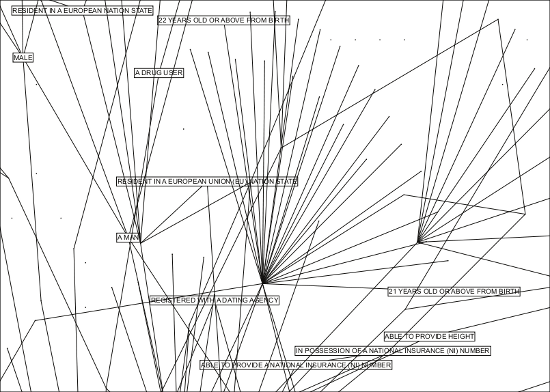
Comes with supporting physical items:
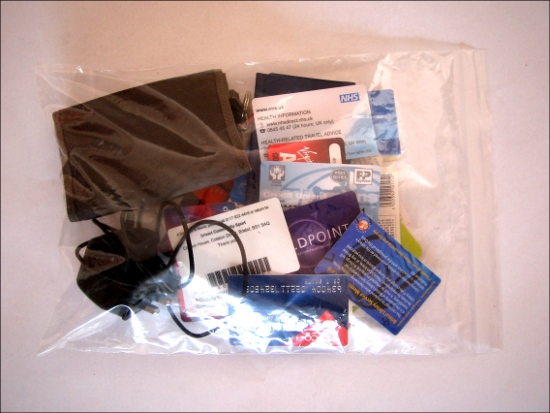
personal business cards, boots advantage card, marriott rewards card, cube cinema membership card, baa world points card, tesco clubcard, vbo membership card, WHSmith clubcard, silverscreen card, airmiles card, somerfield loyalty card, post office saving stamps collector card, virgin addict card, subway sub club card, dashi loyalty card, t-mobile top up card, european health insurance card, waterstone’s card, 20th century flicks card, bristol library card, co-operative membership card, nectar card, oyster card, bristol ferry boat company commuter card, love your body body shop card, co-operative dividend card, bristol credit union card, choices video library card, national rail photocard, bristol credit union account, bristol community sports card, star and garter public house membership card, first class stamp, nhs donor card, winning lottery ticket (2 GBP), t mobile pay as you go mobile and charger…
Upgradable to both corporate and governmental levels.
(500.00 GBP) – SOLD
MG: I can see on the web site, in the section The Status Project – Potentials that there are various ready-mades, ‘Off the shelf natural person – identity kits’. Am I right in presuming that there are individuals out there who have bought and used these kits?
HB: These are mostly existing persons, only one of them was synthetic. I will be setting up a small business soon though to manufacture and sell natural person.
MG: On exploring deeper into the Status Project data-base, there is link to a file called ‘In receipt of income based job seeker’s allowance’. This information is taken from ‘Jobcentre plus’, a UK government run organisation and on-line facility, inviting visitors to search for jobs, training, careers, childcare or voluntary work. How important was this source in compiling data for your database of individuals?
HB: This is only one record of over 8000 in the database, each record refers to one or more other record(s) in the database.
MG: What projects relate to/have influence on The Status Project in some way, and what makes them work?
HB: They Rule[3] – It allows users to browse through these interlocking directories and run searches on the boards and companies. A user can save a map of connections complete with their annotations and email links to these maps to others. They Rule is a starting point for research about these powerful individuals and corporations. A glimpse of some of the relationships of the US ruling class. It takes as its focus the boards of some of the most powerful U.S. companies, which share many of the same directors. Some individuals sit on 5, 6 or 7 of the top 500 companies.
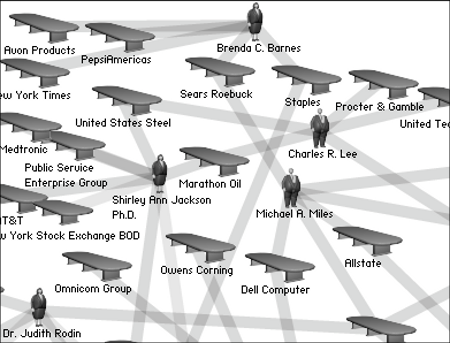
“Go to www.theyrule.net. A white page appears with a deliberately shadowy image of a boardroom table and chairs. Sentences materialize: “They sit on the boards of the largest companies in America.” “Many sit on government committees.” “They make decisions that affect our lives.” Finally, “They rule.” The site allows visitors to trace the connections between individuals who serve on the boards of top corporations, universities, think thanks, foundations and other elite institutions. Created by the presumably pseudonymous Josh On, “They Rule” can be dismissed as classic conspiracy theory. Or it can be viewed, along with David Rothkopf’s Superclass, as a map of how the world really works.”[4]
Bureau d’etudes – distribution.
http://bureaudetudes.org/
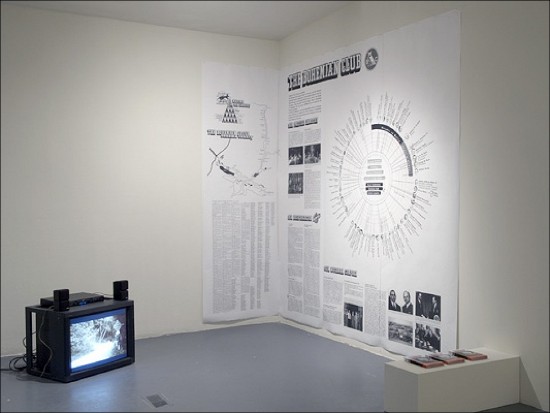
The Paris-based conceptual group, Bureau d’etudes, works intensively in two dimensions. In 2003 for an exhibition called ‘Planet of the Apes’ they created integrated wall charts of the ownership ties between transnational organizations, a synoptic view of the world monetary game. Check the article ‘Cartography of Excess (Bureau Bureau d’etudes, Multiplicity)’ written on Mute by Brian Holmes in 2003.[5]
MG: The sources of data for the Status Project seem to vary in type. Where do you collect them from and how do you collect the different kinds of data?
HB: It ranges from material instruments such as application forms right through to constitutional law and then common sense .
MG: How do you propose the Status Project might be used as a system for ‘identity mutation’?
HB: I want to communicate the fact that people in the UK can create a new identity lawfully without consulting any authority. I intend to illustrate the precise codification of class in the UK system, and there are three clearly defined classes of identity in the UK: human being, person and corporate . I am looking at the borders between these classes and how they touch each other, this can be seen with my status maps. Also, I intend to create aged off-the-shelf persons for sale similar to off-the-shelf corporations.
Taken from the front page of the Status Project:
Lower class human beings possess one severly reduced natural person and no control of an artificial person.
Middle class human beings possess one natural person and perhaps control one artificial person.
Upper class human beings possess multiple natural persons and control numerous artificial persons with skillful separation and interplay.
End of Part 1.
————–
Playing Hard: Urban Art Games of Summer 2010.
Not long ago, urban games were a kind of novelty. Some grew out of the street performance tradition of live theater. Some came from gamers who were involved in tabletop RPG and wanted to experiment with live reenactment. Others were produced by media artists as a way of experimenting with new technologies like GPS and text messaging. But along with these approaches to play, and at times learning from their carefree attitude towards entertainment, there grew another tradition of the urban game, a tradition of using the city focusing on exploration, and as a specific kind of critique. At its worst, the artist produced street game replicates of hollow self-promotion, through corporate, sponsored seasonal festivals. But just as experimental art can involve an analysis of mainstream art, the urban game can embody a palatable critique of the routines of city systems, including the deadening routines of metropolitan life and some of the large scale mechanisms of corporate capitalism.
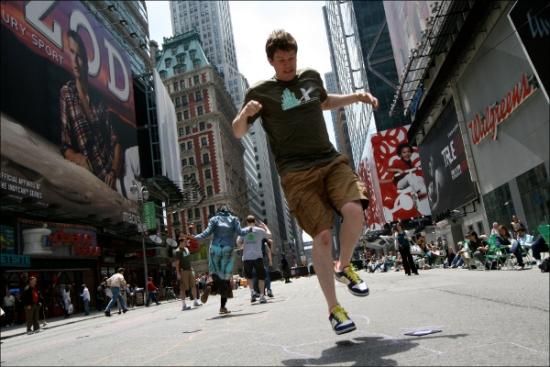
These kinds of games echo the spirit of the Situationist International, which called on artists to create alternate experiences through the construction of situations, psychogeography, and the use of play as a form of critical thinking. Urban games can also remind us of Hakim Bey and his idea of a Temporary Autonomous Zone by using goals, rules, and play with the creation of the ‘magic circle’, a world inside a world, as a method of directing public imagination towards an alternative presence, a way of acting and existing as an independent community within a larger, more repressive reality, even if only momentarily. Urban games also continue the Fluxus idea of the ‘happening’, a participatory media form in which audiences support artists, moving beyond the role of observers of performance to become collaborators in events. With the urban games season about to begin, this review takes a look at how several groups, either consciously or at times not so consciously, have interpreted these traditions for summer 2010.
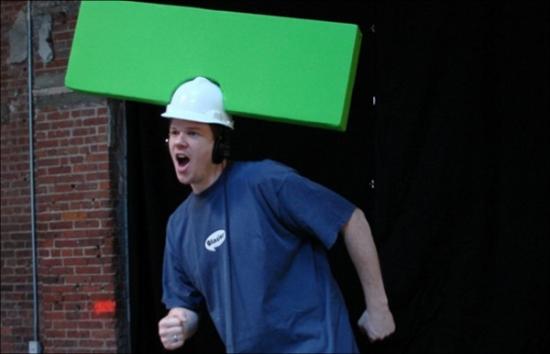
In New York, the much loved Come Out and Play Festival will run from June 4th through June 6th, with events scattered throughout the city borough of Brooklyn. Games include playground mods, GPS exploits, extreme sports, narrative quests, and massively multiplayer scavenger hunts. The festival hosts about forty game designers from around the world and about two thousand people will attend. Executive producer Greg Trefry says COaP strives to be entertaining and is not so much concerned with philosophy as it is with place: “Where the festival is located each year is actually really important to us. We look for interesting parts of the city to experiment on and use as the stage for the festival. So we’ve played everywhere from big anonymous urban areas like Times Square to now more family oriented locales like Park Slope.”
Still, the designers of COaP seem to have a way of engulfing serious issues with comedy and encouraging people reclaim neglected parts of the city by giving them a second look. Along these lines, Atmosphere Industries of Toronto will present Gentrification, a game that picks up on Brooklyn’s ongoing housing conflicts by asking players to assume the roles of real estate developers or neighborhood locals while collecting properties and gentrifying neighborhoods. Meanwhile, Gnarwhal Studios of Baltimore will sponsor ‘Humans vs. Zombies’, a modification of the playground game tag that introduces large groups of strangers to one another by sending players out into the city as the walking dead.. It’s hard to sit in a park, completely shut off from everyone around you, during a two hundred person simulation of a zombie attack. Also part of COaP, New York’s Crux Club will confront community fears of toxic contamination through their game ‘It Lurks in Gowanus’, a hide-and-seek mod that asks participants to track down a creature who has ominously escaped from legendary pollution of the neighborhood’s Gowanus Canal.
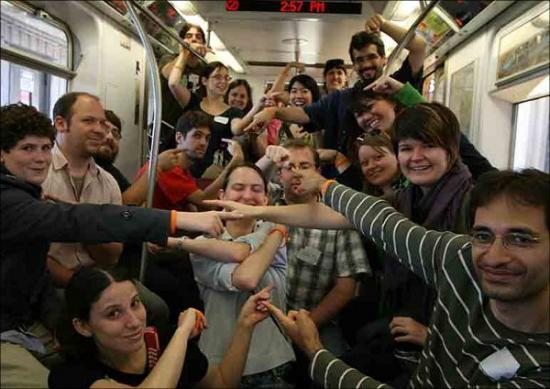
Although he agrees that all urban game events take some kind of cue from historical antecedents like the Situationist International or Fluxus, producer Trefry resists making a formal connection between these movements and COaP. Instead, he says, the main concern was and continues to be community building, getting people together in a surprising way and in an unexpected space: “At its heart, the festival is about running around outside and having fun with your friends. It sounds silly, but that’s such an amazing thing to experience.” This goal of community building has caused COaP to inspire other urban games festivals, including the Hide & Seek Festival in London and the igFest in Bristol, and the Steel City Games Fest in Pittsburgh. The organized versus the random, or the juxtaposition of the carefully designed structure of a game with the largely unstructured, seemingly arbitrary activity of ordinary public space continues to be a common interest among COaP design groups, which are likely to include engineers, academics, and urban planners alongside artists and actors.
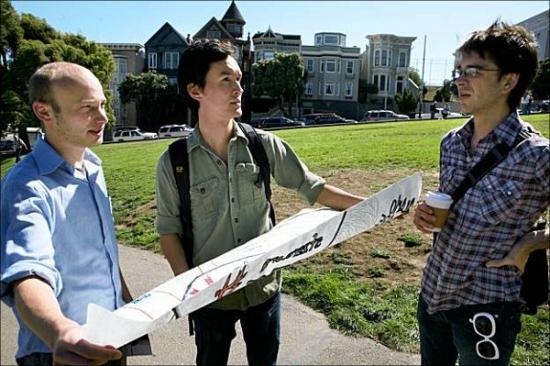
In San Francisco, the artists of SFZero cite Situationism and Fluxus as fundamental to their practice. The SFZero collective was founded by Ian Kizu-Blair, Sam Lavigne, and Sean Mahan in January 2006. Initially, the group used something like a Fluxus process of writing instructions for happening-like events that teams of other players acted out. Soon, these collaborations became the basis for both an online community and real world urban games network that now include over five thousand players. Through the SFZero website, participants initiate events by challenging other participants to ‘Eat a food that frightens you’, or ‘Go to a street corner of your choosing and wait for something fantastic to happen.’ SFZero seems to agree with classic Situationist objectives. A good game shifts awareness, Kizu-Blair says, changing the city for the people who play: ‘Oftentimes the players report that they have a completely different experience of the urban environment as a result of playing and go to places in their city where they have never been before. There is a cinematic quality whereby players live out experiences that normally exist only in spy movies – chases down dark alleys, chance meetings, etc.’ Typical SFZero tasks range from exploring overlooked locations in the city to taking a chance on meeting new people.
As fantastic as some of these instructions sound, and as important as the Internet is to SFZero’s success, Kizu-Blair says it is essential that some productions have a real world component: ‘As people become disenchanted with eight plus hours per day of screen time, they are increasingly gravitating towards hybrid activities that bridge the space between the virtual imaginary and the physical real world. These activities blend the safety and simple pleasure of screens with the risk, tension and excitement of physical interaction. More and more, members of our society will seek to escape from escapism towards an ethics of action, to escape from movies to real experiences. They will find that they have little idea how to have real experiences after their time in the imaginary. SFZero is the transition. ‘SFZero offers both real-world excitement and eternal return to the screen, to re-live, re-experience and re-imagine your engagement with reality.’
Recently, Kizu-Blair, Lavigne, and Mahan have begun staging riskier, more elaborate game events like ‘Journey To the End Of Night’, in which runners try to make it through six checkpoints on foot or by public transportation, while avoiding capture by chasers. An early version of Journey actually opened the 2006 season of Come Out and Play. This July, the veteran SFZero player Lincoln will stage a further production of Journey in Los Angeles.
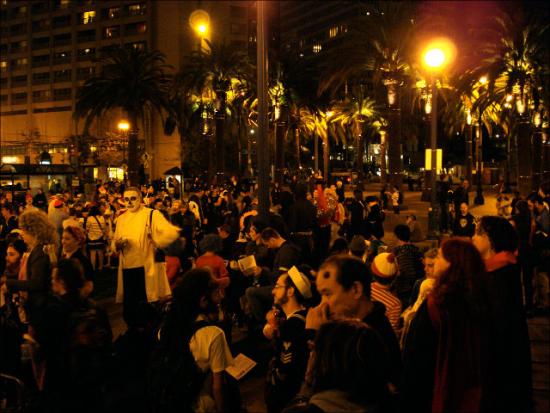
This summer, SFZero will present The Wanderers Union, a game that is loosely based on a French style of self-supported long-distance cycling called randonneuring. To perform Wanderers Union, players get a set amount of time to travel on foot and by public transportation through a series of zones. The idea is to create a single holistic experience of a urban area. The journey intends to juxtapose city spaces in ways that reveal meanings that might otherwise remain unobserved. Players who complete all of the events will progress from an initial four hour wandering to a final twenty-four hour wandering. By using play as a means of gaining understanding, participants will hopefully gain a small degree of mastery over urban space. Kizu-Blair says: ‘It’s like a video game – you level up and gain powers – but you have the added satisfaction of doing something real, and you can include anyone in the experience.’
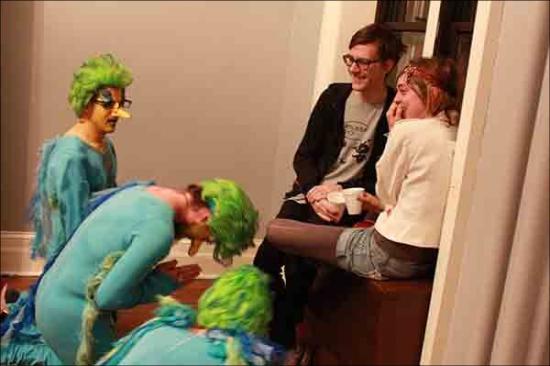
Back on the East coast, the New York based artist’s collective Opt-In found that what started as a thesis project for an experimental film class unexpectedly became a series of multimedia events that now includes filmmakers, fine artists, dancers, performers, and musicians. Titled ‘ZeroDay Exploits’, these evenings are the work of Bryn Jackson, Sarah Lerner, and Nathaniel Barker, who says the group has adapted the Fluxus concept of “happening” to the 21st century: ‘We create immersive environments in which strangers and friends can form new communities around a project, an idea, or a simple good time. We bring people from all walks of life together by promoting open dialogue and the creative expression of public discourse through a vast array of mediums and the use of public space.’
Past themes for the Opt-In exploits have included faith and technology. This July, the group plans to explore the idea of “home” by inviting guest artists and guests to contribute items and materials that evoke a sensation of home. The goal of this event is to create a sense of rootedness in New York, a city of perpetual resettlement. Another major goal for Opt-In is the deconstruction of the digital experience through live performance. According to Barker: ‘Our focus has always been on participation, so our events offer multiple means for encouraging visitors to get their hands dirty including music, secret actors to stimulate conversation, inclusive performances, and free art materials for spontaneous art creation.’
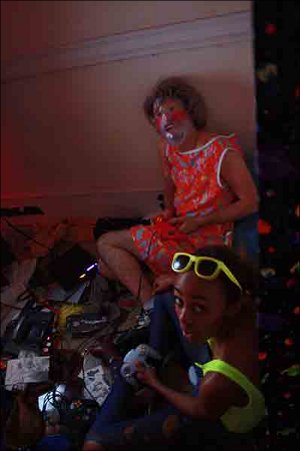
Also related to Fluxus, but in a gesture that seems more directed towards the Brazilian director Augusto Boal, a group calling themselves Invisible Playground Berlin, uses the urban game as a kind of political visualization. Founded by the artist known as Sebastian Quack Sebastian, this group’s interests lie at the intersection of theater and digital gaming. In ‘F Be I, See I A’, Invisible Playground re-enacted peer-to-peer communication as a giant game of urban capture the flag. Later, in Space Station Escape, the group simulated the release of an alien virus inside a phantom space station supposedly docked underground beneath Alexanderplatz.
Sebastian views missions and rule sets as ‘experience systems’, Games are a kind of participatory appropriation, an interrogative code that is placed over or enacted within an existing urban mechanism. In other words, if you want to get people to think more critically about the way immigration works in your city, you’d design a game that plays with the existing locations, activities, and mechanisms of immigration. In this way, Invisible Playground intends to put forward what otherwise goes unnoticed, tolerated, or is even passively accepted. Sebastian is careful to structure his rule sets in ways that highlight the power structures that arise between groups of players, between players and their environments, or between players and organizers. According to the Schwellenland site: ‘Players must work together and against each other. Over SMS and email you are guided to appointments and arrive at places where you were barred from entry until now. The game asks you to decipher who is legal, who is questionable, who can be trusted, who will trust you, who observes you, what should be ignored, what is critical. You are accompanied by a coach and by referees who left the usual national borders behind long ago and are now in Vienna as refugees without papers. These specialists can help you to master the challenges of being from a developing country. But they have also power to turn on you if you make too many errors.’

Finally, with a practice based in both New York and in Brazil, Adriana Varella is one of the artists behind the AnarkoArtLab, a collective of new-media, visual, dancers and genre benders in residence at the Living Theatre. Each month, Anarko creates a multimedia event that runs as part lab, part performance. This summer, the group plans to become mobile and to bring the Lab to different situations and neighborhoods. ‘We are searching,’ Varella says ‘for a last trace of that most ephemeral and elusive state where only a dusty dystopian haunting may yet remain. ‘Of course,’ Varella says, ‘all of them, Dada, the Situationists, Fluxus they are all our ancestors.’
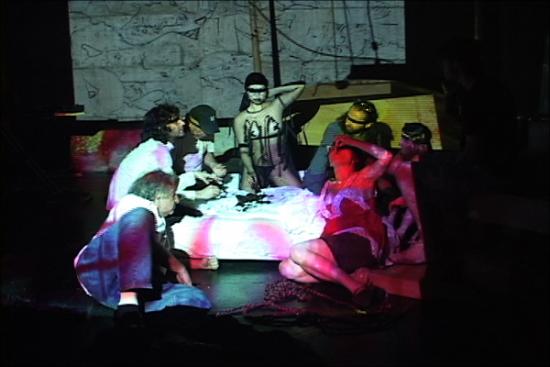
Patrick Lichty, renowned conceptually-based artist, writer, curator and activist. He has exhibited internationally since 1990. Featured image: taken by Anne Helmond.
Introduction.
Patrick Lichty is an individual who seems to be like a non-stop engine. A hungry human being, engulfed in a prolific journey of constant exploration, whether it be making artworks, writing, activism, curating, collaborating, researching or teaching; he’s deeply involved and engaged in media arts culture. Since 1990, he has pursued art and writing that explores how we relate to one another through technology and how we relate to it. This includes art, media, and computer technology. “Media are one of the “glues” of civilization, and this glue is as fundamental in representing all aspects of society, culture, and interpersonal relations. I explore this through critical theory, conceptual New Media art, and performance/social intervention.”
Lichty also works in almost all forms of Digital 3D – Animation, VR, Fabrication, Physical Computing. Translating the work for display through video, animation, live installation, electronics, virtual reality, physical computing, robotics, digital fabrication and imaging. As well as realising virtual works into traditional forms such as plates for print, paintings, expanding the focus of his work in a broader context.
Lichty’s work, concepts and practice do not rest in one place, it crosses over into many areas of creative production. By getting his hands dirty with the medium of technology, with its relational aspects. The spirit of the work goes beyond singular catch phrases and one-liners, adding complexity and value which only media art and its ever widening scope can demonstrate.
It’s big art with big ideas, interwoven with micro levels of human emotion, asking questions about life and more. This two part interview aims to clarify some questions I have been wanting to ask Patrick Lichty for a while now, so hang on and lets see what happens…
Start of Interview:
Marc Garrett: You have been deeply engaged in the creation of net art, networked art, media art and related activities at various levels, whether it has involved you making it, writing about or curating it. What inspired you to choose which is, now unquestionably, one of the most contemporary and expansive forms of creativity, in the first place?
Patrick Lichty: This is a question that has come up repeatedly. “Why did you choose (what is now called) New Media, or the intersection between society, technology, and culture?” It is really a matter of examining my native culture, which has been that of technological culture. I was raised by an artist who gave me my first electronics set at the age of 8, and my first computer by the age of 17, while raising me on a steady diet of science fiction. I was a child of McLuhan; growing up in the electric networks on a diet of very hot media. However, I do also paint, and when I think it’s appropriate, I also do use traditional media. In short, I speak this culture because it’s my native language.
MG: To kick off this interview I thought it would serve our readers well to discuss your work from a perspective of themes. Over the years, exploration through your practice has crossed over into many different disciplines and fields. So lets begin with Psychogeography. To those who are unfamiliar with this practice, the most well defined and serious use of it was in 1955 by Guy Debord: “a whole toy box full of playful, inventive strategies for exploring cities … just about anything that takes pedestrians off their predictable paths and jolts them into a new awareness of the urban landscape.”
“Of all the affairs we participate in, with or without interest, the groping quest for a new way of life is the only thing that remains really exciting. Aesthetic and other disciplines have proved glaringly inadequate in this regard and merit the greatest indifference. We should therefore delineate some provisional terrains of observation, including the observation of certain processes of chance and predictability in the streets.” Introduction to a Critique of Urban Geography. Guy Debord
Patrick, one of your projects which springs to mind, is a work called SPRAWL “…an exploration of the suburban American landscape, examining the macrocosmic issues related to suburban expansion by considering the microcosmic issues of the experiences of a bellwether area of the US: Stark County, Ohio. In navigating the landscape you will view over thirty panoramic photographs of sites that are now forever changed by the area’s development as well as interviews on video and historical documents which create a map of the larger social landscape of the surrounding community.”
A complex and involved project. What inspired you to examine the ‘suburban American landscape’ in such a way, and how long did it take to complete?
PL: In talking about Debord’s definition, I’d like to talk about my own interpretation of the idea of Psychogeography. If you consider the word etymologically in contrast with Debord’s meaning, you can say that it should not be limited to the urban landscape, but the relationship of human interaction with any landscape. From this, we move out of the city to any relation between community and space, which is my interest, and I like to term as a practice of ‘land use interpretation’ to borrow Matt Coolidge’s (CLUI) term. All of my work in this range, from SPRAWL to the three projects in varying stages of completion (the Hulett Project, Ghosts of Adak, and SPRAWL 2011) come from a personal observation that expands to a macroscopic discourse through the larger exploration/research of the space.
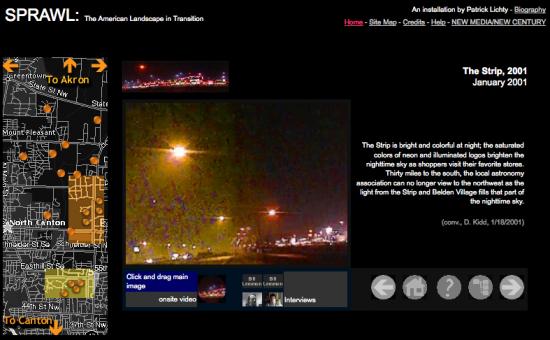
SPRAWL began as a 3-year personal investigation of my own distress about suburban sprawl in the late 1990’s near my home town, and linking this to the larger national conversation regarding sprawl at the time. For reference, I was born in nearby Akron, Ohio – the subject of Chrissie Hynde and The Pretenders song My City Was Gone, which describes the colonization of an industrial city and its countryside by sprawl and shopping malls, so if SPRAWL has a soundtrack, that would be it. I began SPRAWL in 1998, as a series of panoramic photographs of various sites near my home, with just a vague impression that they were a cohesive body of work. Also, the idea of nostalgia for the pastoral farmland of my younger days seemed far too simple to be satisfying, so I knew there was something to it. So, when the Smithsonian American Art Museum put out a call for works dealing with landscape online, I felt this was a fantastic place to really explore this idea in a larger context. Then they offered me the commission, the project went from a set of 32 panoramas to a hyperdocumentary in about three solid months of production, including travelling back to Ohio from Louisiana, interviewing, doing on-site footage, and performing historical research.
What I think is important about SPRAWL is that it’s ‘sensable research’, in that it managed to manifest the ideas I had about this problem, learning a lot more about community ecology, allowing the articulation of a microcosmic issue in macroscopic terms. In more personal terms, it allowed the development of my question of social issues related to my concern with the understanding that my perspective was only one of many, and from examining a multitude of perspectives, I could learn what the larger issues were, and create a discourse with a larger community.
MG: On your website, for the Ghosts of Adak there is a statement of yours, saying “My father and I have something in common. He was born in 1921 and spent 2-1/2 years in the North Pacific campaign on Adak Island in the Western Aleutian Islands in Alaska. I have heard about it since 1962. So I went there for 10 days. And I found him all over again.”
I also visited another site to find out about the community living there, and on this site called Alaska Tracks. Ned Rozell writes “Adak’s having a tough time, and the community of about 200 people in the mid-Aleutians has been struggling since the Navy pulled about 6,000 people out in 1997. It’s got a feel to it now like the Love Canal area of Niagra Falls had in the 1980’s, like everyone took off and left a few ghosts behind.”
How was your 10 days stay there and what did you learn?
Do you have a clear idea of what this project will become? Also, I noticed that it is part of an artist residency program at Eyebeam R&D Atelier NYC. How do you intend to present this work, in a space, on-line or something else?
PL: That’s a book in itself, and probably will be, which is part of your next question. First, why – My father is nearing 90, and for most of my life, he had gone on about this “place” that he had been for a period of time, and recounting endless stories about it. No place else had that sort of impact on him. Does not talk about Seattle, or San Francisco, or even Chicago (all places he had spent time) like that. I also think that as he is nearing 90, and in that he and I have a very strong bond (actually both Lodge brothers, if you can believe that), and I wanted to know about him in the deepest way possible, and probably in so doing, learn about myself and the site. But then, that fits the process.
The issue with Adak is that it is a tremendously complex place even before I overlay my own emotional architectonic. It was the site of the Northern Pacific campaign of the United States versus Japan during the Second World War, mainly as a diversion from Midway. I had made a deal with the CEO of the facility to exchange the photos for a room, a 40-something Niigata-born guy with petrochemical ties, whose father might have been my father’s enemy, and ideologically, probably was mine, but the personal nature of the trip put that on hold. There were a lot of external and internal conflicts that I had to navigate just to get there.

In short, Adak is currently the remains of the Adak Naval Base and surrounding facilities, which is basically a minor port, petrochemical storage facility, a fishery, and home of the westernmost airport linked to the Continental US, further west than Hawaii. If you rent a car, you rent one of the trucks a local offers, the gas comes from the tank farm, and the ‘hotel’ is a number of duplexes that the residents rent out to visitors. There is a General Store, a cafe at lunchtime, and the old VFW becomes the tavern for dinner, offering an entree or some microwaveable snacks along with a full bar. You sign a disclaimer to absolve the Corporation of any liability if you encounter black mold, fall into an old stairwell, sinkhole, run into an old unexploded shell, etc. I’m speaking a little darkly about this place, but it’s pretty rugged with radically changing weather, frequent earthquakes, and they’re still cleaning up the old artillery ranges.
On the other hand, it’s one of the most amazing places to be. It’s right at the edge of civilization, a volcanic arctic island withn no trees and some of the most amazing wildlife you’ve ever seen – eagles, otters, seals, birds. I can see why my father talked about it so much.
One other thing of note is that while doing the project, I’ve run into all sorts of people who have served, lived, or even been born there, as there was a 6,000-person family facility. On the plane from Minneapolis to Anchorage, I ran into an airline pilot who had just been on a caribou hunt there, and he gave me his GPS information and a lot of pictures. On another trip, I ran into a woman who was born there. It was unbelievable.
What did I learn? I learned about a history that few remember, I learned about my own history and how it affects me. I also learned about the local culture, its history, how Alaskan culture meshes with corporate interests to create a lot of the issues seen in mass media. There isn’t a lot of concern for the area from the locals, and actually the Military was doing a decent job with the cleanup. From a more personal level, I also came to understand that everything is transitory. Art, culture, society, all ephemeral in terms of a mountain. Human beings don’t matter very much to a volcano, but definitely the other way around.
When I was walking on the western (uninhabited) side of the island, I had napped on some tundra and realized I didn’t have my GPS or keys – all my keys. I knew where I slept, and I leave my keys in the car a lot. The worst that could happen was that I would have to walk 5 miles into town in a cold drizzle, get Jimbo the Constable to let me into my car and get the truck in the morning. In the end, I learned that if it isn’t a landmine, it’s not that big of a deal.
“Do you have a clear idea of what this project will become? Also, I noticed that it is part of an artist residency program at Eyebeam R&D Atelier NYC. How do you intend to present this work, in a space, on-line or something else?” This is really tough for me – no, I don’t have a clear idea yet because it’s so hard to frame. It probably needs to be a book, but it isn’t going to be done for a couple more years. I’d like it to be a hyperdocumentary like SPRAWL, but not in the same way. Also, I think it would make a great presentation, and the images are really beautiful. As I mention, it’s terribly hard to frame this project, and I think it should be allowed to be large.
MG: Let’s talk about a piece you created with The Yes Men. As many in the know, know – and of course those who have fallen foul to the Yes Men’s activist-pranks; they are legendary cultural saboteurs. They have impersonated World Trade Organization corporate spokespersons, including Dow Chemical Corporation, Bush administration spokesmen on TV, at various business conferences around the world. In order to demonstrate some of the mechanisms that keep bad people and ideas in power. Focusing attention on the dangers of economic policies that place the rights of capital before the needs of people and the environment. They have more recently become more known to a world-wide audience for The Yes Men, a movie.
Could you inform myself, and readers about the mock industrial video ReBurger and how it came about?
PL: Right. The animation work for The Yes Men is a strange beast, because it came from previous work for a group called RTMark, from which some of us came from to do Yes Men, which is well documented in the two movies. Again, the process for these animations, which I later edit into industrial videos is also an odd one. Usually, when there is an intervention (and I have sometimes appeared in person), Mike will give me a call and say something like, “Hey Patrick, we have this idea for this, for that company…” In this case, it was an idea for recycling feces for the Third World, and not much beyond that general concept. At first, I was thinking of translating dietary fiber to textile manufacture, creating a suit that would look like S**t, but shortly thereafter, brainstorming created the McDonald’s parody. I knew it was going to be shown at Plattburgh College, but beyond that, I didn’t have much context. So, that’s where my process in context with the larger presentation sort of diverges. Mike, Andy and Matt were developing the presentation, and I started in on the simple metaphor of eating shit. In short, I get some basic ideas together, and then produce the clips (not the full industrial video).
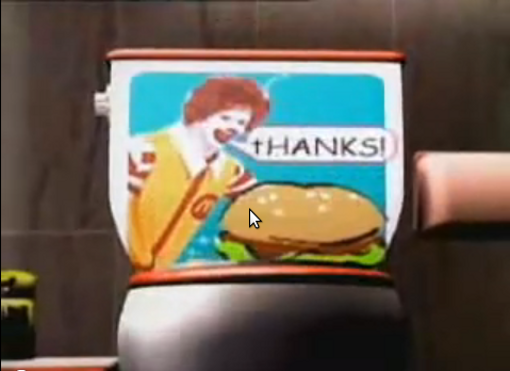
Beyond that basic joke, it’s really just exaggeration – the idea of an international infrastrucure for the collection of post-consumer waste, the branded toilet, and the special product names, like “McDung”. The scene that seems to get people is the one of the Ronald McDonald Colostomy Machine (the paste dispenser) as it creates the brown coil of reprocessed waste and then presses it into nice patties. For me, this is the use of pure literal metaphor, and maybe that’s why it works. Maybe it’s because it stands for a corporation that offers “choices” for healthy eating that few choose, and McDonalds willingly contributes to the obesity and illness of billions. In my opinion, ReBurger just tells the truth.
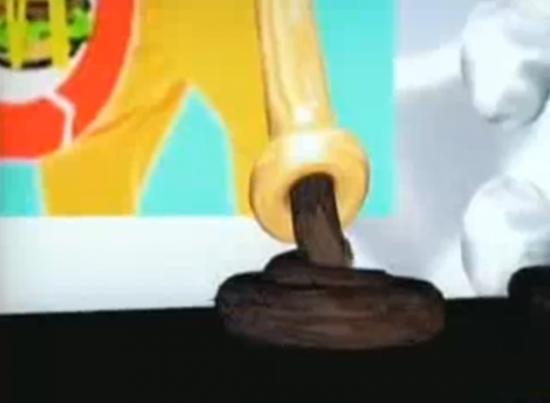
But the reason why people like the video is also a reason why it was a real problem for the sale of the movie at Sundance 2003. Although it was obvious fair use, many in the film industry were also buyers looking at the movie. Mike Bomnano told me that the legal departments of the movie companies were trying to determine the degree of risk of satiring McDonald’s, complete with branding. This was obviously Fair Use under US Copyright, but again, the possibility of an egregious law suit could have happened. In the end, McDonalds decided to ignore the piece, which was great, since I believe it’s one of the stronger Yes Men pieces.
MG: In the UK, June 1997, the infamous McLibel Trial (mcspotlight.org) came to an end. The case was between McDonald’s and a former postman and a gardener from London, Helen Steel and Dave Morris. It ran for two and a half years and became the longest ever English trial. “…Helen and Dave decided that they would stand up to the burger giants in court. They knew each other well from their involvement in community based campaigns in their local North London neighbourhood and felt that although the odds were stacked against them, people would rally round to ensure that McDonald’s wouldn’t succeed in silencing their critics.” The defendants were denied legal aid and their right to a jury, so the whole trial was heard by a single Judge, Mr Justice Bell.
“The verdict was devastating for McDonald’s. The judge ruled that they ‘exploit children’ with their advertising, produce ‘misleading’ advertising, are ‘culpably responsible’ for cruelty to animals, are ‘antipathetic’ to unionisation and pay their workers low wages. But Helen and Dave failed to prove all the points and so the Judge ruled that they HAD libelled McDonald’s and should pay 60,000 pounds damages. They refused and McDonald’s knew better than to pursue it.” Mcspotlight.
I can imagine that McDonald’s were considering their past experience, with cases such as the McLibel Trial. “The legal controversy continued. The McLibel 2 took the British Government to the European Court of Human Rights to defend the public’s right to criticise multinationals, claiming UK libel laws are oppressive and unfair that they were denied a fair trial. The court ruled in favour of Helen and Dave: the case had breached their rights to freedom of expression and a fair trial.”
For your project 8 Bits or Less, in 2002, you wrote a brief statement which I am assuming must be about your own condition, saying “An artist who has become blind (whether physically or ideologically) has resorted to viewing his world through the prosthetic devices that constitute his sense, like cell phones, and wristcams. The result is a distorted landscape that considers Situationist theory, surveillance culture, identity, and alien abduction.” Can I begin by asking why this statement came about and then what part of the project you feel communicates or is expressesed most successfully?
PL: First on the matter of ReBurger, I think that the smarter entities know not to react, but that isn’t always the case. Perhaps the ones who have been burned, now have a smarter PR team.

8 Bits or Less is a series I did that was influenced by several things. For many years, I had felt that as technological artists we are slaves to “innovation”, which is merely an exciting word to stand in for the commercial upgrade path in software and hardware. This set of videos addresses my dissatisfaction with the notion of verisimilitude in regard to techological art, or the “big ticket” piece. Ever since the late 1990’s my response has been to either get by with just enough aesthetic polish to make the work believable/legible, or to willingly embrace a low rez/grayscale time. The lo-fi grayscale is not the same as 8-Bit, which has 256 colors and refers to early personal computing and video games. Perhaps it is closer to my passion for Slow Scan television (a 1970’s video modem technology in which a frame is transmited every 7 seconds) or my position of eschewing resolution and color depth as a form of intransigent aesthetics. In addition, the fact that the frame rate is at most 3 frames per second, and was shot with a Casio Wristcam at one frame every 1.5 seconds was also my homage to Muybridge, mainly in terms of the grayscale and serial qualities of the video. Beyond that, and the fact that each video consists of about 900 frames, all hand edited, perhaps 8 Bits or less is more about my politics about the technological industry and personal differences with New Media and technolust.
On the personal side, 8 Bits or Less is an allusive fable having to do with the fact that I have been blind a couple times in my life, but this blindness can translate to the fact that for a period of time I felt that I had immersed myself in my studio for long enough, that I saw the world primarily from my screen. Therefore, although I had been visually imparied for part of my life, much of which has been fixed by having cataract removal in 1999, I still felt that there was a metaphorical blindness caused by society’s use of mobile devices, the existential distorions of 24-hour cable networks and the Internet. Therefore, the series (if you listen very closely) incorporates a mix of postmodern theory and hyperbolic statements about aliens, obscure jokes about bits and nybbles, surveillance culture and the abjection of low fidelity.
What I think is successful about it is that it holds together at all, or that it engages the viewer without necessarily relying on leading edge technological conceits, but perhaps using the wristcam aethetic is a conceit in itself. Antoher aspect that I have enjoyed about it after five or six years is that it is a really hallucinogenic series of pieces. But then, I think this is the point that Gibson made about cyberspace that has been expanded on by the Baudrillardian mediascape and the Internet – the consensual mass hallucination (facilitated by mass communications).
———
Watch 8 Bits or Less series. Images link to videos online.
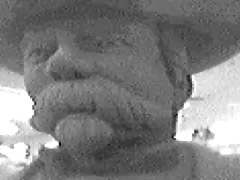
A wristful of bits. Found on DVlog.
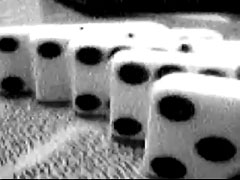
8 bits or less. Found on DVlog.
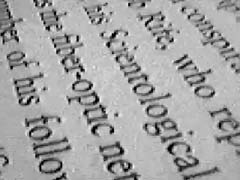
http://www.dvblog.org/movies/04_2007/lichty8bit/closevision.mov
Close vision. Found on DVlog.
Big thanks to DVblog for 8 Bits or Less images & video links.
http://dvblog.org/
Decode: Digital Design Sensations
The Victoria and Albert museum, London
8 December 2009 – 11 April 2010
Decode: Digital Design Sensations at the Victoria and Albert Museum (V&A) brings the state of the art in art computing to a venerable cultural institution. Everything from the posters and banners around town to the hoardings on the entrance to the gallery containing the show makes it clear that Decode is a serious cultural event. It’s a spectacle, a dark space alongside the well-lit galleries of the V&A, drawing you in with points of light and distant sounds. The crowds are reassuring for the popularity of art computing yet disconcerting for the experience of the art at times.
Don’t forget to ask for a catalogue as you hand over your ticket on the way in. The sponsor’s foreword should raise a smile to anyone familiar with the software industry, but the introductory essay (which only occasionally becomes the latest casualty of the confusion that the word “open” shows), the details of works in the show and the interviews with Golan Levin and Daniel Rozin are all very informative. The catalogue also draws attention to Karsten Schmidt’s specially commissioned graphic identity for the show, which can be downloaded and modified as Free Software.
The show is divided into three sections. Generative art, data visualisation, and interactive multimedia (or, as the catalogue puts it – Code, Network and Interactivity).
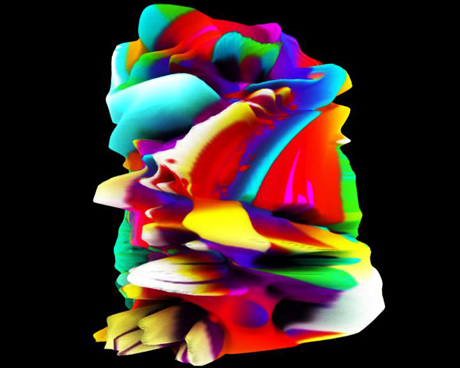
The generative artworks suffer in comparison to the other pieces by being mostly small-scale screen based pieces. However appealing the images are on the screen (and they are) they cannot compete with the projections and three dimensional installations of the other sections. With the exception of an interactive version of the video to Radiohead’s House of Cards by James Frost and Aaron Koblin, the work does not refer to the human figure or to the viewer, another feature of many of the most popular pieces in the other sections. And apart from Matt Pyke’s typographic totem pole, my other favourite piece of the section, the work is calm. Beautiful, but calm. It would reward prolonged contemplation in a quieter environment and might benefit from presentation on a larger scale to better bring out its aesthetic qualities. But this is not that environment, and that presentation is not given to the work here.
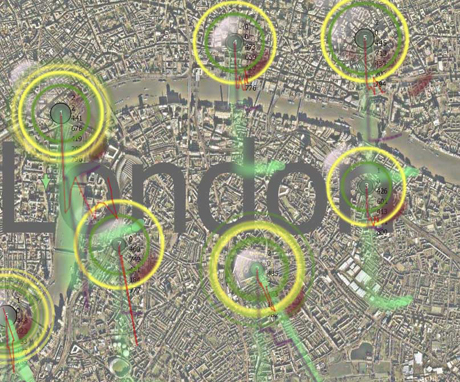
The data visualisation section has more projections and custom hardware, and also has more human interest. The emotion of We Feel Fine by Jonathan Harris and Sep Kamvar, the surveillance state expose of Stanza’s Sensity, CCTV assemblages, Make-Out, the porn-inspired kissing figures of Rafael Lozano-Hemmer and the social data visualizations of Social Collider by Sascha Pohflepp & Karsten Schmidt are sometimes less visually sophisticated than some of the generative pieces, but address current social and technological developments more directly. The world wide web is twenty years old, it has drawn in the mass media and media feeds from the real world, and many of its users produce and encounter gigabytes of data over time. Representing and exploring that technological and cultural environment is something that art can do and that art is particulalry well placed to do given the importance of the aesthetics of interfacing and visualisation to the contemporary web.

The interactive multimedia section contained the real crowd pleasers of the show, although some of the pieces had “out of order” notices on them when I visited. Yoke’s virtual reality Dandelion Clock controlled by a hairdryer, Ross Phillips’s Videogrid, a physically interactive group portrait and Daniel Rozin’s Weave Mirror, a cybernetic sculpture-cum-display-screen. They all give their audience an aesthetic experience that briefly changes their relationship to the world, and in some cases shows them themselves in that new relationship. Interactive multimedia installation is clearly due a resurgence.
The V&A have presented Decode as a design show. I was struck by this framing of the work when I visited the show, and most of the people I have spoken to about the show since have commented on it as well. Many of the participants are graphic designers or work in design as well as art and education, but much of the work would be poorly served by being regarded as design rather than as art. It is not advertising, or presentation of anything other than itself for the most part. Where the work is information design, the information has been chosen by the designer. That said the art computing MA I attended as a student had to be called a “design” course to get funding, so possibly this is a constant. And the V&A have done a great job of presenting the work and letting it speak for itself to the visiting crowds.
This isn’t quite Cybernetic Serendipity 2.0. It excludes the conceptually and performatively, rougher edges of contemporary art computing. But these exclusions are largely practical; there is no livecoding and there are no email or self-contained web browser-based works. Some of the work is strikingly but subtly political in its representation of current social and political trends such as surveillance, online pornography and the death of privacy.
The V&A have done the conventional artworld and the general public a great service by presenting Decode. The show contains enough big and up-and-coming names in art computing and digital design to provide a convincing if necessarily incomplete survey of the contemporary scene. Decode also serves an important role for artists and students with an interest in or a stake in art computing by focussing attention on what others have achieved that can be built on.
Decode shows the achievements of the personal computing and web eras of art computing becoming established with and recognized by the broader arts establishment. The danger is that the story will finish triumphally here. Processing has become the new Shockwave, and particle systems and shape grammars are not enough in themselves for long without an accompanying progressive and deeper deeper engagement with the aesthetics and history of art, technology, wider society, or all three. Art computing is not immune to technical and aethetic conservatism. To avoid this I think that it needs to intensify, to become more like itself; to become more beautiful, to tackle larger datasets, to become more interactive. In other words, it needs to build on the achievements gathered together and presented here.
http://www.vam.ac.uk/exhibitions/future_exhibs/Decode/
The text of this review is licenced under the Creative Commons BY-SA 3.0 Licence.
Image: SMartCAMP logo, all images courtesy of SMartCAMP
Part of New York’s Art Week, SMartCAMP, or social media art camp, took place on March 5th and 6th, at the Roger Smith Hotel in New York, a slightly unusual kind of place in that it’s a hotel with its own production company. That company’s artistic director, Matt Semler, who is also the director of The LAB Gallery, became interested in the ways Roger Smith marketers Adam Wallace and Brian Simpson were using platforms like Facebook and Twitter to build an online community. According to Semler, his curiosity “ultimately led to more questions than answers and we found ourselves wanting to bring the leaders in the social media (SM) art world together to talk about their process, goals and best practices. Once we came up with the name SMartCAMP we were pretty much off and running.” Conference organizer Julia Kaganskiy of New York’s Arts, Culture, and Technology Meet Up curated SMartCAMP’s program and a former actor, Danika Druttman, handled communications for the event.
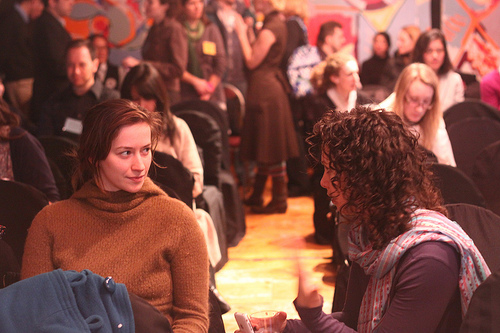
In other words, from the beginning SMartCAMP was about people, people who post, blog, tag, add, and tweet, but above all, people who meet and link up through quirky, often unpredictable, circumstances to pursue a shared idea. According to the speakers in SMartCAMP’s program, this is the kind of easy serendipity that gives social networks their authenticity and value. While these qualities can’t quite be summoned, they can be encouraged and directed. For artists and administrators, the question is how to sustain these connections to build audience and patron loyalty. Whether you like the idea of artists taking on their own distribution, or whether you find it somehow uncomfortable, social media is influential and growing. As more than one person pointed out, social networking has surpassed pornography as the number one activity on the web.
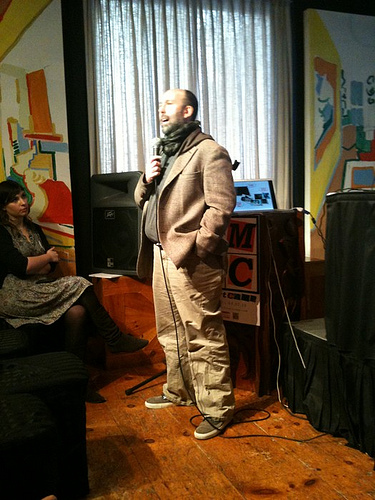
Mark Schiller’s keynote opened the Saturday session. Well-known in the New York arts community, Schiller is the founder of The Wooster Collective, a public arts site that documents street art from around the world. Like many successful online projects, Wooster Collective began accidentally. Out walking his dog in his downtown neighborhood, Schiller began photographing street art, which he then posted online, forwarding the link to friends, and asking for their reactions. Soon his web page was managing hundreds of photos, receiving thousands of hits per day, and turning artists into online celebrities. Two Wooster Collective discoveries that have gone viral are Josh Harris, famous for his subway grate inflatable dog, and Jan Vorman, an artist who uses Lego bricks to patch crumbling city walls. Today, after eight years of posts, The Wooster Collective is the online authority on street art. Schiller receives a self-sustaining five hundred emails a day from artists who have done work, or have seen work, and would like to contribute. Wooster Collective also has a YouTube channel and a Twitter feed.
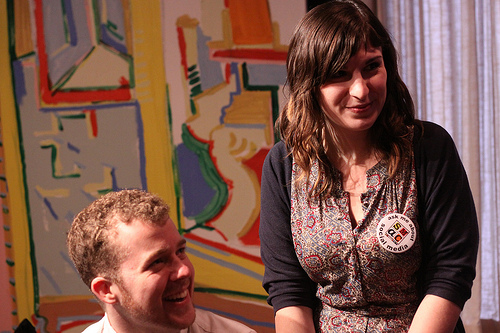
In many ways Wooster’s success seems unpredictable and non-reproducible, a fad, some kind of dumb luck. Yet, in retrospect, Schiller is able to point out specific qualities that made the site popular. First, there was page rank. Since no one was writing about street art in any other media, Wooster Collective’s art tags quickly went to the top of the search engine indexes. This kind of self-reinforcing rank allowed Schiller’s blog to get more traffic and, consequently, to pull more traffic from user searches. Second, ninety percent of the content on The Wooster Collective was original, making Schiller’s blog a feeder for other arts pages, increasing its incoming links and, again, boosting its reputation and its rank. Third, there are no ads at all on the Wooster site per se, mostly, Schiller says, because ads would be distracting both for him and his followers. Free from ads, Wooster Collective has no traffic stats to maintain, meaning Schiller is free to indulge himself in what his readers like best, Wooster’s own weird personality. On most days the site wavers slightly between media outlet and community bulletin board.
However, as important as his community may be, Schiller explained that Wooster readers are actually heavily restricted. The community is largely passive. Readers can email, but they can’t comment, upload, or see who else is online. Although some of site is user generated content, sites built on user content are notoriously second-hand and boring, so reader contributions are very heavily curated. The result is a blog that remains personal and interesting to all. Schiller also says audience building on the Wooster site has always been secondary to his main mission of sharing a passion for street art. According to Schiller, that passion is what works online and the effort to express it means a willingness to try anything. After all, Schiller reasons, “if you don’t like it, you can always stop. If a projects takes more than ten minutes to finish, stop. If it’s not fun, stop. If it’s not inspiring, stop.” Finding podcasts “not fun”, The Wooster Collective recently quit making them. They quit making mobile apps too. Schiller suspects that it is the resulting cheerfulness, lack of strain, exuberance, or even silliness, that connects an audience to a blog, a pursuit, or to an artist.
For Etsy, an online site where artists sell their work directly, community came first, web presence second. Anda Corrie, manager of Etsy’s Twitter feed, explains that Etsy was started at a time when the DIY arts culture was strong and growing, but artists still had few outlets for what they made. Etsy was one of the first sites to give them that outlet and, for a small commission, the site benefited greatly from its fortunate timing. Still, there is a balance between artist and audience that sustains Etsy and makes it work. In addition to responding to community needs, Corrie notes that the governance of sites like Etsy should be as transparent as possible. She reminds media managers rushing to reach out to remember to build a way for their readers and followers to reach in. Etsy uses a community council model. Councils change monthly, giving suggestions for improvements to the site and its forums. This is a time consuming model to attempt but, like Schiller, Corrie feels media planners who go through the motions without really getting involved are unlikely to succeed.
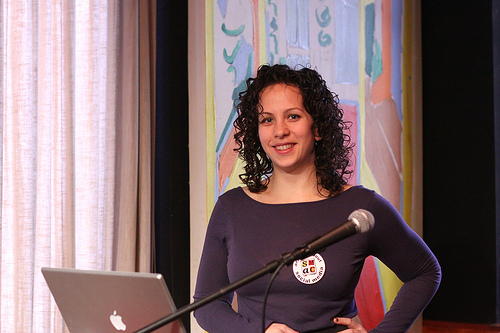
Michelle Shildkret, who represented Cake Group would say that you can’t fake what you are online, just as you can’t hire someone to “make you go viral”. She advises artists to slow down, figure out who to reach out to, where they are online, what they do when they’re online, and how someone might get their attention. When you can answer those questions, you’re ready to approach a social media plan. Shildkret also believes that a small, engaged community may be better than thousands and thousands of disinterested friends. Choose to introduce yourself and your work to places you like, make a difference there first, then advance slowly. John Birdsong of Panman Productions says artists often need to open up in exchange for popular attention. Birdsong endorses the strategy of a behind the scenes look at a studio or art process by posting “making of” videos to UStream or YouTube. These sentiments were echoed by others. Natasha Wescoat, a writer for EBSQ, the self-represented artist’s blog, became obsessed with eBay auctions as a community college student. Wescoat noticed that what honestly attracted her to an artist’s online profile was not necessarily the work. As an audience member, she also wanted personality, a connection, and some sense that there was a real person behind the presentation. Where Schiller describes a community that grows out of a shared passion, Wescoat sees community as a group centered on personality. Like Schiller, she encourages artists to try all ideas, continue with what feels right, and allow a web identity to evolve over time. For example, Wescoat describes her own online identity as an arc with three phases: experimentation, where she tried different approaches to making and selling work; narcissism, where she spent a good deal of time showing how the work was made; and establishment, where the size of her online audience is large enough to attract commissions from corporations and collectors.
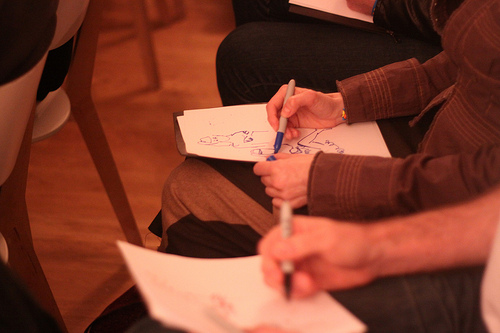
Sharpie sketch queen and self-described “art school drop out” Molly Crabapple credits her web personality as fundamental to a full-time practice that draws commissions from the New York Times and Marvel Comics. Founder of Dr. Sketchy’s Anti-Art School, Crabapple introduced her online persona by compulsively posting to LiveJournal. Today, her favorite platform is Twitter and her media tool of choice is the one hundred and forty character tweet. Crabapple likes Twitter’s immediacy and tweets to get illustration suggestions from her followers, to find emergency crash spaces, and to “manifest” anything. She advises underrepresented artists to do whatever it takes to build a following online: friend friends of friends, promise to perform humiliating stunts for your followers, tweet about everything you do, reward your one hundredth or one thousandth follower with some kind of gift, a sketch or drawing, for instance. When the earthquake struck Haiti, Crabapple tweeted for drawing suggestions, drew those suggestions live online, then auctioned those drawings off in a benefit for Doctors without Borders. Yancey Strickler who co-founded the microfunding platform Kickstarter goes a step further. Kickstarter allows artists to post projects online and request small funding pledges from their followers. These pledges remain virtual until the project pledges reach full funding. At that point, sponsors pay up, the project is funded, and Kickstarter receives five percent of the amount raised. But pledge money is not always a reflection of your project pitch, Strickler points out, saying that what succeeds online is a good narrative and a connection with the audience that feels authentic. According to Strickler, people on Kickstarter are only somewhat concerned with the quality or originality of the work in front of them. More often, their decision to contribute to an artist’s goal proceeds along the lines of questions like “Do I like this person?” or “Could I be friends with this person?”.
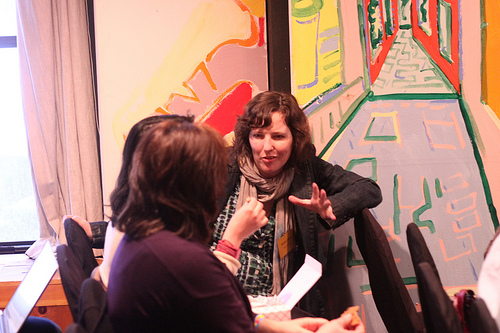
If all this sounds a bit disingenuous or self-serving, remember that social media connects artists and audiences directly and that this connection now has its own considerations. There are some dangers in its manipulation, but the benefits need to be recognized. Adam Smith of Dance Theater Workshop’s and the New York branch of the Neo-Futurists uses blogging and community choreography as forms of outreach. While there are no hard numbers for increases in audience through the blog, DTW’s paid audience has gone from sixty to eighty percent of the house. Working on getting the tools right isn’t necessarily a negative and will probably take some work. Dancer Lisa Niedermeyer says: “You can’t just be clever, you have to be smart, and that none of this has been around long enough for any of us to be wise (yet). That any one experiment can be clever, and with speed and easy access can go live, but it takes being smart for it to be sustainable.”
Niedermeyer works on Virtual Pillow, the tech initiative of Jacob’s Pillow Dance. In some ways Niedermeyer considers the company’s online presence a fourth stage: “A global, interactive space serving a virtual community that might not ever be able to physically visit us in the Berkshires of Massachusetts, but highly value our archives, performances, professional school, creative development residency programs, etc.”
A second part of Virtual Pillow’s mission is to bring the work of the company, including its history, to a wider audience via social media, streaming sites, or any other online platform. Niedermeyer attended SMartCAMP for the chance to hear other institutions and artists discuss what worked and what did not. She says the conference gave her more perspective on the strategies available to Virtual Pillow: “I felt that the conference speakers and participants were really talking about the big picture, big ideas. Gravity Rail, for example, with their passion to explode open and transform eCommerce models for artists.”
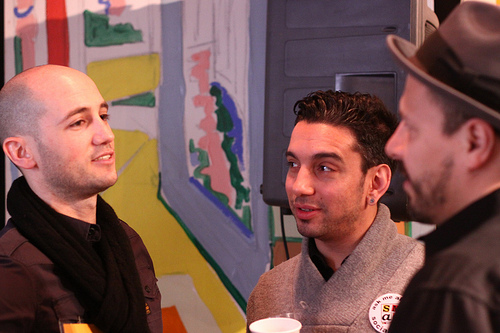
Performers are not alone in the need to link up. According to Nancy Proctor, the museum is a distributed network whether curators accept that idea or not, and agile use of social media is essential to responsive curation. Proctor heads New Media at the Smithsonian American Art Museum, a museum which now gets more visitors online than in person. Are those online visitors any less real? Should their visit be any less satisfying? Should their use of the museum be any less respected? Noting that desktop activities are increasingly moving to the mobile web, Proctor urges curators to meet visitors where they are through sms, tweets, and mobile applications.
Examples of another kind of user centered curation came from Titus Bicknell, founder of pinkink, who believes audiences and their questions now lie at the center of any program strategy. Bicknell’s examples of user centered curation included a podcast that asks visitors to enter a space, look at the art, and record any questions they might have. In this curation model, socially aware programmers ask audiences what they would like to know, rather than telling audiences what it is believed they should know. Allegra Burnette, Creative Director of Digital Media at MoMA, pointed out excellence in web presence like the Indianapolis Museum of Art’s fine arts blog ArtBabble, but added that MoMA uses Twitter feeds specifically to talk about current exhibitions at home and elsewhere. MOMA also offers podcasts on iTunesU where, Burnette says, downloads have increased about ten times this year. More and more, curation extends beyond the exhibit to the conversation about that exhibition, a conversation that defines your institution on the social web through bookmarking, favoriting, collecting, sharing, recommending, and searching. Like the Wooster Collective’s Schiller, Burnett advises media managers to avoid blatant marketing and to discuss events of interest to readers whether those events are part of a home exhibition or are occurring elsewhere.

Even in competition with Arts Week, SMartCAMP sold out. In addition to a long list of good speakers, there was a great deal of conversation and connection going on across the seats, in the halls, throughout the lobby and meeting rooms, and at the bar. Absolutely no one was asked to turn off a cell phone. Executive producer Matt Semler says: “We trended on Twitter both days and ended up with 120,000 individual views on UStream. The audience was very nicely mixed. While we don’t have any specific data on demographics my impression was that the room was evenly split between art executives and artists.”
In April, Semler and Roger Smith Arts will present a cello performance by Peter Gregson from within a Morgan O’Hara installation inside The LAB gallery space in New York. As Gregson plays, O’Hara will perform one of her “Live Transmissions” of Peter’s performance. The event will be streamed live over UStream and, as with all LAB performances, will be viewable from the street as well.
A collaborative review by Marcello Lussana and Gaia Novati
The article features artwork, projects and conference highlights from individuals and groups/organisations such as Honor Harger, Gebhard Sengmuller, Franz Buchinger, Ryoji Ikeda, Julian Oliver, Damian Stewart, Clara Boj, Diego Diaz, Ken Rinaldo, Michell Teran, Aaron Koblin, Daniel Massey, F.A.T, Warren Neidich, Kahaimzon Michel, Bruce Sterling, I-Wei Li, Steve Lambert Matteo Pasquinelli and more…

This year’s Transmediale.10 Festival explores the theme ‘future’ through connections between arts and technology. A part of the introduction read “Futurity is a concept that examines what the ‘future’ as a conditional and creative enterprise can be. At its heart lays the intricate need to counter political and economic turmoil with visionary futures. […] what roles internet evolution, global network practice, open source methodologies, sustainable design and mobile technology play in forming new cultural, ideological and political templates.”
2010 is a year that has often represented the future in Science Fiction literature, such as Arthur C. Clarke’s 2010: Odyssey Two, and now here we are. A good time to compare how we percieved the future, the past, and assess what is really happening, what we lost and what we have gained, and ‘perhaps’ find better ways to proceed. Art can offer different perspectives, ways of seeing and understanding, revealing our present states of being, sharing alternatives or even new meanings for our futures. This festival allows those visiting and taking part, an opportunity to explore, negotiate possible avenues in understanding together, what all this means.
Most of the Transmediale.10 events and art presentations were hosted at Haus der Kulturen der Welt, the same venue for past editions. The main exhibition Future Obscura, was curated by Honor Harger. A big dark room, a labrynth of exhibits divided up with high black curtains. Presenting different artworks enhanced by their own resonances of light. The concept was to use the actual light-sources from each of the artworks, as a kind of curatorial, installation metaphor. Immediately effecting the visitor’s experience through its overall ambiance, built around the theme or vision of future.
We make our journeys out there in the low light of the future, and return to the bourgeois day and its mass delusion of safety, to report on what we’ve seen. What are any of these ‘utopian dreams’ of ours but defective forms of time-travel? Thomas Pynchon, Against the Day (2006).
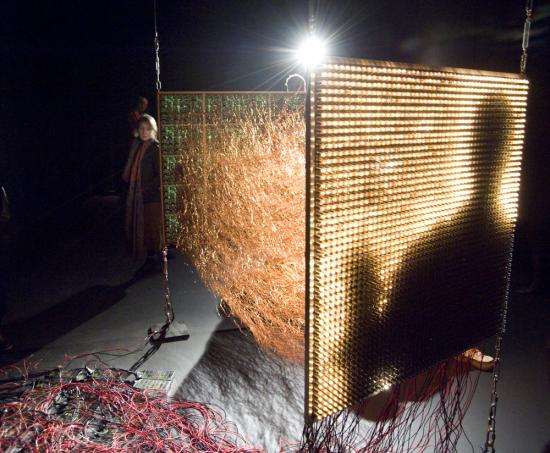
The work Parallel Image by Gebhard Sengmuller, in collaboration with Franz Buchinger, supported by Fels-Multiprint may of inspired the whole concept. An electronic camera obscura and media-archaeological, interactive sculpture. An apparatus for presenting different possible fictions, futures. “Unlike conventional electronic image transmission procedures, “A Parallel Image” is technologically completely transparent, conveying to the viewer a correspondence between real world and transmission that can be sensually experienced.” It presents the fiction that the technology of transmitting moving images was not discovered or invented at all – so no electronic pixels, just a camera and a monitor connected by 2,500 cables in order to track the movement of a body or an object.
Whilst weaving through the dark, curtain bound maze, discovering the separated presentations of Future Obscura, or what we can consider playfully here, as the ‘futurity tunnel’. We come across the video-audio installation data.tron, part of the datamatics project by Ryoji Ikeda. A huge screen (about 15 ft high & 40 foot wide) stands in front of visitors on a flat wall-surface. Various projected sets of data – consisiting of databases, computer consoles and white noise move and unfold before your very eyes. Music plays along with the images issuing forth deep hypnotic sensations. Each single pixel is strictly calculated by a mathematical principle and composed from a combination of pure mathematics. Ikeda reuses and deconstructs the data, building it up into a massive art-work, which also becomes an immersive experience. The same concept was used in his live performance at Transmediale.10 ‘Test Pattern’.
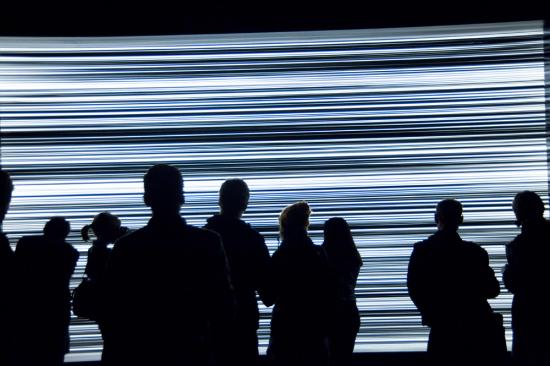
The Artvertiser, a work by Julian Oliver, Damian Stewart, Clara Boj and Diego Diaz, is a tool to swap advertisement with art in public spaces. With a self-made binocular device and dedicated software, you can experience a new metropolitan landscape, replacing the omnipresent adverts which plague our urban environments with art or images of your choice. The swapped, proposed images are often a play on the words of the original advertisement. Whichever image one substituted, the central message of the Artvertiser remains the same; our public city landscapes are bulging with publicity, we want to take that space back and personalize it – quite the same concept of graffiti, but dealing with the reproduction and re-representation of our public spaces. The software running on the device is an open source project and it will soon be available for all to download and use with Smartphones and Standard Camera phones. The Artvertiser points out a thoughtful and critical view point of our present, proposing an alternative future directly linked to our everyday lives. Ironically, this is a theme that is unfortunately scarce or missing in most of the selected Transmediale.10 works.
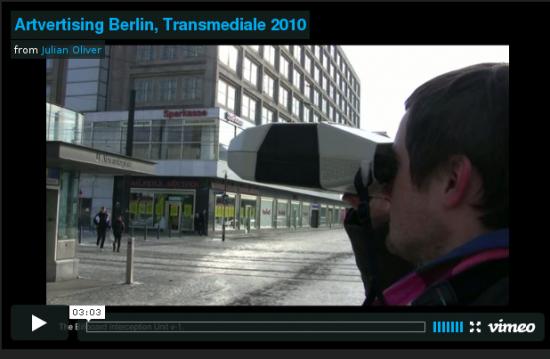
The work Paparazzi Botsby Ken Rinaldo, consisting of a series of autonomous robots. Each of them upright, the height of the average human. Packed with lens-based hardware, such as “cameras, sensors and robotic actuators on a custom-built rolling platform, they move at the speed of a walking human, avoiding walls and obstacles while using infrared sensors to move toward humans.” Capturing images of the visitors as though they were celebrities, flashes go off, then the images are projected up onto the surrounding walls. A popular installation reflecting on the abuse of reproduction and exhibition: some of the images were also uploaded and then distributed through social networking sites – a mass mediatic celebration of the visitors as well as the celebration of the bots.
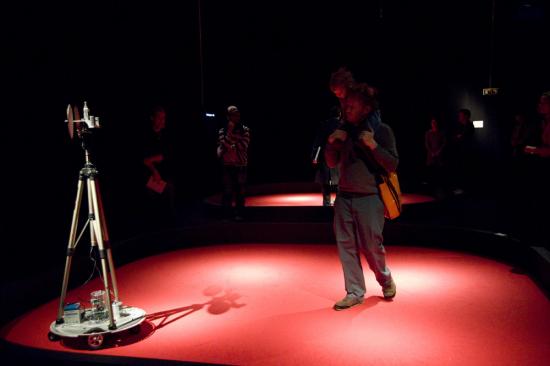
The selection of Transmediale.10 seems to award reproduction of content rather than consciousness of a different form of creativity. Also, the main prize is unexpectedly given to a woman, Michell Teran, with the project Buscando al Sr. Goodbar: a real tour through Murcia, a Spanish town, taking place at the same time on Google Earth and YouTube, an interaction between reality and social media. The work was presented at Transmediale.10 as a video remix of the original work. “The tour audience was introduced to everyday performances and actions happening in the city that often go unnoticed. Somebody solves a Rubik’s Cube in under 2 minutes, a young man plays a piano, a group of friends drunkenly sing together, a 14 year old boy headbangs in his bedroom, somebody is choked, a man teaches himself Arabic and two people fall in love. At certain points the audience left the bus and met some of the video authors who presented them with re-enactments of their performances.”
In the same way the second prize was awarded to the project Bicycle Built For Two Thousand by Aaron Koblin and Daniel Massey. A web-based, software able to record people repeating what they heard, then they used these voices to make a reconstructed version of the song Daisy Bell – the first song that implemented musical speech synthesis in the 1962.
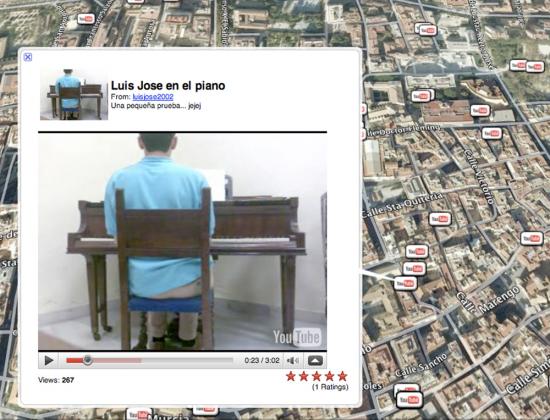
Speaking about the difference between re-production and creation, it is interesting to notice that the group F.A.T were present at the awards. Using intentionally, and excessively open source and pop culture as way of expressing their creative actvities, claiming and distributing activist propoganda-like projects, on networked territories and facilities (facebook/google ndr.) in order to stress out the holes of content present in the Web2.0 culture. For Transmediale.10, they presented a series of projects dedicated to the topic of the week: FUCK GOOGLE. In addition to free software, browser addons, live streams, communiques and on-site workshops, they also built a fake Google Street View car and toured it in the city of Berlin.
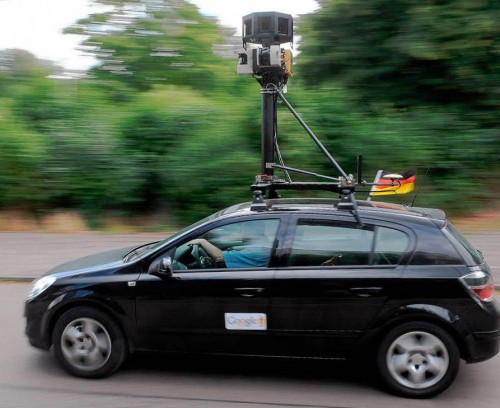
A more singular approach, which revealed different or other connections of a network is shown in Neuropower, by the biologist and artist Warren Neidich who won The Vilem Flusser Theory Award 2010: he researched new ways to manipulate the process of ongoing cerebral reconstruction. Exploring the potential of Neuroaesthetics, formulated in the mid-1990s “as a paradigm capable of describing the complex conditions of the ‘now’-a moment in which global technological networks and novel potentialities for subjectivity are coming into greater focus and correlation to each other. As knowledge becomes ever more commodified, and labor increasingly immaterial, our notions of art, work, and politics…”
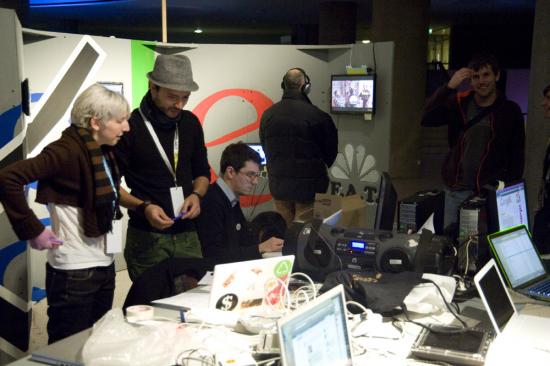
The gap between what could be the future or what we are imagining through the mass-media industry and the challenge that artists and creative thinkers are asked to face, is not really elaborated. A good example is the conference Phuturama: a space dedicated to the possible alternatives of an ‘imaginary’ for the future. One of the guests was Kahaimzon Michel: his description of the new version of Far Cray was mostly focused on the technical improvement of the game and no word at all was spent on the idea, the concept itself: the umpteenth war-games, colonialist and male-centered. The celebration of technology itself was the splitting point of this Festival, as it was somehow already announced at the opening day by Dr. Franke. His main contribution seemded to be about the importance of ‘Avatar’ the movie, for its big technological improvements.
Going back to the events, one of the most awaited speeches was Bruce Sterling’s keynote speech “Atemporality – A cultural speed control” about time and its relation to ‘future’. The main introduction text for Atemporality – A cultural speed control read “The speed of our society is constantly increasing in terms of processes, logistics and media, causing the present to ‘shrink’. We are experiencing the dissolution of meaningful frameworks in a similar way as Henry DeTamble: in politics, the intervals of planning and acting are reduced to the duration of a legislative period and in post-industrial economics volatile unpredictability has come to replace regular traits of growth and stability. Progress as the paradigm of modernity has been replaced by the continuous modulation of events. If progress is to go beyond the banal indulgences that give rise to a never-ending array of car shell designs then we need to analyse our present time with regard to its aesthetics and its media. The structure of the future has changed, and with it our sense of time. Are we running out of a future as a resource for growth, progress and stability? Has our cultural cruise control become defective?”
Reflecting on the proposed theme, Sterling presented Atemporality as he viewed it, an approach in understanding and recontextualizing history, “an effort in humanities” to embrace reality, the now.
“Step one – write problem in a search engine, see if somebody else has solved it already.
Step two – write problem in my blog; study the commentory cross-linked to other guys.
Step three – write my problem in Twitter in a hundred and forty characters. See if I can get it that small. See if it gets retweeted.
Step four – open source the problem; supply some instructables to get me as far as I’ve been able to get, see if the community takes it any further.
Step five – start a Ning social network about my problem, name the network after my problem, see if anybody accumulates around my problem.
Step six – make a video of my problem. Youtube my video, see if it spreads virally, see if any media convergence accumulates around my problem.
Step seven – create a design fiction that pretends that my problem has already been solved. Create some gadget or application or product that has some relevance to my problem and see if anybody builds it.
Step eight – exacerbate or intensify my problem with a work of interventionist tactical media. And step nine – find some kind of pretty illustrations from the Flickr ‘Looking into the Past’ photo pool.” Sterling.
The philosophy of history studies, an objective point of view, a map that does not always reflect the real. Atemporality instead, has to be a “calm pragmatic skepticism about the historical narrative” like telling stories of people who were not the winners, report history that has no literacy or playing fiction into reality, being a “personal public testimony of a future that doesn’t exist”.
“Atemporality is a philosophy of history with a built-in expiration date. It has a built in expiration date. It’s not going to last forever. It’s not a perfect explanation, it’s a contingent explanation for contingent times.
Futurity was expected, futurity is here now, there goes futurity into the past, so long futurity, thank you for an exciting, fulfilling and worthwhile time.” Sterling.
The Atemporal approach asks us to cool things down, challenge the need and desire for a constant, linear future. Proposing not to rush ever onwards, remembering what we have now, reclaiming and rediscovering the qualities we possess rather than feverishly running forward all of the time. You can read Bruce Sterling’s whole speech here – Atemporality for the Creative Artist
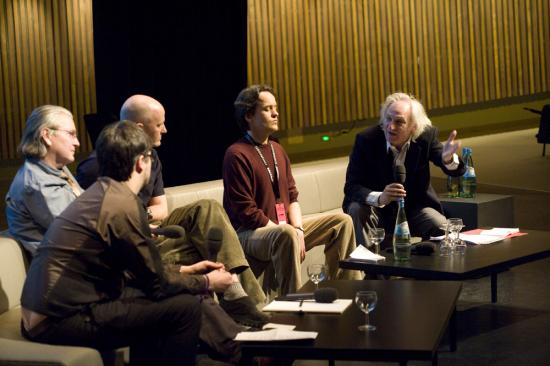
A subject which played a central role for much of the discussions held, was related to the economy and how it addresses the creative work (a third of the speeches were about this topic). The financial crisis had also influenced much of the artistic agenda. Unfortunately all this talking about commerce was often presented without critical reasoning, and so we had a lot of showing off and gesturing about how amazing certain new technologies were. Which gave off a more bland sense of enthusiastism, a technologically determined, already accepted future, without the necessary awareness of the overall social contexts of what it all really means. Yet there were some projects that tried to propose a different view on this theme. The performance Values, by I-Wei Li, pretended to calculate, with the help of a computer, the value (artistic-value) of the participant, based around questions on art and art practice. The Laboratoire Deberlinisation uses an uncommon way to discuss about immigration and value in our globalized world, with the provocative use of an African value, the Afro, an international insurance card and passport.
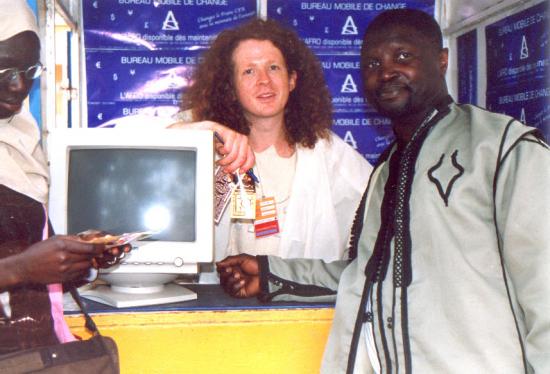
A deep critical, discussion of the current socio-economical situation produced by the international financial crisis, was held in the main auditorium, Liquid democracies. Steve Lambert presented his works and talked about direct politics, re-using our culture and how to subvert it. In his opinion, utopia has to be used as a direction and not as a destination, living moments of freedom: an alternative approach for direct, political change, using small actions and persistence, participating tactically through our cultures. Matteo Pasquinelli later focuses attention on the whole of net society and the digital matrix. He wondered who has the strongest power, who detains the monopolies and which place is dedicated to the workers and specifically to the cognitive (creative) workers? Pasquinelli used the concept of a “new feudalism” to define contemporary societies. The multitude is not fluid but embroils in a participatory process that traps it in-between the oligarchy of the big companies. Democracy in this sense has ended and gives the go-ahead to a post feudalistic society. The end of this construction is an open question: is there any subject able to break the power of these big monopolies?
Parallel to Transmediale festival is Club Transmediale Festival CTM a music and visual arts event held every year in Berlin. The festival started as the musical side of Transmediale and then added more and more interests involving the arts. Through the years it has become more popular and expanded, not just with music during the night, but also with their own exhibitions, talks and lectures during the day. This year the event was even longer than Transmediale itself, starting from January 28th and ending February 7th 2010, with the subject “OVERLAP – Sound & Other Media” giving a lot of attention to the relationship between music and videogames.
A missing element worthy of attention at Transmediale.10 this year, was its audience. Even though the amount of visitors were three times more than last year. The time for questions and discussion with the public was often too short, or ineffective. A contemporary approach in acknowledging the audience would be to understand there is not a clean divide anymore. And even though the old protocols still count in some cases, its representation at the festival was not necessarily a true reflection of the nature of networked, contemporary art and its culture. A hidden and dynamic audience which could have offered their own ‘valid’ interpretations around the subject was lost. Yet, on the whole the festival was extremely interesting in many ways, and had some excellent works and discussions well worth experiencing.
Mark Napier’s Venus 2.0
Angela Ferraiolo
February 5, 2010
“Now that I’m done’ I find the artwork disturbing. It freaks me out. Maybe I’ll do landscapes for a while to detox.” — Mark Napier
Artist Mark Napier, well-known for the net classics Shredder, Riot, and Digital Landfill, recently exhibited his latest work Venus 2.0 at the DAM Gallery in Berlin. A sort of portrait via data collection Venus 2.0 uses a software program to cross the web and collect various images of the American television star Pamela Anderson. These images are then broken up, sorted by body parts put back together and — as this inventory of fragments cycles onscreen, a leg, a leg another leg — the progressive offset of each rendering of Anderson’s head, arms, and torso makes her reconstructed figure twist, turn and jerk like a puppet. It’s odd looking. Even her creator is a little afraid of her:
“I have to say’ if I ever meet Pamela Anderson in real life I think I’ll completely freak out and run away. I don’t think I could have a conversation with the woman after this project … I started with a sympathetic view of the actual Pamela Anderson. She is part of the spectacle of sexuality in contemporary media. She’s caught in that ‘desiring machine’ as much as any other human’ probably even more so. She has surgically modified her body in order to have greater leverage in the media. Does this put her in control? I think not.”
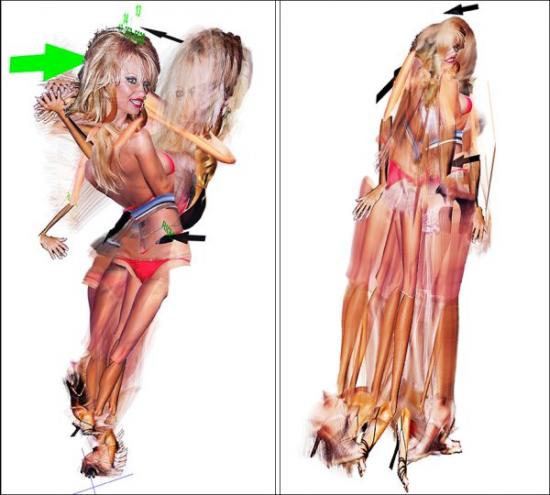
Napier’s project doesn’t answer or intend to answer the question of who is in control either, but it plays with the possibilities. Although I wasn’t able to see the portrait at its exhibition. I did track down part of the series Pam Standing at a private location here in New York. Napier has also posted video excerpts of the work online. Unfortunately, these still images and clips are a bit too static to really do the piece justice. If you get to see the real thing and if you look for a while, you’ll see what I mean. Venus 2.0 is an amazing jigsaw puzzle, a deceptive surface of shifting layers – part painting and part search result.
The effect is translucent, lyrical, mathematic and creepy. When I implied that it must have taken an awful lot of precision and calculation to get something like this to come together, Napier insisted that focusing on the technology behind Venus 2.0, its algorithm, or even on the unique materiality of networked art in general, is a way of missing the point. The way he relates to Venus 2.0 is through the painter’s hand. What counts is not the data feed, but who were are, what we want and how we behave:
“The artwork is a riff on sexuality as an elaborate hoax played by a precocious molecule that builds insanely complex sculptures out of protein, aka, meat puppets or more simply, ‘us’. These animate shells follow a script that’s written and refined over the past half billion years. And that script is in a nutshell: 1) survive 2) reproduce 3) goto #1. So sexual attraction is the carrot to DNA’s stick. Attraction is part of the machine. In art history this appears as the tradition of Venus. And more recently: Duchamp’s ‘Bride’. Magritte’s ‘Assasin’. Warhol’s ‘Marilyn’. The focus of digital art is still the human being. Don’t be distracted by the gadgets.”
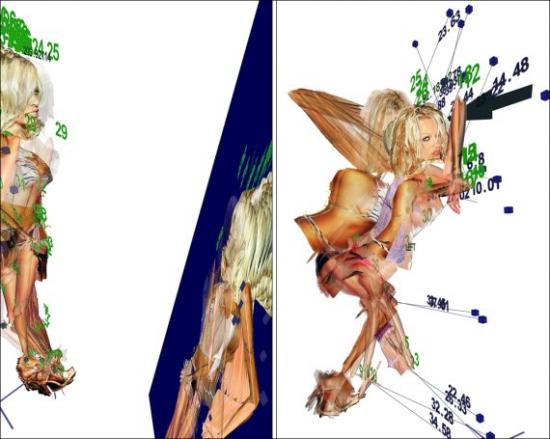
Hi-tech or not, new media artists are by now well-practiced in the technique of unraveling a familiar image to expose an occluded, yet equally valid identity. In Distorted Barbie, Napier relied on a repeated process of digital degradation to blur both the literal and conceptual fiction of the Mattel franchise. Another early project stolen, took the female body apart, presenting attraction as database. Years later these kind of approaches, pixel manipulations and indexing without comment, as well as parsing and remixing have become a sort of standard operating procedure in new media. So much so that as technique becomes more well-known and more accessible, it can be hard to tell one work from another or one artist from the next. With this in mind’ it seems important to note that in the case of Venus 2.0 it is not so much a choice of subject or an organizational scheme that guarantees the final effect, but the manner in which Napier investigates the image and the ways in which Napier illustrates and manipulates both the visual elements of portraiture and his relationship to the figure involved.
Napier builds and destructs, assembles and tears apart, but in doing so tries his best to keep us focused on these activities as processes. At times Pam’s contortions are allowed to expose the wireframe which allegedly guides her construction and at certain key points on the interface, there is also a steady stream of vector coordinates to embody the idea of data. But Napier makes less of technology than another artist might by effacing what some would tend to elaborate on, in order to draw our attention elsewhere – usually towards evolution, gradation and the ways in which images evolve, and by extension the ideas that inspire those images which reflect how unstable elements are, even treacherous:
“I work at probabilities: what is the likelihood that the figure will be totally opaque? How often does it get murky and undefined? How often should I let that happen and for how long? How often does the figure jump? How long till the figure lands and stands up again? How much time is spent in chaotic motion and how much in stillness? How often does something completely messy happen? Like the figure gets tangled up in a ball that has no structure. I don’t know how the piece will play out each minute, but I know what kind of situations will arise in the piece. I can plan those likelihood, and then let the piece play and see what it does.”
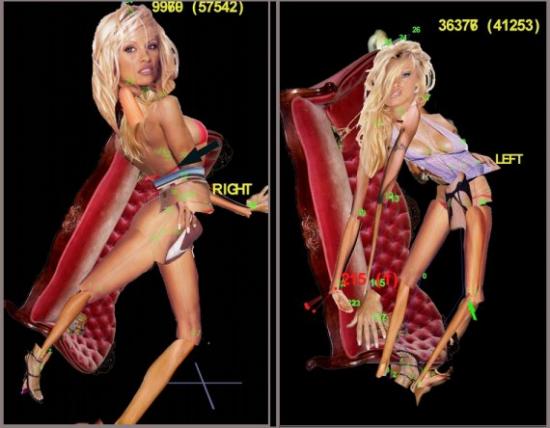
So, like the woman who inspired her. Pam Standing is beautiful, but more unsettling. What makes Pamela Anderson the most frequently mentioned woman on the Internet? Why do we mention her? What is it we want when we give our gaze to celebrity? What has celebrity done to attract us? Whatever your answers, what Napier privileges in his response is not a fixed portrait of a star, but a cloud of iteration that produces its own image and reproduces that image, jangled, confused and full of surprises. A portrait whose finest moments are accidental and whose design is an accumulation of fragments that tense and dissolve, floating like clouds one instant and then sinking like lead the next. This is where the imagination takes a step forward and Napier the artist or Napier the geek becomes Napier the puppetmaster, a networked Dr. Coppelious:
“My favorite moment with the PAM series was when I finally got all the math to work so that the body part images displayed correctly and the correct side of the body showed at the right time and the stick figure suddenly started to look like a ‘real’ puppet that was starting to come alive in the golem-esque way that I thought it could when I was sketching out the idea. I had that Dr. Frankenstein moment: ‘She’s aliiiiiiiiiive!!!!!!!!!!!!!’ which was really the point all along, to create this virtual golem that is clearly not alive at all and yet teases us all with this false appearance of life. Venus 2.0.”
Until the layers of arms, legs, breasts and hips collapse in on themselves and Pam is back where she started, a manipulated beauty unable to escape presentation as a collaged monstrosity.
Note: Mark Napier has been creating network art since 1995. One of the earliest artists to deal thematically and formally with the Internet, Napier has been commissioned to create net art by the Solomon R. Guggenheim Museum and the San Francisco Museum of Modern Art. His work has appeared at the Centre Pompidou in Paris’ P.S.1 New York’ the Walker Art Center in Minneapolis’ Ars Electronica in Linz’ The Kitchen’ Kunstlerhaus Vienna’ ZKM Karlsruhe’ Transmediale’ iMAL Brussels’ Eyebeam’ the Princeton Art Museum’ la Villette’ Paris’ and at the DAM Gallery in Berlin.
Arriving at the homepage of Ten Thousand Cents, an Internet artwork by Aaron Koblin and Takashi Kawashima, a mottled image of a one hundred dollar bill slowly fades into view. Ben Franklin looks out sedately. Mousing over the large image, the cursor is replaced with a small red rectangle. And here lays the beauty of the project; with the click of each rectangle, a zoomed in portion of the one hundred dollar bill is revealed. On the left side is a high-resolution photograph of that tiny portion of the bill. On the right side, a real-time moving image plays, revealing how the image was drawn by a human hand in a drawing program created by Koblin and Kawashima. There are, in fact, 10,000 such rectangles and each was created by a Turker through Amazon’s Mechanical Turk marketplace.
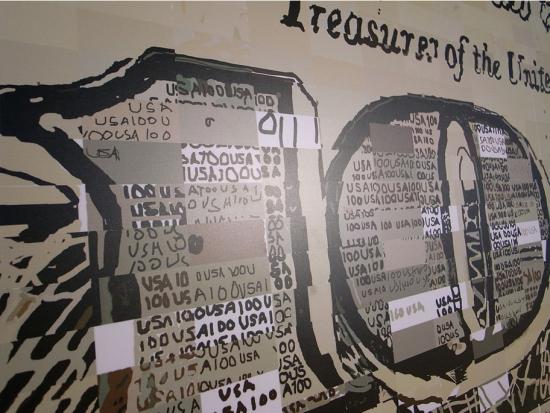
Over the course of five months (from November 2007 to March 2008) Koblin and Kawashima posted tasks, known as HITs, Human Intelligence Tasks, on Amazon’s Mechanical Turk site. Having broken down an image of a one hundred dollar bill into 10,000 sections, Turkers were tasked with redrawing their assigned section. Each Turker was paid $.01 for the task, making the total payment of drawing a one hundred dollar bill one hundred dollars. (Prints of the project can also be bought for one hundred dollars. All proceeds are donated to the One Laptop per Child (OLPC) project) Each Turker worked anonymously, unaware that what they were drawing was a section of a bill or that their work would eventually be combined with other Turkers’ work to create an art project. The variability is endless. Some Turkers methodically draw in the lines and painstakingly shade in boxes. Some quickly slash the paint tool across the page; one imagines they felt they had better things to do with their time. Some are cheeky, using the space for digital graffiti or messages like “I love U.” Most copy the image exactly. Yet, with the differing movements and tempos, every one suggests a different story and different person behind the tool. I suggest you take a few minutes and watch the unfolding scenes. They are oddly, satisfyingly banal and beautiful.
The project and its presentation on the website are undoubtedly elegant. Yet, the conceptual work behind the piece is a bit murkier. The project description states, “The project explores the circumstances we live in, a new and uncharted combination of digital labor markets, ‘crowdsourcing,’ ‘virtual economies,’ and digital reproduction.” Big and important themes. What are the implications of crowd-sourcing for creative work? For any kind of paid work? Where is the distinction between work and play? Creativity and re-presentation? In this deeply networked age, what are the evolving relations between individual and collective action?
The Mechanical Turk, made by Wolfgang de Kempelen in 1769, caused a sensation in 18th and 19th century Europe, first for its existence as a seemingly intelligent chess playing automaton – one who could beat Ben Franklin and even Napoleon in chess – and subsequently, for being an infamous hoax. Inside of the automaton was in fact a man, a skilled chess player. The Mechanical Turk was no thinking machine. It was an elaborate performance of concealment and human skill.

In 2005, in an ironic (and some might say distasteful) turn of events, Jeff Bezos of Amazon named a new business venture, Amazon Mechanical Turk. The idea was to make a digital marketplace that capitalized on the unique intelligence of human agents. Broken down into microtasks, known as HITs, Mechanical Turk provides a means to accomplish those tasks that humans can do quickly but which would take computers much longer to do, for instance, tagging images, taking surveys or transcribing audio recordings. This Mechanical Turk is also a performance of human skill, one that revels in its basis in human intelligence – Bezos calls it “artificial artificial intelligence” – but one that also operates within a mode of concealment and indeed, alienation.
As Katharine Mieszkowski of Salon wrote about Mechanical Turk in 2006, “There is something a little disturbing about a billionaire like Bezos dreaming up new ways to get ordinary folk to do work for him for pennies.” Critics of Mechanical Turk abound, and their objections point to the insidious labor relations that Mechanical Turk enforces, implying that Mechanical Turk approaches a virtual sweatshop. The system was designed for employers, not employees. The earnings of Turkers fall within a gray area of digital labor, officially being classified as contractor work, subject to high self-employment taxes and no option for benefits. Although a rating system protects employers, in so far as employers can choose to reject a work offer from a Turker or refuse to pay a Turker if the work is completed unsatisfactorily, no such system protects Turkers. As advocates of a Turker Bill of Rights have pointed out, there is no effective outlet within Mechanical Turk for Turkers to voice grievances against employers. What does exist is a vibrant community forum, Turker Nation, where Turkers advise each other on known scammers.
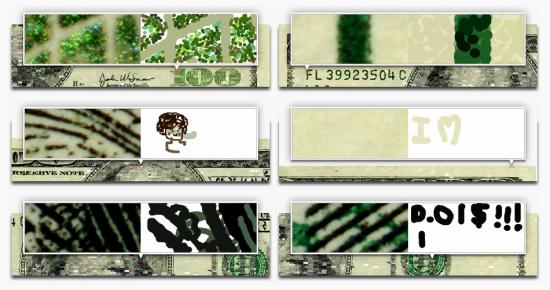
Moreover, although anecdotally Mechanical Turk is understood as more game or past-time than employment, a recent study out of University of California, Irvine’s Informatics Department points out that almost a third of Turkers rely on Mechanical Turk as a source of income. Another study found that nearly half of Turkers report their motivation for working as income related. For this population of Turkers, it is troubling to consider the possibilities of exploitation and unfair labor practices.
In this light, I find the artists’ neat appropriation of the mechanisms of Mechanical Turk unsettling. The implications and the stakes of Mechanical Turk as an economic system are left untouched. And considering that the artists chose to create a representation of money and employ Turkers, these dimensions of economy and labor are present but disappointingly unaddressed.
Yet, the moments in the project that remain in my mind’s eye like lovely specters as I glance at the dollar bill that I traded for coffee this morning, are the movements of the individuals who drew each section. On this level, the project is like a fantastic cabinet in which each drawer opens onto a new wonder. Perhaps what Ten Thousand Cents effectively offers is not a statement about labor politics or late capitalism’s continuing ability to provide structures for domination and exploitation. Perhaps Ten Thousand Cents asks us to take a different step toward understanding “the circumstances we live in,” revealing the endless variability of individual expression. In this networked age, we often act collectively, that is, together, parallel, most often without knowledge of the larger directions toward which our actions will lead. Collaboration, laboring together, is notion whose meaning is expanding and changing in the 21st century. What remains, even among protocols and code, is individuality. Though we are subsumed by larger structures, we do have spaces for self-expression and self-formulation. Leave an exploration of the limits of these spaces to others – and I surely believe we must consider the limitations. Yet we must also explore and value the spaces of possibility and the domains where we are active agents. We are called to remember that every artifact is irreducible to its mere instance in the world – it is a sum of processes and individual actions.
Of course, “the circumstances we live in” also requires us to keep in mind the bottom line. It’s all about the Benjamins, as the phrase goes. In response to a HIT, no less, requesting an answer to the question, “Why do you complete tasks in Mechanical Turk” one Turker wrote, “I do it for the money!”